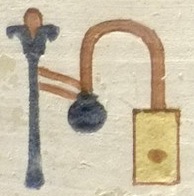



The Egyptian male figure is particularly well represented in the hieroglyphic canon. Group A in Gardiner’s list (EG 544) contains fifty-eight signs to which I have added five signs encountered during the recording of data. Of these sixty-three signs, thirty-three (52%) possess occurrences in the database, but only three are relatively frequent. The seated god A40 has nineteen occurrences, the seated man A1 has eleven and the seated man with hand to mouth A2 has nine. Fifteen signs have only one occurrence. Despite this lack of frequency, there is high consistency in the iconography and in the use of polychromy. Almost all of the occurrences of common men show the male figure as a bare chested, red skinned individual with black hair, wearing a white kilt.
This basic iconography of the squatting pose with red skin and white kilt can be traced back to the wall painting in tomb 100 at Hierakonpolis (Nekhen) which dates from the Late Gerzean period c. 3500 BC (Tiradritti 2008, 90-91). In the centre of the lower register can be seen three squatting figures with red skin and white kilts. The limbs are positioned in the same way as in sign A1 and all three figures face to the right as in the majority of hieroglyphic inscriptions. To their left are two scenes of hand-to-hand combat between a dark red figure and a paler figure. This distinction of colour may be one of rank or one of ethnicity. The costume of the pale figure has been interpreted as that of a priest (Tiradritti 2008, 92). In fact this combat could be a symbol of the supposed struggle between the darker-skinned Upper Egyptians and the paler-skinned Lower Egyptians. However, in one image, the paler figure has vanquished the darker one, as opposed to the traditional view of a victory of Upper over Lower Egypt. It seems, therefore, more likely to be a combat between Egyptians and other peoples, such as Asiatics or Libyans, both represented in later compositions by pale-skinned individuals.
This distinction between red and yellow skin has given rise to much speculation (Fischer 1963, 17-22; Baines 2007, 246-247; Eaverly 2013). The traditional view (Wilkinson 1994, 115), that men are red and women are yellow due to their daily activities, is too simplistic and too many exceptions can be noted (e.g. Tiradritti 2008, 51; 145). This view claims that men are red because they spend more time outdoors in the sun than paler skinned women who live mostly indoors. Although there is probably some truth in this theory, there are some representations of older men or men in authority that are coloured yellow (Fischer 1963, 17-19). A wall painting from the tomb of Iti at Gebelein, now in Turin (Tiradritti 2008, 144-145), shows a yellow-skinned overseer, with starched white kilt, ordering the butchery of a steer by a group of red-skinned, loincloth-wearing workers. However, these subtle distinctions are of lesser importance as far as hieroglyphs are concerned. Virtually all men in Group A are red (with some exceptions for occurrences of A20 an old man leaning on a forked stick). It is probably safe to say that the standard red skin colour of Group A signs symbolises the active (Egyptian) male principle, as opposed to the passive female principle symbolised by yellow skin (see the commentary on Group B). As is often the case, the wall painting canon has thus been carried over into the domain of polychrome hieroglyphs.
Surprisingly, the seated god A40 has red skin like ordinary mortal men, rather than the golden yellow colour that might be expected for a god (except for one occurrence that has yellow skin). Until Dynasty XIX, the god’s robe is white, but from this time onward, it can be coloured red, green, yellow or blue. The long hair or wig of the god is dark blue (supposedly lapis lazuli). The many different variants found for the god’s robe have resulted in the inclusion of several exemplars in the palaeography.
Of particular interest in Group A are the signs showing a man holding or carrying objects. A9 shows a man carrying some sort of receptacle on his head, balancing it with one arm. Gardiner (EG 443) has a problem providing a positive identification for this object, as he describes it as the “basket W10”. However, he then describes W10 as a “cup (probably also sometimes a basket)”. The colour of Ex. A9 may provide a clue. The basket, in this case, is too big to be a cup and is also coloured yellow: a colour which is never used for pottery. Other database occurrences of W10 are red (TT.87), white (KV.57) or yellow (Temple of Ramses II at Abydos). Red is a classic colour for pots. White and yellow can indicate stone (alabaster) as seen in Ex. O39 from KV.57 and all the occurrences of W3 . So, when W10 is used as a cup, the colour is red, white or yellow. However, when used as a basket in Ex. A9 it is yellow with red horizontal stripes. This colouring normally indicates something made of wood or wicker-work, not from fresh plant fibre which is green, such as for the baskets V30 and V31. The basket on the head of A9 is therefore probably some kind of wooden or wicker-work hod, used for carrying building material such as bricks or earth. This interpretation is confirmed by the use of the sign as a determinative for words concerning “work”.
A special mention must be made of an exception to the iconography of Group A Egyptian males. The mummy board of Penmaât (Mon.52) shows all the men wearing an additional length of linen slung over their forward shoulder. This could be either an extension of the kilt or else some kind of loose shawl. The portrayal in hieroglyphs of this garment is, as far as I can discover, unique to this monument, certainly in the database corpus. It could, in fact, be a pointer to a later date (Ptolemaic?) than is usually assigned to this object (Nunn 2015a). The same shawl can be found on the god with arms raised C11 from the same monument.


OccID = 1497
Monument : Khonsou-Tefnakht E.586
Monument type : Coffin
Localisation or provenance : El Hibeh
Period : Dynasty XXVII
Reign(s) : ?
Approximate date : 525 - 404
ExemplarID = 14 - statistical relevance rating : *****
Colours used : flesh red, hair and beard black, eye white and black, kilt white with black lines

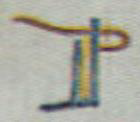
OccID = 3570
Monument : Ramses IV KV.2
Monument type : Royal Tomb
Localisation or provenance : Valley of the Kings
Period : Dynasty XX
Reign(s) : Ramses IV
Approximate date : 1153 - 1147
ExemplarID = 284 - statistical relevance rating : *
Colours used : body blue, arms red, fill yellow


OccID = 1787
Monument : Peftjauneith
Monument type : Coffin
Localisation or provenance : Sais
Period : Dynasty XXVI
Reign(s) : ?
Approximate date : 664 - 525
ExemplarID = 22 - statistical relevance rating : *****
Colours used : hair black, flesh red, kilt white with red pleats and black outline


OccID = 2949
Monument : Userhat TT.56
Monument type : Private Tomb
Localisation or provenance : Sheikh Abd el-Gurna
Period : Dynasty XVIII
Reign(s) : Amenhotep II
Approximate date : 1427 - 1400
ExemplarID = 24 - statistical relevance rating : *
Colours used : flesh red, hair faded (black?), kilt white


OccID = 3129
Monument : Penmaât
Monument type : Mummy board
Localisation or provenance : Sheikh Abd el-Gurna
Period : Dynasty XXII
Reign(s) : Osorkon I - ?
Approximate date : 945 - 715
ExemplarID = 25 - statistical relevance rating : *
Colours used : flesh red, hair black, kilt and shawl white

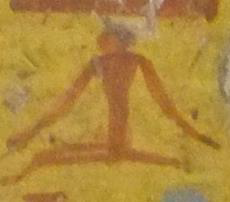
OccID = 2621
Monument : Nefersekheru TT.296
Monument type : Private Tomb
Localisation or provenance : Khokha
Period : Dynasty XIX
Reign(s) : Ramses II
Approximate date : 1279 - 1213
ExemplarID = 56 - statistical relevance rating : *
Colours used : hair blue, body red


OccID = 2112
Monument : Ramses I KV.16
Monument type : Royal Tomb
Localisation or provenance : Valley of the Kings
Period : Dynasty XIX
Reign(s) : Ramses I
Approximate date : 1295 - 1294
ExemplarID = 26 - statistical relevance rating : ***
Colours used : flesh red, kilt white with red pleat lines, hair, beard and eye black


OccID = 2442
Monument : Menna TT.69
Monument type : Private Tomb
Localisation or provenance : Sheikh Abd el-Gurna
Period : Dynasty XVIII
Reign(s) : Thutmose IV
Approximate date : 1400 - 1390
ExemplarID = 54 - statistical relevance rating : ***
Colours used : flesh red, kilt white, hair black, basket yellow with red lines


OccID = 1616
Monument : Tjanuni TT.74
Monument type : Private Tomb
Localisation or provenance : Sheikh Abd el-Gurna
Period : Dynasty XVIII
Reign(s) : Thutmose IV
Approximate date : 1400 - 1390
ExemplarID = 28 - statistical relevance rating : ***
Colours used : body red, hair black, kilt white, bow yellow with white fill, arrows yellow, feather white or yellow


OccID = 3137
Monument : Penmaât
Monument type : Mummy board
Localisation or provenance : Sheikh Abd el-Gurna
Period : Dynasty XXII
Reign(s) : Osorkon I - ?
Approximate date : 945 - 715
ExemplarID = 55 - statistical relevance rating : *
Colours used : flesh red, hair black, kilt and shawl white, blood red


OccID = 1555
Monument : Khonsou-Tefnakht E.586
Monument type : Coffin
Localisation or provenance : El Hibeh
Period : Dynasty XXVII
Reign(s) : ?
Approximate date : 525 - 404
ExemplarID = 29 - statistical relevance rating : *
Colours used : flesh red, hair black, eye black, kilt white with black outline, stick black or blue


OccID = 3633
Monument : Ramses V-VI KV.9
Monument type : Royal Tomb
Localisation or provenance : Valley of the Kings
Period : Dynasty XX
Reign(s) : Ramses V - VI
Approximate date : 1147 - 1136
ExemplarID = 285 - statistical relevance rating : *
Colours used : flesh red, hair black (or blue), robe yellow


OccID = 407
Monument : Benia TT.343
Monument type : Private Tomb
Localisation or provenance : Sheikh Abd el-Gurna
Period : Dynasty XVIII
Reign(s) : Hatshepsut - Amenhotep II
Approximate date : 1473 - 1400
ExemplarID = 286 - statistical relevance rating : ***
Colours used : body red, hair faded (black?)


OccID = 2293
Monument : Rekhmire TT.100
Monument type : Private Tomb
Localisation or provenance : Sheikh Abd el-Gurna
Period : Dynasty XVIII
Reign(s) : Thutmose III - Amenhotep II
Approximate date : 1479 - 1400
ExemplarID = 31 - statistical relevance rating : ***
Colours used : hair black, flesh red, kilt white, stick indistinct


OccID = 2319
Monument : Rekhmire TT.100
Monument type : Private Tomb
Localisation or provenance : Sheikh Abd el-Gurna
Period : Dynasty XVIII
Reign(s) : Thutmose III - Amenhotep II
Approximate date : 1479 - 1400
ExemplarID = 32 - statistical relevance rating : *
Colours used : flesh red, hair black (?, faded), kilt white


OccID = 2320
Monument : Rekhmire TT.100
Monument type : Private Tomb
Localisation or provenance : Sheikh Abd el-Gurna
Period : Dynasty XVIII
Reign(s) : Thutmose III - Amenhotep II
Approximate date : 1479 - 1400
ExemplarID = 33 - statistical relevance rating : *
Colours used : flesh red, kilt white, stick and hair faded

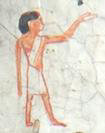
OccID = 3131
Monument : Penmaât
Monument type : Mummy board
Localisation or provenance : Sheikh Abd el-Gurna
Period : Dynasty XXII
Reign(s) : Osorkon I - ?
Approximate date : 945 - 715
ExemplarID = 34 - statistical relevance rating : ***
Colours used : flesh red, hair black, kilt and shawl white


OccID = 3883
Monument : Rekhmire TT.100
Monument type : Private Tomb
Localisation or provenance : Sheikh Abd el-Gurna
Period : Dynasty XVIII
Reign(s) : Thutmose III - Amenhotep II
Approximate date : 1479 - 1400
ExemplarID = 311 - statistical relevance rating : **
Colours used : flesh red, hair black, kilt white


OccID = 3621
Monument : Ramses V-VI KV.9
Monument type : Royal Tomb
Localisation or provenance : Valley of the Kings
Period : Dynasty XX
Reign(s) : Ramses V - VI
Approximate date : 1147 - 1136
ExemplarID = 288 - statistical relevance rating : *
Colours used : flesh red, hair black, robe green(?)


OccID = 2622
Monument : Nefersekheru TT.296
Monument type : Private Tomb
Localisation or provenance : Khokha
Period : Dynasty XIX
Reign(s) : Ramses II
Approximate date : 1279 - 1213
ExemplarID = 289 - statistical relevance rating : **
Colours used : hair blue, flesh red, robe green


OccID = 2474
Monument : Menna TT.69
Monument type : Private Tomb
Localisation or provenance : Sheikh Abd el-Gurna
Period : Dynasty XVIII
Reign(s) : Thutmose IV
Approximate date : 1400 - 1390
ExemplarID = 37 - statistical relevance rating : ****
Colours used : face red, hair and beard blue, robe white


OccID = 3133
Monument : Penmaât
Monument type : Mummy board
Localisation or provenance : Sheikh Abd el-Gurna
Period : Dynasty XXII
Reign(s) : Osorkon I - ?
Approximate date : 945 - 715
ExemplarID = 39 - statistical relevance rating : ****
Colours used : face and robe red, hair and beard blue, shoulder green


OccID = 1221
Monument : Horemheb KV.57
Monument type : Royal Tomb
Localisation or provenance : Valley of the Kings
Period : Dynasty XVIII
Reign(s) : Horemheb
Approximate date : 1323 - 1295
ExemplarID = 38 - statistical relevance rating : ****
Colours used : robe white, face red, beard black, wig blue, collar green


OccID = 1481
Monument : Khonsou-Tefnakht E.586
Monument type : Coffin
Localisation or provenance : El Hibeh
Period : Dynasty XXVII
Reign(s) : ?
Approximate date : 525 - 404
ExemplarID = 36 - statistical relevance rating : ****
Colours used : face red, eye black and white, hair and beard black, green robe with stripes for collar


OccID = 2968
Monument : Userhat TT.56 yellow background
Monument type : Private Tomb
Localisation or provenance : Sheikh Abd el-Gurna
Period : Dynasty XVIII
Reign(s) : Amenhotep II
Approximate date : 1427 - 1400
ExemplarID = 40 - statistical relevance rating : *
Colours used : face red, wig and ankh blue, robe white
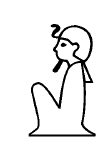

OccID = 2478
Monument : Menna TT.69
Monument type : Private Tomb
Localisation or provenance : Sheikh Abd el-Gurna
Period : Dynasty XVIII
Reign(s) : Thutmose IV
Approximate date : 1400 - 1390
ExemplarID = 41 - statistical relevance rating : *
Colours used : face red, beard blue, wig and robe white


OccID = 2322
Monument : Rekhmire TT.100
Monument type : Private Tomb
Localisation or provenance : Sheikh Abd el-Gurna
Period : Dynasty XVIII
Reign(s) : Thutmose III - Amenhotep II
Approximate date : 1479 - 1400
ExemplarID = 57 - statistical relevance rating : ***
Colours used : face and hand red, robe white, flagellum (and uraeus?) yellow, hair faded


OccID = 3135
Monument : Penmaât
Monument type : Mummy board
Localisation or provenance : Sheikh Abd el-Gurna
Period : Dynasty XXII
Reign(s) : Osorkon I - ?
Approximate date : 945 - 715
ExemplarID = 42 - statistical relevance rating : *
Colours used : face red, wig white, beard blue, robe white with red markings, shoulder green, mace outline red


OccID = 1567
Monument : Khonsou-Tefnakht E.586
Monument type : Coffin
Localisation or provenance : El Hibeh
Period : Dynasty XXVII
Reign(s) : ?
Approximate date : 525 - 404
ExemplarID = 43 - statistical relevance rating : *
Colours used : face, hand, red crown, uraeus red, white crown white or yellow, beard and details black, robe green with white collar, flagellum green


OccID = 3884
Monument : Rekhmire TT.100
Monument type : Private Tomb
Localisation or provenance : Sheikh Abd el-Gurna
Period : Dynasty XVIII
Reign(s) : Thutmose III - Amenhotep II
Approximate date : 1479 - 1400
ExemplarID = 290 - statistical relevance rating : **
Colours used : hair black, face and hands red, eye black and white, robe white, knife (a stick?) red


OccID = 2467
Monument : Menna TT.69
Monument type : Private Tomb
Localisation or provenance : Sheikh Abd el-Gurna
Period : Dynasty XVIII
Reign(s) : Thutmose IV
Approximate date : 1400 - 1390
ExemplarID = 59 - statistical relevance rating : ***
Colours used : face and hands red, hair black, flagellum yellow, robe white, outline red, seat indistinct


OccID = 2521
Monument : Nakht TT.52
Monument type : Private Tomb
Localisation or provenance : Sheikh Abd el-Gurna
Period : Dynasty XVIII
Reign(s) : Thutmose IV
Approximate date : 1400 - 1390
ExemplarID = 47 - statistical relevance rating : *****
Colours used : hair black, face red, eye white, arms red, robe white, flagellum yellow


OccID = 1490
Monument : Khonsou-Tefnakht E.586
Monument type : Coffin
Localisation or provenance : El Hibeh
Period : Dynasty XXVII
Reign(s) : ?
Approximate date : 525 - 404
ExemplarID = 48 - statistical relevance rating : *
Colours used : face, feet and hand red, hair and beard black, eye black and white, robe green, lotus flower blue


OccID = 3132
Monument : Penmaât
Monument type : Mummy board
Localisation or provenance : Sheikh Abd el-Gurna
Period : Dynasty XXII
Reign(s) : Osorkon I - ?
Approximate date : 945 - 715
ExemplarID = 51 - statistical relevance rating : **
Colours used : face and robe red, hair blue, shoulder green


OccID = 1533
Monument : Khonsou-Tefnakht E.586
Monument type : Coffin
Localisation or provenance : El Hibeh
Period : Dynasty XXVII
Reign(s) : ?
Approximate date : 525 - 404
ExemplarID = 53 - statistical relevance rating : ***
Colours used : cube white (or yellow?), face red with black and white eye, hair and beard black
Group B is poorly represented in polychrome, monumental inscriptions. The group contains seven signs to which one additional sign has been added. Of these eight signs, only two possess database occurrences (25%), eight of B1, a seated woman and one of B8b, a variation of B8 showing a seated woman holding an open lotus flower. Most of the other signs in Group B concern birth or motherhood, so the absence of women from the inscriptions is understandable, when one considers the bias towards male owners of tombs and pharaonic architecture and the restricted subject matter of the texts.
As is to be expected from the previous discussion of Group A skin colouring, the signs in Group B have yellow skin. Again, the simplistic explanation of women’s indoor activities as being the reason for their paler skin is not justified by the evidence. For example, in the banqueting scenes from the south-west wall of the tomb of Nakht (Mon.41 - TT.52) we can see the distinction between upper-class, pink-skinned female guests at a banquet (Mekhitarian 1989, 84-85), and their lower-class entertainers, a trio of red-skinned female musicians (Mekhitarian 1989, 87). There is no reason to think that female musicians would have practised or performed in the open air (especially naked!), so the contrasting shades must be purely symbolic.
Eaverly (2013) takes a novel approach by comparing differences in Egyptian skin colouring with those of the figures on Archaic Greek Attic vases. The distinction in Greece is even more marked than in Egyptian, as black is used for men and white for women. Obviously, therefore, no attempt is made at realism, but the contrast serves instead as a classifier of male and female principles. Eaverly considers that this classification served as a support for pharaonic ideology and of the role of women as complementary opposites of men (2013, 54). Evidence for this view can be seen in the iconography of Hatshepsut where, despite the presence of some feminine secondary characteristics, her skin is red (e.g. Tiradritti 1999, 162). This demonstrates the importance of skin colour in symbolising the masculine role of the Pharaoh (see Eaverly 2013, 56-70). A similar case can be seen in the images of Nefertari in her QV.66 tomb, where her skin colour is pale red with darker red details, whereas goddesses in the same scenes have the usual yellow-gold skin. (Rickerby 1993, 49, Fig.8). This is probably done to emphasise the power and vigour of the Great Queen. Warburton (2008, 244) believes that an opposition existed between the colour rwD - the red used for male skin - which means something like “strong, hard” and nbw - the golden, bright colour used for female skin. This fits with the idea of Hatshepsut’s and Nefertari’s enhanced power, as mentioned above.
The classification created by the use of dark or pale skin seems therefore to be quite complex. On the one hand, we have a simple distinction between male and female, whereas on the other, there appears to be a distinction due to the person’s social status, of either ethnicity, rank, function, age or class.

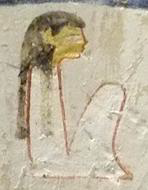
OccID = 2530
Monument : Nakht TT.52
Monument type : Private Tomb
Localisation or provenance : Sheikh Abd el-Gurna
Period : Dynasty XVIII
Reign(s) : Thutmose IV
Approximate date : 1400 - 1390
ExemplarID = 60 - statistical relevance rating : ****
Colours used : hair black, face yellow with red markings, robe white


OccID = 1794
Monument : Peftjauneith
Monument type : Coffin
Localisation or provenance : Sais
Period : Dynasty XXVI
Reign(s) : ?
Approximate date : 664 - 525
ExemplarID = 61 - statistical relevance rating : ****
Colours used : face yellow, eye black and white, hair black, robe red
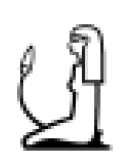

OccID = 1790
Monument : Peftjauneith
Monument type : Coffin
Localisation or provenance : Sais
Period : Dynasty XXVI
Reign(s) : ?
Approximate date : 664 - 525
ExemplarID = 62 - statistical relevance rating : *
Colours used : hair black, face, hand and feet yellow, robe red, lotus green stem with yellow flower
Gardiner’s Group C contains sixteen signs, to which have here been added four more. Five out of twenty signs, therefore, have database occurrences (25%). In Gardiner’s list, only C6 a cynocephalic god has a database occurrence. The other four additional signs signs are not included by Gardiner probably because his focus was primarily on Middle Kingdom hieroglyphs (EG 449) or simply because the variations are sometimes minimal (e.g. C10* where the only difference between it and C10 is the presence of an ankh sign held by Ma’at). The sign C11, a god supporting the sky with raised arms is shown by Gardiner as having an M4 palm branch on his head, but he states that C11 is also often found without this feature. This observation is borne out by the four occurrences in the database, two of which do not feature the branch. For this reason, a separate sign has not been created in the database.
The two remaining exemplars in Group C are C93, a Nile god holding a palm branch and C126, a female deity wearing a diadem on her head. According to Bryan (2007, 32), this headgear is a “modius” : a vessel for measuring grain. The colour red used in all three database occurrences of C126 would indicate a pot made of fired clay, which supports Bryan’s identification.
The deities depicted in the Group C exemplars display an interesting range of skin tones. The dog C6 is black, as in other signs showing Anubis or Wepwawet (E15, E17, E152). The goddess Ma’at C10* and the goddess Mut C126 both have yellow faces, as do all women. The god with arms raised C11 has the typical male skin colour of red, but the curved beard and long blue wig mark him out as a god. Interestingly, this exemplar shows the same unusual male dress as seen in other signs from this monument (Mon.52, the mummy-board of Penmaat) : the god has a white shawl or sash draped over the left shoulder. The Nile god C93 has either dark blue skin representing the river water, or dark green skin representing the aquatic environment, growth and fertility (the distinction between blue and dark green is difficult to see in this exemplar).
The hair (or wigs) of all the deities is blue. Gods’ hair was believed to be made of lapis lazuli (Mathieu 2009, 47; Hornung 1982, 153)).


OccID = 3611
Monument : Ramses IV KV.2
Monument type : Royal Tomb
Localisation or provenance : Valley of the Kings
Period : Dynasty XX
Reign(s) : Ramses IV
Approximate date : 1153 - 1147
ExemplarID = 291 - statistical relevance rating : *
Colours used : robe red, upper body and face faded (green?), sun red


OccID = 1293
Monument : Horemheb KV.57
Monument type : Royal Tomb
Localisation or provenance : Valley of the Kings
Period : Dynasty XVIII
Reign(s) : Horemheb
Approximate date : 1323 - 1295
ExemplarID = 63 - statistical relevance rating : *
Colours used : robe white, head black, wig blue


OccID = 3351
Monument : Sarenput II
Monument type : Private Tomb
Localisation or provenance : Elephantine
Period : Dynasty XII
Reign(s) : Amenemhat II
Approximate date : 1911 - 1877
ExemplarID = 281 - statistical relevance rating : *
Colours used : face and uraeus yellow, hair black, robe white


OccID = 2422
Monument : Rekhmire TT.100
Monument type : Private Tomb
Localisation or provenance : Sheikh Abd el-Gurna
Period : Dynasty XVIII
Reign(s) : Thutmose III - Amenhotep II
Approximate date : 1479 - 1400
ExemplarID = 292 - statistical relevance rating : *
Colours used : face yellow, robe white, feather white with red ribs


OccID = 1276
Monument : Horemheb KV.57
Monument type : Royal Tomb
Localisation or provenance : Valley of the Kings
Period : Dynasty XVIII
Reign(s) : Horemheb
Approximate date : 1323 - 1295
ExemplarID = 65 - statistical relevance rating : **
Colours used : robe white, face yellow, hair blue, filet red, feather yellow and red, ankh blue with white fill


OccID = 3169
Monument : Penmaât
Monument type : Mummy board
Localisation or provenance : Sheikh Abd el-Gurna
Period : Dynasty XXII
Reign(s) : Osorkon I - ?
Approximate date : 945 - 715
ExemplarID = 52 - statistical relevance rating : ****
Colours used : flesh red, wig and beard blue, robe white


OccID = 1795
Monument : Peftjauneith
Monument type : Coffin
Localisation or provenance : Sais
Period : Dynasty XXVI
Reign(s) : ?
Approximate date : 664 - 525
ExemplarID = 66 - statistical relevance rating : *
Colours used : god blue, hair black, branch and papyrus green


OccID = 1295
Monument : Horemheb KV.57
Monument type : Royal Tomb
Localisation or provenance : Valley of the Kings
Period : Dynasty XVIII
Reign(s) : Horemheb
Approximate date : 1323 - 1295
ExemplarID = 67 - statistical relevance rating : **
Colours used : robe white, face yellow, wig blue, modius red


OccID = 3808
Monument : Temple of Sety I - Abydos
Monument type : Temple
Localisation or provenance : Abydos
Period : Dynasty XIX
Reign(s) : Sety I
Approximate date : 1294 - 1279
ExemplarID = 293 - statistical relevance rating : **
Colours used : modius and wig faded, face and upper body yellow, robe red
Group D is well represented in the database. Out of a total in Gardiner’s list of sixty-six signs, many of them simple variants, plus three added here, there are forty with database occurrences (58%), thirty-six of which have images. Perhaps unsurprisingly, the majority of these signs are coloured red, the colour of blood, life and vigour, representing human (male) flesh.
One fascinating exception is D2, a man’s face seen frontally. This sign is unusual in two ways. On the one hand, frontal views are extremely rare in Egyptian art (Schäfer 1974, 209) and on the other hand, yellow skin for the depiction of a man is equally rare (see above the discussions in Groups A and B). That this is a masculine image is borne out by the presence of a beard, coloured in the same way as the hair (usually black). Beards are normally reserved for gods, kings and the deceased (as an Osirian symbol), divine beards being distinguished by a curved tip. The beard on D2 is quite long with the tip broader than the upper part. This is typical of the Old Kingdom when statues of pharaohs were often embellished with this kind of beard. Examples can be seen, for instance, on statues of Netjerikhet, Khafre and Menkaure (Malek 1986, 54-55). Later kings did not sport facial hair and most beards seen in representations of pharaohs are “false beards”, with a strap holding them in place. It should be noted, however, that some commoners are occasionally shown to have small, trimmed beards and the sign D1 a man’s face seen in profile, can also have one (see exemplar and occurrences).
This would suggest that, as D1 and D2 have different skin colours, they do not represent the same category of person. D1 is obviously the standard red-bodied Egyptian male, as in most signs from Group A. D2 cannot be an Egyptian female, because of the cropped hair and beard. As we have seen for A20, yellow can also represent old age, but this use is rare. Yellow can also be used to symbolise Asiatics, but the frequency and antiquity of D2 would exclude this use. The earliest database occurrence of a yellow D2 comes from the Dynasty IV mastaba of Meresankh III at Giza (Mon.18), the latest from the Dynasty XXVII coffin of Khonsou-Tefnakht from el-Hibeh (Mon.31).
We are, therefore, left with the face of a god. The gods’ flesh was believed to be made of gold (Hornung 1982, 153), as this metal is imperishable and incorruptible. It was thus a potent symbol of eternal life (Wilkinson 1994, 83). Gold was also a solar symbol, associated with Re and his divine descendants. To ensure an identification with Osiris, the mummified body could also be embellished with gold, most notably in the form of a golden, gilded or painted mummy-mask (Wilkinson 1994, 84).
The dictionary gives no clue to the yellow face, as the basic meaning of Hr is “face”, “head” or “sight” (FCD 174; Wb III, 125). Perhaps the face was considered to be something sacred or as a kind of “window to the soul”, as colour is often used to portray the substance rather than the reflected surface of an object (see chapter 6 - Colour Symbolism). Some of the occurrences even show a face that is almost transparent, devoid of any colour.
Another intriguing observation is that in two occurrences (Mon.39 - TT.100; Mon.40 - TT.69), the eyes are turned sideways away from the viewer. This is no accident nor the result of poor draughtsmanship, especially in the carefully drawn exemplar from the tomb of Menna. This must be in order to avoid the “evil eye” (LÄ VI, 1320-1355) or to prevent the reader from baring the “soul” of the hieroglyph.
So, we are left with two options. Either the yellow face is that of a god (so also a deceased pharaoh) or it could be that of a man, where the colour is a way of depicting the transparency of the face as a reflection of the inner being. I have a preference for the latter.
There is another sign for part of the face, D19 the nose, eye and cheek of a human shown in profile, which is almost always yellow. This could be for the same reasons as for D2, but this is a profile view and would be expected to have the same colour as D1. In the absence of any hair or a beard, it could represent either a divine nose, eye and cheek, or those of a woman. In this case, the dictionary may be of some help. As well as the basic meaning of fnD being “nose”, xnt can also be a synonym of Hr meaning “face”. So this could indeed be just another representation of the face with its yellow colouring. However, I have another suggestion : D19 is also associated with words for pleasure, such as sn “smell, perfume, kiss” (FCD 230), rSwt “joy” (FCD 153), xntS “have / give enjoyment” (FCD 195), sfn “be kindly” (FCD 224) : all words that suggest feminine characteristics. In this case, the yellow would simply correspond to the usual colour used for women’s skin.
Two exemplars from this group, D21 the mouth and D54 two legs walking, illustrate one of the uses of white : to indicate empty space (often replaced by yellow in some Ramesside inscriptions). Many of the occurrences of D21 show the space between the lips as white, indicating that the mouth is open. The walking legs often show this fill colouring (see also M18), as does one occurrence of D28 the extended arms. The intended effect may be one of symbolic movement : the mouth opening and closing, the legs actually walking and the arms reaching out to embrace.
The two exemplars of D4 the eye, present an interesting case of different colours used for the same sign on the same monument (Mon.32, TT.74, Tjanuni). The iris in the first exemplar is red and in the second is black. The eye is a powerful and complex symbol in Egyptian myth and religion (Rundle Clark 1959, 218-230). The red eye is associated with solar imagery such as in the eye of Re whence came humankind in the form of tears, the protective and fierce Uraeus and the right eye of Horus. The black eye is the left eye of Horus, associated with lunar imagery. This was the eye that was torn out by Seth and restored to Horus by Thoth, the lunar god (Broze 1997, 252-253). As god of the underworld, Osiris is also associated with this “eye” of the night. This is the symbolism intended in these exemplars. Whereas the red eye is used in all the common words such as irw, irt and mAA (“make, do" and "see”), the black eye in these inscriptions from TT.74 is used exclusively in the name of Osiris - Wsir. Another rare sign (D119 a pair of eyes) from Mon.31, the coffin of Khonsou-Tefnakht, shows the same black irises. The symbolism is probably lunar and underworld, but the adjoining text is lacunary. The eye of Horus - the Wedjat - seen in exemplar D10 has a black iris, showing this to be the left eye restored by Thoth.
Two exemplars of D6 an eye with make-up on the eyelashes, both have the more common red irises. One has the typical green eye-paint whereas the other has red make-up. The context shows that this is not just a substitute for D4, as in this inscription D6 is used only in the word Sp meaning “(be / make) blind” (FCD 264). Eye make-up is used in many cultures as a means of protecting the eye against infection, so in this case the use of green eye-paint may be a way of rendering the word for blindness harmless to the deceased. Red make-up does not seem to have existed in reality, as green malachite was in use until the middle of the Old Kingdom when it was replaced by black galena (kohl) (Aston 2000, 44). The red used here may, therefore, be a symbol for “danger / evil”, to warn the deceased (or the reader) of the peril of this word Sp.
The sign D45 an arm with the hand clutching a nHbt wand presents an interesting case. One intriguing possibility is that the nHbt is a brush made of plant fibre. This idea was first proposed by Gardiner on purely linguistic grounds (1946, 51). The green colour used here in this exemplar adds weight to this suggestion (see also D45*, a two-handed version of D45). Fischer also cites an example from the reign of Tuthmosis IV showing the nHbt as a lettuce (1999, 19, fig. b.), but this interpretation seems more unlikely as the form does not correspond to that of the usual depiction of the plant.
The sign D61 supposedly represents human toes. However, this image of part of the human anatomy seems curiously inaccurate. Although early examples bear a vague resemblance to toes (see a Dynasty IV example in Fischer 1999, 20, fig.a.), the sign rapidly became more stylised (see a Dynasty V example in Fischer 1999, 20, fig.b.), with the “toenails” appearing as loops. Although this exemplar is red, a Dynasty V variant is green. The very similar D62 takes us even further from a depiction of human toes, as in the exemplar they are coloured green with red loops. It is also legitimate to ask why only three toes are represented and what the curious bar (or horizontal toe) at the base is supposed to be. A comparison with Ex.D50 (the single, upright finger) from the same monument (Rekhmire Mon.39) shows a distinct difference in the representation of digits, D50 being totally naturalistic. I would therefore suggest that these signs D61 and D62 represent something other than toes, but any revised identification must be the result of further detailed research.
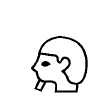

OccID = 1239
Monument : Horemheb KV.57
Monument type : Royal Tomb
Localisation or provenance : Valley of the Kings
Period : Dynasty XVIII
Reign(s) : Horemheb
Approximate date : 1323 - 1295
ExemplarID = 69 - statistical relevance rating : *****
Colours used : face red, hair and beard and eyebrow black, eye black and white


OccID = 2072
Monument : Ramses I KV.16
Monument type : Royal Tomb
Localisation or provenance : Valley of the Kings
Period : Dynasty XIX
Reign(s) : Ramses I
Approximate date : 1295 - 1294
ExemplarID = 71 - statistical relevance rating : ****
Colours used : face yellow, details red, eyes, hair and beard black


OccID = 1791
Monument : Peftjauneith
Monument type : Coffin
Localisation or provenance : Sais
Period : Dynasty XXVI
Reign(s) : ?
Approximate date : 664 - 525
ExemplarID = 70 - statistical relevance rating : ****
Colours used : face yellow, features, hair and beard black


OccID = 2438
Monument : Menna TT.69
Monument type : Private Tomb
Localisation or provenance : Sheikh Abd el-Gurna
Period : Dynasty XVIII
Reign(s) : Thutmose IV
Approximate date : 1400 - 1390
ExemplarID = 72 - statistical relevance rating : ****
Colours used : face yellow, features red, hair, pupils and beard black


OccID = 1299
Monument : Sarenput II
Monument type : Private Tomb
Localisation or provenance : Elephantine
Period : Dynasty XII
Reign(s) : Amenemhat II
Approximate date : 1911 - 1877
ExemplarID = 294 - statistical relevance rating : ****
Colours used : face yellow, eyeballs white, irises black, hair black, beard (mistaken for neck?) yellow


OccID = 1630
Monument : Tjanuni TT.74
Monument type : Private Tomb
Localisation or provenance : Sheikh Abd el-Gurna
Period : Dynasty XVIII
Reign(s) : Thutmose IV
Approximate date : 1400 - 1390
ExemplarID = 17 - statistical relevance rating : ****
Colours used : outline black, inner white, iris red with black pupil


OccID = 1631
Monument : Tjanuni TT.74
Monument type : Private Tomb
Localisation or provenance : Sheikh Abd el-Gurna
Period : Dynasty XVIII
Reign(s) : Thutmose IV
Approximate date : 1400 - 1390
ExemplarID = 276 - statistical relevance rating : ****
Colours used : outline black, inner white, iris black


OccID = 1593
Monument : Khonsou-Tefnakht E.586
Monument type : Coffin
Localisation or provenance : El Hibeh
Period : Dynasty XXVII
Reign(s) : ?
Approximate date : 525 - 404
ExemplarID = 73 - statistical relevance rating : **
Colours used : eye surround blue, fill white, pupil red, lashes green with blue lines


OccID = 3168
Monument : Penmaât
Monument type : Mummy board
Localisation or provenance : Sheikh Abd el-Gurna
Period : Dynasty XXII
Reign(s) : Osorkon I - ?
Approximate date : 945 - 715
ExemplarID = 78 - statistical relevance rating : **
Colours used : outline black, eyeball white, iris red, paint above eye red


OccID = 1832
Monument : Peftjauneith
Monument type : Coffin
Localisation or provenance : Sais
Period : Dynasty XXVI
Reign(s) : ?
Approximate date : 664 - 525
ExemplarID = 74 - statistical relevance rating : *
Colours used : outline and details black, iris white, background yellow

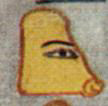
OccID = 2094
Monument : Ramses I KV.16
Monument type : Royal Tomb
Localisation or provenance : Valley of the Kings
Period : Dynasty XIX
Reign(s) : Ramses I
Approximate date : 1295 - 1294
ExemplarID = 75 - statistical relevance rating : ****
Colours used : face yellow, eye black and white, features and outline red


OccID = 1540
Monument : Khonsou-Tefnakht E.586
Monument type : Coffin
Localisation or provenance : El Hibeh
Period : Dynasty XXVII
Reign(s) : ?
Approximate date : 525 - 404
ExemplarID = 77 - statistical relevance rating : ****
Colours used : face yellow, features and outline black or blue


OccID = 1793
Monument : Peftjauneith
Monument type : Coffin
Localisation or provenance : Sais
Period : Dynasty XXVI
Reign(s) : ?
Approximate date : 664 - 525
ExemplarID = 76 - statistical relevance rating : ****
Colours used : face red, eye white with black iris


OccID = 1459
Monument : Sobekhotep TT.63
Monument type : Private Tomb
Localisation or provenance : Sheikh Abd el-Gurna
Period : Dynasty XVIII
Reign(s) : Thutmose IV
Approximate date : 1400 - 1390
ExemplarID = 79 - statistical relevance rating : *****
Colours used : red with white fill


OccID = 1519
Monument : Khonsou-Tefnakht E.586
Monument type : Coffin
Localisation or provenance : El Hibeh
Period : Dynasty XXVII
Reign(s) : ?
Approximate date : 525 - 404
ExemplarID = 80 - statistical relevance rating : *****
Colours used : red


OccID = 1891
Monument : Peftjauneith
Monument type : Coffin
Localisation or provenance : Sais
Period : Dynasty XXVI
Reign(s) : ?
Approximate date : 664 - 525
ExemplarID = 81 - statistical relevance rating : **
Colours used : arms red, standard black with red cloth


OccID = 2423
Monument : Rekhmire TT.100
Monument type : Private Tomb
Localisation or provenance : Sheikh Abd el-Gurna
Period : Dynasty XVIII
Reign(s) : Thutmose III - Amenhotep II
Approximate date : 1479 - 1400
ExemplarID = 82 - statistical relevance rating : ***
Colours used : red
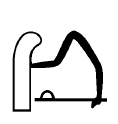

OccID = 3159
Monument : Penmaât
Monument type : Mummy board
Localisation or provenance : Sheikh Abd el-Gurna
Period : Dynasty XXII
Reign(s) : Osorkon I - ?
Approximate date : 945 - 715
ExemplarID = 83 - statistical relevance rating : *
Colours used : arms red, shield outline and spots black, axe black (or blue?)


OccID = 1550
Monument : Khonsou-Tefnakht E.586
Monument type : Coffin
Localisation or provenance : El Hibeh
Period : Dynasty XXVII
Reign(s) : ?
Approximate date : 525 - 404
ExemplarID = 84 - statistical relevance rating : *****
Colours used : red


OccID = 1637
Monument : Tjanuni TT.74
Monument type : Private Tomb
Localisation or provenance : Sheikh Abd el-Gurna
Period : Dynasty XVIII
Reign(s) : Thutmose IV
Approximate date : 1400 - 1390
ExemplarID = 85 - statistical relevance rating : *****
Colours used : red


OccID = 1211
Monument : Horemheb KV.57
Monument type : Royal Tomb
Localisation or provenance : Valley of the Kings
Period : Dynasty XVIII
Reign(s) : Horemheb
Approximate date : 1323 - 1295
ExemplarID = 86 - statistical relevance rating : ****
Colours used : arm and hand red, offering black triangles with white fill
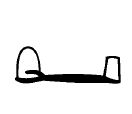

OccID = 2326
Monument : Rekhmire TT.100
Monument type : Private Tomb
Localisation or provenance : Sheikh Abd el-Gurna
Period : Dynasty XVIII
Reign(s) : Thutmose III - Amenhotep II
Approximate date : 1479 - 1400
ExemplarID = 295 - statistical relevance rating : *
Colours used : arm red, loaf white (or faded?)
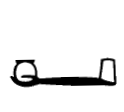

OccID = 1214
Monument : Horemheb KV.57
Monument type : Royal Tomb
Localisation or provenance : Valley of the Kings
Period : Dynasty XVIII
Reign(s) : Horemheb
Approximate date : 1323 - 1295
ExemplarID = 87 - statistical relevance rating : ***
Colours used : arm and hand red, bowl red with black top


OccID = 2769
Monument : Menkheper TT.79
Monument type : Private Tomb
Localisation or provenance : Sheikh Abd el-Gurna
Period : Dynasty XVIII
Reign(s) : Thutmose III - Amenhotep II
Approximate date : 1479 - 1400
ExemplarID = 88 - statistical relevance rating : ****
Colours used : red


OccID = 3146
Monument : Penmaât
Monument type : Mummy board
Localisation or provenance : Sheikh Abd el-Gurna
Period : Dynasty XXII
Reign(s) : Osorkon I - ?
Approximate date : 945 - 715
ExemplarID = 89 - statistical relevance rating : ***
Colours used : red


OccID = 1270
Monument : Horemheb KV.57
Monument type : Royal Tomb
Localisation or provenance : Valley of the Kings
Period : Dynasty XVIII
Reign(s) : Horemheb
Approximate date : 1323 - 1295
ExemplarID = 90 - statistical relevance rating : *
Colours used : arm red, flagellum yellow


OccID = 1246
Monument : Horemheb KV.57
Monument type : Royal Tomb
Localisation or provenance : Valley of the Kings
Period : Dynasty XVIII
Reign(s) : Horemheb
Approximate date : 1323 - 1295
ExemplarID = 109 - statistical relevance rating : ****
Colours used : arm red, wand green with yellow handle


OccID = 1606
Monument : Khonsou-Tefnakht E.586
Monument type : Coffin
Localisation or provenance : El Hibeh
Period : Dynasty XXVII
Reign(s) : ?
Approximate date : 525 - 404
ExemplarID = 91 - statistical relevance rating : **
Colours used : arms and hands red, wand green


OccID = 1461
Monument : Sobekhotep TT.63
Monument type : Private Tomb
Localisation or provenance : Sheikh Abd el-Gurna
Period : Dynasty XVIII
Reign(s) : Thutmose IV
Approximate date : 1400 - 1390
ExemplarID = 93 - statistical relevance rating : *****
Colours used : red


OccID = 30
Monument : Haremheb TT.78
Monument type : Private Tomb
Localisation or provenance : Sheikh Abd el-Gurna
Period : Dynasty XVIII
Reign(s) : Thutmose III - Amenhotep III
Approximate date : 1479 - 1352
ExemplarID = 94 - statistical relevance rating : ***
Colours used : red


OccID = 2328
Monument : Rekhmire TT.100
Monument type : Private Tomb
Localisation or provenance : Sheikh Abd el-Gurna
Period : Dynasty XVIII
Reign(s) : Thutmose III - Amenhotep II
Approximate date : 1479 - 1400
ExemplarID = 95 - statistical relevance rating : ***
Colours used : finger red, nail white (or pink?)


OccID = 2428
Monument : Rekhmire TT.100
Monument type : Private Tomb
Localisation or provenance : Sheikh Abd el-Gurna
Period : Dynasty XVIII
Reign(s) : Thutmose III - Amenhotep II
Approximate date : 1479 - 1400
ExemplarID = 97 - statistical relevance rating : *****
Colours used : red


OccID = 1536
Monument : Khonsou-Tefnakht E.586
Monument type : Coffin
Localisation or provenance : El Hibeh
Period : Dynasty XXVII
Reign(s) : ?
Approximate date : 525 - 404
ExemplarID = 98 - statistical relevance rating : **
Colours used : phallus red, liquid blue


OccID = 2078
Monument : Ramses I KV.16
Monument type : Royal Tomb
Localisation or provenance : Valley of the Kings
Period : Dynasty XIX
Reign(s) : Ramses I
Approximate date : 1295 - 1294
ExemplarID = 99 - statistical relevance rating : *****
Colours used : red, fill white


OccID = 1547
Monument : Khonsou-Tefnakht E.586
Monument type : Coffin
Localisation or provenance : El Hibeh
Period : Dynasty XXVII
Reign(s) : ?
Approximate date : 525 - 404
ExemplarID = 101 - statistical relevance rating : ***
Colours used : red


OccID = 2330
Monument : Rekhmire TT.100
Monument type : Private Tomb
Localisation or provenance : Sheikh Abd el-Gurna
Period : Dynasty XVIII
Reign(s) : Thutmose III - Amenhotep II
Approximate date : 1479 - 1400
ExemplarID = 102 - statistical relevance rating : *****
Colours used : red


OccID = 2758
Monument : Menkheper TT.79
Monument type : Private Tomb
Localisation or provenance : Sheikh Abd el-Gurna
Period : Dynasty XVIII
Reign(s) : Thutmose III - Amenhotep II
Approximate date : 1479 - 1400
ExemplarID = 103 - statistical relevance rating : *****
Colours used : red


OccID = 3158
Monument : Penmaât
Monument type : Mummy board
Localisation or provenance : Sheikh Abd el-Gurna
Period : Dynasty XXII
Reign(s) : Osorkon I - ?
Approximate date : 945 - 715
ExemplarID = 104 - statistical relevance rating : *
Colours used : red


OccID = 1645
Monument : Tjanuni TT.74
Monument type : Private Tomb
Localisation or provenance : Sheikh Abd el-Gurna
Period : Dynasty XVIII
Reign(s) : Thutmose IV
Approximate date : 1400 - 1390
ExemplarID = 105 - statistical relevance rating : ****
Colours used : foot red, lower half of vase red, upper half blue, liquid blue
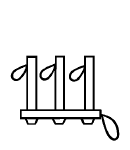

OccID = 3124
Monument : Temple of Ramses II (Abydos)
Monument type : Temple
Localisation or provenance : Abydos
Period : Dynasty XIX
Reign(s) : Ramses II
Approximate date : 1279 - 1213
ExemplarID = 106 - statistical relevance rating : *
Colours used : red


OccID = 2331
Monument : Rekhmire TT.100
Monument type : Private Tomb
Localisation or provenance : Sheikh Abd el-Gurna
Period : Dynasty XVIII
Reign(s) : Thutmose III - Amenhotep II
Approximate date : 1479 - 1400
ExemplarID = 107 - statistical relevance rating : *
Colours used : "toes" green, loops red


OccID = 1608
Monument : Khonsou-Tefnakht E.586
Monument type : Coffin
Localisation or provenance : El Hibeh
Period : Dynasty XXVII
Reign(s) : ?
Approximate date : 525 - 404
ExemplarID = 108 - statistical relevance rating : *
Colours used : black


OccID = 666
Monument : Ankhmerire
Monument type : Mastaba
Localisation or provenance : Saqqara
Period : Dynasty VI
Reign(s) : Pepy I
Approximate date : 2321 - 2287
ExemplarID = 296 - statistical relevance rating : ***
Colours used : lips red, water (faded) blue


OccID = 176
Monument : Wepemnefret G1201
Monument type : Slab stela
Localisation or provenance : Giza
Period : Dynasty IV
Reign(s) : Khufu
Approximate date : 2589 - 2566
ExemplarID = 282 - statistical relevance rating : **
Colours used : arm red, water grey
Group E contains eighteen signs with three added here. Of these twenty-one, eighteen possess database occurrences (86%), fourteen of which have images. Most exemplars in this group have naturalistic colouring.
The bull E1 has a variegated red-brown spotted hide. Its aggressive variant E2 has a grey-blue hide which is also compatible with a natural colour. Surprisingly, the aggressive nature of this variant is not coloured a metaphorical red, as one might expect.
E9, according to Gardiner, represents a newborn bubalis or hartebeest. The latter seems indicated by this image, not only because of the elongated head and ears but also because of the pale pink of the skin. A newborn bubalis has a more massive head and is much darker.
The similar signs E10 and E11 have typical naturalistic colouring of either yellow and black or black and white. The same is true of the yellow and red goat with a seal around its neck E31. Sheep and goats in reality show great variation in colour.
The recumbent dog E15 and the standing dog E17 are black. The composite sign E152 of a recumbent dog with flagellum sitting atop a shrine also shows the dog as black. This is a metaphorical use of colour, as the dog is associated with death, the underworld and the necropolis.
The recumbent lion E23 in this exemplar is a remarkably accurate, naturalistic drawing. The blue mane, typically found on the foreparts of a lion F4 is absent here.
The elephant E24, in the absence of the colour grey, is painted in what appears to be a stippled coat of reddish-brown on black. The resulting naturalistic tone is quite effective.
One very common sign from Group E is the desert hare E34. Its natural brown coat is rendered in hieroglyphs as yellow with dark (often red or blue-black) spots. As well as providing an approximation to brown, a colour absent from the scribe-painter’s palette, this scheme is the same as that used to portray the sandy and stony desert in signs such as N25 and N27. The same colouring can also sometimes be seen in other desert animals such as the horned viper I9 and the cobra I10. In the same way that non-naturalistic blue wings identify a bird as a creature of the sky, red or blue-black spotted yellow associates an animal with its desert habitat.
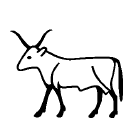

OccID = 3166
Monument : Penmaât
Monument type : Mummy board
Localisation or provenance : Sheikh Abd el-Gurna
Period : Dynasty XXII
Reign(s) : Osorkon I - ?
Approximate date : 945 - 715
ExemplarID = 110 - statistical relevance rating : ***
Colours used : red (faded), possibly pale patches(?)
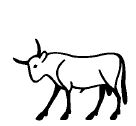

OccID = 2639
Monument : Nefersekheru TT.296
Monument type : Private Tomb
Localisation or provenance : Khokha
Period : Dynasty XIX
Reign(s) : Ramses II
Approximate date : 1279 - 1213
ExemplarID = 111 - statistical relevance rating : **
Colours used : blue


OccID = 2332
Monument : Rekhmire TT.100
Monument type : Private Tomb
Localisation or provenance : Sheikh Abd el-Gurna
Period : Dynasty XVIII
Reign(s) : Thutmose III - Amenhotep II
Approximate date : 1479 - 1400
ExemplarID = 112 - statistical relevance rating : **
Colours used : faded red? or pink?
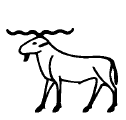

OccID = 3572
Monument : Ramses IV KV.2
Monument type : Royal Tomb
Localisation or provenance : Valley of the Kings
Period : Dynasty XX
Reign(s) : Ramses IV
Approximate date : 1153 - 1147
ExemplarID = 297 - statistical relevance rating : **
Colours used : body and legs yellow, mane blue, horns faded

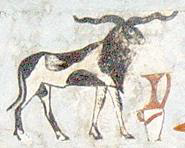
OccID = 1306
Monument : Sarenput II
Monument type : Private Tomb
Localisation or provenance : Elephantine
Period : Dynasty XII
Reign(s) : Amenemhat II
Approximate date : 1911 - 1877
ExemplarID = 277 - statistical relevance rating : **
Colours used : head, horns and chest black, hindparts white with black spots


OccID = 1860
Monument : Peftjauneith
Monument type : Coffin
Localisation or provenance : Sais
Period : Dynasty XXVI
Reign(s) : ?
Approximate date : 664 - 525
ExemplarID = 114 - statistical relevance rating : *****
Colours used : black


OccID = 3165
Monument : Penmaât
Monument type : Mummy board
Localisation or provenance : Sheikh Abd el-Gurna
Period : Dynasty XXII
Reign(s) : Osorkon I - ?
Approximate date : 945 - 715
ExemplarID = 115 - statistical relevance rating : *****
Colours used : black


OccID = 1591
Monument : Khonsou-Tefnakht E.586
Monument type : Coffin
Localisation or provenance : El Hibeh
Period : Dynasty XXVII
Reign(s) : ?
Approximate date : 525 - 404
ExemplarID = 116 - statistical relevance rating : ***
Colours used : yellow with black outlines and details
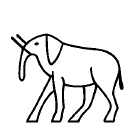

OccID = 1308
Monument : Sarenput II
Monument type : Private Tomb
Localisation or provenance : Elephantine
Period : Dynasty XII
Reign(s) : Amenemhat II
Approximate date : 1911 - 1877
ExemplarID = 278 - statistical relevance rating : *
Colours used : body grey, tusk white, eyeball white, iris black, feet black


OccID = 3162
Monument : Penmaât
Monument type : Mummy board
Localisation or provenance : Sheikh Abd el-Gurna
Period : Dynasty XXII
Reign(s) : Osorkon I - ?
Approximate date : 945 - 715
ExemplarID = 117 - statistical relevance rating : ***
Colours used : body outline and details red, horns, beard and hooves black


OccID = 2473
Monument : Menna TT.69
Monument type : Private Tomb
Localisation or provenance : Sheikh Abd el-Gurna
Period : Dynasty XVIII
Reign(s) : Thutmose IV
Approximate date : 1400 - 1390
ExemplarID = 118 - statistical relevance rating : *****
Colours used : yellow with blue spots, ears with red markings


OccID = 1287
Monument : Horemheb KV.57
Monument type : Royal Tomb
Localisation or provenance : Valley of the Kings
Period : Dynasty XVIII
Reign(s) : Horemheb
Approximate date : 1323 - 1295
ExemplarID = 119 - statistical relevance rating : ***
Colours used : dog black with white eye and red collar, flagellum yellow, shrine white with red door and blue and red frieze


OccID = 178
Monument : Wepemnefret G1201
Monument type : Slab stela
Localisation or provenance : Giza
Period : Dynasty IV
Reign(s) : Khufu
Approximate date : 2589 - 2566
ExemplarID = 283 - statistical relevance rating : *
Colours used : lioness yellow, axe yellow with blue blade and black lashings, joining object (?) red


OccID = 3639
Monument : Ramses V-VI KV.9
Monument type : Royal Tomb
Localisation or provenance : Valley of the Kings
Period : Dynasty XX
Reign(s) : Ramses V - VI
Approximate date : 1147 - 1136
ExemplarID = 298 - statistical relevance rating : *
Colours used : faces red, bodies green, hair and beards blue
This group contains contains fifty-one signs with one added here. Of these fifty-two, thirty-one possess database occurrences (60%), twenty-six of which have images. Most exemplars in this group have naturalistic colouring, but there are some notable exceptions.
The head of an ox F1 has variable patterns of colouring. The first exemplar shows a typical black and white spotted bovine. The second exemplar shown here is more like an aggressive bull with its red colour, but the context is clearly an ideogram in an offering formula. Many tomb scenes and models depict oxen, most of which are white with black spots and black or white horns (e.g. the tomb of Meketre TT.280 (Tiradritti 1999, 114-115)) . However, for aesthetic reasons, groups of oxen are sometimes shown with alternate contrasting red ones (e.g. the tomb of Menna TT.69 - Mon.40), but this is not a naturalistic colour of Egyptian oxen.
The head of a leopard F9 is yellow with a red outline and details. This is not naturalistic for a leopard, which is covered in dark spots. This can be seen quite clearly in depictions of priests wearing the skin of a leopard (Tiradritti 2008, 269). I would suggest, therefore, that this is really the head of a lioness. Support for this view is to be found in Vernus and Yoyotte (2005, 70).
The head and neck of a long-necked animal F10 has the appearance of some kind of totem. The red colour of the cross would seem to suggest two pieces of joined wood, as in Ex.Z11, especially in the occurrence from the same monument (Mon.31). The sign may therefore depict the head of an ox, impaled on a wooden cross. However, the meaning of the sign as a determinative for “neck" (FCD 197), "throat" (FCD 179) or "swallow" (FCD 42) might still suggest that the cross is merely a schematised neck (but why the cross-piece?).
F31, traditionally supposed to represent three foxes’ skins tied together, presents an interesting case of (mistaken?) identity. Unlike Faulkner, who simply cites Gardiner's explanation (FCD 116), the Wörterbuch prefers a "(fly-)whisk made from jackal skin" ("Wedel aus einem Schakalfell") (Wb II, 137.2). In hieroglyphs, jackal skin is always coloured black (cf. Exs. E15, E17 and F12), whereas F31 is nearly always green with a red knot. Therefore, a whisk made from plant fibre seems more plausible. All occurrences closely follow this colour scheme, although some less detailed variants do not show the knot as red. Maybe the fact that this sign is associated with lexemes for birth (msi etc.) leads to the symbolic use of green. But this would still not explain the red knot.
F32 presents several variations in colour. It is therefore unclear what exactly is represented here. Tradition identifies the oval shape as the belly of an animal (a cow?), but the colour green doesn't really fit with this. Meeks (2004, 198) suggests the foetal sack of a cow. In this case green would be a symbol of birth, growth and fertility (cf. Ex.Aa1). However, a comparison with other occurrences (Mons. 5, 25 etc.) shows that sometimes the belly is pale or even transparent. The traditional identification, therefore, seems the more likely, with green here still representing birth in the form of the cow's udder. The red tail is in shape and colour nearly always identical to the tail of the cow's skin in Ex.F29.
One frequent sign, the heart F34 , has three distinct colour schemes, all three found in the inscriptions from the tomb of Tjanuni TT.74 (Mon.32). The majority (65%) show simply a plain red heart, very much as one might expect from a naturalistic image. The next most common variant (21%) shows a red heart cut open to reveal the three chambers, which are coloured white, possibly as an indication of empty space. The third variant (14%) shows the heart itself as white, whereas the chambers are red. This latter colour scheme is difficult to reconcile with nature but other images of the heart taken from tomb decoration may provide a clue. Wall-paintings from the tomb of Sennefer (TT.96) (e.g. Hawass 2009, 40; Mekhitarian 1989, 81) show the deceased (and his cousin Amenemope) wearing two heart pendants, one white and one yellow, indicating one made of silver and one of gold, probably offerings from the king Amenhotep II whose cartouches are inscribed on some of the hearts (Hawass 2009, 41). The white colour thus probably represents silver. This interpretation is confirmed by the text accompanying the image. Variants of this colour scheme can also be seen in the decoration of the north wall of the corridor where a red (stone?) heart pendant is worn next to a white one. There appears, therefore, to be a double meaning for the heart hieroglyph, either that of a real sheep's heart, sometimes cut open to display the chambers, or as a stone or metal pendant offered by the king to a worthy noble.
The same imagery is displayed in F35 the heart and windpipe. The heart shows exactly the same colour variants and the windpipe varies between red, transparent white and green. Green could be a symbol of life and growth as the conduit of life-giving breath. It is perhaps significative that the windpipe of the similar hieroglyph F36 does not have this green colouring in any of the occurrences in the corpus, all of which show the windpipe as red or red with a white interior. The most common variant for F35 shows the heart as white with red chambers. The windpipe can be green, but most of these variants show the windpipe as white with a red outline. These variations are intriguing but at present remain without explanation
The similar sign F36 the lungs and windpipe, shows less variation than the previous sign. It is obviously more naturalistic and the colours are of no particular symbolic significance.
The signs for a length of intestine F46-F49 form a group that differ only in the direction of the folds. The meaning is identical and it is difficult to see why Gardiner wished to differentiate them, especially as all the cases are not covered (e.g. the occurrence from Mon.52). I propose, therefore, to ignore the variation in position and direction of the coils and regroup all the occurrences under the sign F46 . The colours used for F46 vary from black to white, green and blue. The Ramesside occurrence from Mon.56 also has a yellow fill between the coils. These variants appear to be attempts at naturalistic colouring and no symbolic meaning is implied.


OccID = 3363
Monument : Sarenput II
Monument type : Private Tomb
Localisation or provenance : Elephantine
Period : Dynasty XII
Reign(s) : Amenemhat II
Approximate date : 1911 - 1877
ExemplarID = 299 - statistical relevance rating : **
Colours used : neck red, face white with black spots


OccID = 1577
Monument : Khonsou-Tefnakht E.586
Monument type : Coffin
Localisation or provenance : El Hibeh
Period : Dynasty XXVII
Reign(s) : ?
Approximate date : 525 - 404
ExemplarID = 120 - statistical relevance rating : **
Colours used : head red, eye blue and white, horns blue


OccID = 1462
Monument : Sobekhotep TT.63
Monument type : Private Tomb
Localisation or provenance : Sheikh Abd el-Gurna
Period : Dynasty XVIII
Reign(s) : Thutmose IV
Approximate date : 1400 - 1390
ExemplarID = 300 - statistical relevance rating : ****
Colours used : head yellow with red details, mane blue, foreparts yellow, red outline


OccID = 2029
Monument : Ramses I KV.16
Monument type : Royal Tomb
Localisation or provenance : Valley of the Kings
Period : Dynasty XIX
Reign(s) : Ramses I
Approximate date : 1295 - 1294
ExemplarID = 122 - statistical relevance rating : *
Colours used : yellow, details red


OccID = 1599
Monument : Khonsou-Tefnakht E.586
Monument type : Coffin
Localisation or provenance : El Hibeh
Period : Dynasty XXVII
Reign(s) : ?
Approximate date : 525 - 404
ExemplarID = 123 - statistical relevance rating : *
Colours used : head and horns blue outline and details, windpipe red


OccID = 3732
Monument : Ramses V-VI KV.9
Monument type : Royal Tomb
Localisation or provenance : Valley of the Kings
Period : Dynasty XX
Reign(s) : Ramses V - VI
Approximate date : 1147 - 1136
ExemplarID = 301 - statistical relevance rating : *****
Colours used : black


OccID = 2278
Monument : Rekhmire TT.100
Monument type : Private Tomb
Localisation or provenance : Sheikh Abd el-Gurna
Period : Dynasty XVIII
Reign(s) : Thutmose III - Amenhotep II
Approximate date : 1479 - 1400
ExemplarID = 126 - statistical relevance rating : **
Colours used : yellow


OccID = 3086
Monument : Temple of Ramses II (Abydos)
Monument type : Temple
Localisation or provenance : Abydos
Period : Dynasty XIX
Reign(s) : Ramses II
Approximate date : 1279 - 1213
ExemplarID = 125 - statistical relevance rating : **
Colours used : blue


OccID = 3174
Monument : Penmaât
Monument type : Mummy board
Localisation or provenance : Sheikh Abd el-Gurna
Period : Dynasty XXII
Reign(s) : Osorkon I - ?
Approximate date : 945 - 715
ExemplarID = 127 - statistical relevance rating : **
Colours used : outline red, fill white
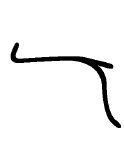
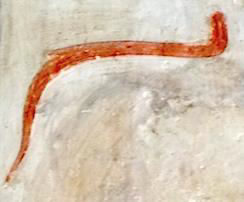
OccID = 2280
Monument : Rekhmire TT.100
Monument type : Private Tomb
Localisation or provenance : Sheikh Abd el-Gurna
Period : Dynasty XVIII
Reign(s) : Thutmose III - Amenhotep II
Approximate date : 1479 - 1400
ExemplarID = 128 - statistical relevance rating : *****
Colours used : red


OccID = 1650
Monument : Tjanuni TT.74
Monument type : Private Tomb
Localisation or provenance : Sheikh Abd el-Gurna
Period : Dynasty XVIII
Reign(s) : Thutmose IV
Approximate date : 1400 - 1390
ExemplarID = 129 - statistical relevance rating : ***
Colours used : red, outline black


OccID = 2335
Monument : Rekhmire TT.100
Monument type : Private Tomb
Localisation or provenance : Sheikh Abd el-Gurna
Period : Dynasty XVIII
Reign(s) : Thutmose III - Amenhotep II
Approximate date : 1479 - 1400
ExemplarID = 130 - statistical relevance rating : ***
Colours used : yellow


OccID = 3501
Monument : Amenhotep III KV.22
Monument type : Royal Tomb
Localisation or provenance : Valley of the Kings
Period : Dynasty XVIII
Reign(s) : Amenhotep III
Approximate date : 1390 - 1352
ExemplarID = 303 - statistical relevance rating : ***
Colours used : leg red, hoof blue


OccID = 2336
Monument : Rekhmire TT.100
Monument type : Private Tomb
Localisation or provenance : Sheikh Abd el-Gurna
Period : Dynasty XVIII
Reign(s) : Thutmose III - Amenhotep II
Approximate date : 1479 - 1400
ExemplarID = 131 - statistical relevance rating : ***
Colours used : red


OccID = 1311
Monument : Sarenput II
Monument type : Private Tomb
Localisation or provenance : Elephantine
Period : Dynasty XII
Reign(s) : Amenemhat II
Approximate date : 1911 - 1877
ExemplarID = 304 - statistical relevance rating : **
Colours used : hide white with black spots and bottom edge blue, tail red, arrow yellow with red arrowhead and black flights


OccID = 1455
Monument : Sobekhotep TT.63
Monument type : Private Tomb
Localisation or provenance : Sheikh Abd el-Gurna
Period : Dynasty XVIII
Reign(s) : Thutmose IV
Approximate date : 1400 - 1390
ExemplarID = 133 - statistical relevance rating : *****
Colours used : skin white with black(?) spots, ties at both ends red


OccID = 1494
Monument : Khonsou-Tefnakht E.586
Monument type : Coffin
Localisation or provenance : El Hibeh
Period : Dynasty XXVII
Reign(s) : ?
Approximate date : 525 - 404
ExemplarID = 134 - statistical relevance rating : *****
Colours used : skins green, knot red
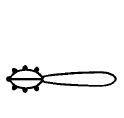

OccID = 3176
Monument : Penmaât
Monument type : Mummy board
Localisation or provenance : Sheikh Abd el-Gurna
Period : Dynasty XXII
Reign(s) : Osorkon I - ?
Approximate date : 945 - 715
ExemplarID = 136 - statistical relevance rating : ****
Colours used : belly green, teats blue, tail red


OccID = 1447
Monument : Sobekhotep TT.63
Monument type : Private Tomb
Localisation or provenance : Sheikh Abd el-Gurna
Period : Dynasty XVIII
Reign(s) : Thutmose IV
Approximate date : 1400 - 1390
ExemplarID = 137 - statistical relevance rating : ****
Colours used : red


OccID = 1651
Monument : Tjanuni TT.74
Monument type : Private Tomb
Localisation or provenance : Sheikh Abd el-Gurna
Period : Dynasty XVIII
Reign(s) : Thutmose IV
Approximate date : 1400 - 1390
ExemplarID = 19 - statistical relevance rating : ****
Colours used : red, white appendages and inner markings


OccID = 2073
Monument : Ramses I KV.16
Monument type : Royal Tomb
Localisation or provenance : Valley of the Kings
Period : Dynasty XIX
Reign(s) : Ramses I
Approximate date : 1295 - 1294
ExemplarID = 18 - statistical relevance rating : ****
Colours used : white with red markings


OccID = 2475
Monument : Menna TT.69
Monument type : Private Tomb
Localisation or provenance : Sheikh Abd el-Gurna
Period : Dynasty XVIII
Reign(s) : Thutmose IV
Approximate date : 1400 - 1390
ExemplarID = 139 - statistical relevance rating : ****
Colours used : heart red, windpipe green


OccID = 3170
Monument : Penmaât
Monument type : Mummy board
Localisation or provenance : Sheikh Abd el-Gurna
Period : Dynasty XXII
Reign(s) : Osorkon I - ?
Approximate date : 945 - 715
ExemplarID = 141 - statistical relevance rating : ****
Colours used : heart red, markings white, windpipe outline red, fill white


OccID = 1223
Monument : Horemheb KV.57
Monument type : Royal Tomb
Localisation or provenance : Valley of the Kings
Period : Dynasty XVIII
Reign(s) : Horemheb
Approximate date : 1323 - 1295
ExemplarID = 140 - statistical relevance rating : ****
Colours used : lower part white with red markings, upper part green


OccID = 1564
Monument : Khonsou-Tefnakht E.586
Monument type : Coffin
Localisation or provenance : El Hibeh
Period : Dynasty XXVII
Reign(s) : ?
Approximate date : 525 - 404
ExemplarID = 142 - statistical relevance rating : ****
Colours used : lungs white or yellow with blue horizontal lines, windpipe red


OccID = 1314
Monument : Sarenput II
Monument type : Private Tomb
Localisation or provenance : Elephantine
Period : Dynasty XII
Reign(s) : Amenemhat II
Approximate date : 1911 - 1877
ExemplarID = 305 - statistical relevance rating : ****
Colours used : bones red, spinal cord white


OccID = 1895
Monument : Peftjauneith
Monument type : Coffin
Localisation or provenance : Sais
Period : Dynasty XXVI
Reign(s) : ?
Approximate date : 664 - 525
ExemplarID = 144 - statistical relevance rating : ****
Colours used : cord and vertebrae red, centre (marrow?) white


OccID = 3596
Monument : Ramses IV KV.2
Monument type : Royal Tomb
Localisation or provenance : Valley of the Kings
Period : Dynasty XX
Reign(s) : Ramses IV
Approximate date : 1153 - 1147
ExemplarID = 343 - statistical relevance rating : *
Colours used : red
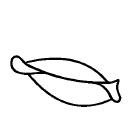

OccID = 2339
Monument : Rekhmire TT.100
Monument type : Private Tomb
Localisation or provenance : Sheikh Abd el-Gurna
Period : Dynasty XVIII
Reign(s) : Thutmose III - Amenhotep II
Approximate date : 1479 - 1400
ExemplarID = 145 - statistical relevance rating : **
Colours used : bone pink, meat red
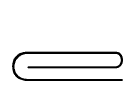

OccID = 1906
Monument : Peftjauneith
Monument type : Coffin
Localisation or provenance : Sais
Period : Dynasty XXVI
Reign(s) : ?
Approximate date : 664 - 525
ExemplarID = 306 - statistical relevance rating : ****
Colours used : black


OccID = 3897
Monument : Rekhmire TT.100
Monument type : Private Tomb
Localisation or provenance : Sheikh Abd el-Gurna
Period : Dynasty XVIII
Reign(s) : Thutmose III - Amenhotep II
Approximate date : 1479 - 1400
ExemplarID = 308 - statistical relevance rating : *****
Colours used : red


OccID = 1834
Monument : Peftjauneith
Monument type : Coffin
Localisation or provenance : Sais
Period : Dynasty XXVI
Reign(s) : ?
Approximate date : 664 - 525
ExemplarID = 148 - statistical relevance rating : *
Colours used : rear of lion yellow, standard black with red cloth
Group G contains fifty-seven signs of which twenty-nine (51%) possess database occurrences, all with images. When examining Gardiner’s extensive list of bird hieroglyphs (EG 545), one might be forgiven for thinking that many of these signs are found frequently in monumental or funerary inscriptions. In fact, this is not the case. Apart from the frequent use of G1, G5, G17, G36, G39 and G43, all with more than ten database occurrences, eleven signs appear only once in the corpus.
The Egyptians were remarkable observers of nature, no more so than in their many images of bird life. Probably the variety and beauty of bird plumage inspired the artists to transcend the rigidity of conventional representation and to produce some of the most beautiful painted scenes to be found in the ancient world (e.g. Tiradritti 1999, 60; Tiradritti 2008, 275). This desire for naturalistic accuracy in wall paintings of birds was carried over into the miniature world of polychrome hieroglyphs. Despite the small size and limited palette available to the scribe-painters, some occurrences show a remarkable level of detail and accuracy.
This group displays mostly naturalistic imagery. Consequently, an attempt has been made to correlate the different occurrences with photographic and taxonomic data obtained from several different sources:
• Houlihan (2001) provides a summary introduction to bird species as observed in Egyptian iconography.
• Houlihan (1986) is still the most complete and scientific work on the portrayal of birds in Ancient Egypt.
• Bailleul-LeSuer (2012) is the extended catalogue of an exhibition held at the Oriental Institute of Chicago and provides an up-to-date collection of articles concerning all aspects of avian life in Ancient Egypt including chapters on symbolism and mythology. There is also in this work an interesting contribution by Wyatt (2012) on the identification of species from the point of view of an ornithologist. He claims that several species could be represented by one hieroglyph and cites the example of the swallow G36, represented on the south and east wall of the tomb of Baqet III at Beni-Hassan by at least four different species (Wyatt 2012, 87). This observation is confirmed in several occurrences in the database, where more than one species or sub-species is portrayed by one particular hieroglyph (e.g. the falcon G5 or the vulture G14).
• Avibase is an online database, providing taxonomic and photographic data concerning present day living species (www.avibase.bsc-eoc.org).
The style used for bird hieroglyphs falls into one of three categories:
1. Naturalistic.
Hieroglyphs correspond accurately to a particular species. Examples are to be found in several occurrences of the barn-owl G17
and the pintail G39.
2. Semi-naturalistic.
An otherwise accurate image of a particular species has blue wings. This metaphorical use of blue for the wings probably symbolises the association of birds with the sky (in the same way that desert animals such as the hare (E34) are often coloured like sand: yellow with dark spots). Bird examples are the vulture G1 and the ibis G25.
3. Metaphorical.
Completely non-naturalistic colouring (usually red) is used for the entire bird. Examples are the sparrow G37 and the cormorant G35. The sparrow was considered to be the embodiment of evil and is therefore coloured red to indicate “inferiority, danger, chaos, aggression” (Goldwasser 2002, 20; David 2000). The cormorant’s red colour probably indicates a combination of modern-day egyptological mis-identification (this bird is more likely to be an African darter (Houlihan 1986, 9)) and scribal inaccuracy due to the exotic nature of the species (see Ex. G35).
For the naturalistic and semi-naturalistic categories, the exact assignation of a species to an exemplar is not always straightforward. Minor inaccuracies in the use of colours can prevent precise identification. However, given the limited palette available to the scribe-painters as well as the reduced size of many of the exemplars, the level of accuracy achieved is quite remarkable.
One of the devices used by the scribe-painters gives an insight into the way the Ancient Egyptians viewed colours. Several exemplars show that the use of colour to portray texture was just as important as the simple reproduction of surface colour. For instance in Ex. G21 , the guinea-fowl, the scribe-painter has resorted to a mixture of blue, black and green to represent the iridescent, glossy sheen of the bird’s plumage. The same insistence on graphic accuracy can be seen in Ex. G47, the duckling, where the “goose bumps” of the bird’s naked skin have been skilfully reproduced by stippling the pink surface with small red dots.
The Dynasty IV exemplar of G7 a falcon on a standard R12 shows some interesting detail, absent from later representations of similar cult statues. The falcon is most likely to be a cult figure as the colour of the bird and the plinth on which it stands suggest stone. The standard itself is red, representing wood. There appears to be a platform at the front, very similar to O31 the hieroglyph for a door with its even wooden slats. On top of the platform is an oval object painted white which could be an ostrich egg (cf. Ex.H8).
A particularly interesting sign is G32 a heron on a perch. This composite sign shows a heron in a typical attitude as it fishes from a vantage-point, in this case from what appears to be some sort of man-made, wooden post. The shape of the post, especially in the occurrence from the tomb of Rekhmire (TT.100, Mon.39) is very similar to the unclassified sign Aa21, described by Gardiner as a carpenter’s tool (EG 542). The colour red, used for the post, suggests something made of wood. For a full discussion of this object, see the commentary on Ex. Aa21.


OccID = 3183
Monument : Penmaât
Monument type : Mummy board
Localisation or provenance : Sheikh Abd el-Gurna
Period : Dynasty XXII
Reign(s) : Osorkon I - ?
Approximate date : 945 - 715
ExemplarID = 150 - statistical relevance rating : ****
Colours used : head red, eye and beak black, wing blue with outline black, underparts white with outline red, feet red


OccID = 1439
Monument : Sobekhotep TT.63
Monument type : Private Tomb
Localisation or provenance : Sheikh Abd el-Gurna
Period : Dynasty XVIII
Reign(s) : Thutmose IV
Approximate date : 1400 - 1390
ExemplarID = 310 - statistical relevance rating : ***
Colours used : head and beak yellow with red spots, breast and wing white, legs yellow, red outline


OccID = 2295
Monument : Rekhmire TT.100
Monument type : Private Tomb
Localisation or provenance : Sheikh Abd el-Gurna
Period : Dynasty XVIII
Reign(s) : Thutmose III - Amenhotep II
Approximate date : 1479 - 1400
ExemplarID = 152 - statistical relevance rating : **
Colours used : sickle green (?), vulture blue with head and feet yellow


OccID = 3321
Monument : Penmaât
Monument type : Mummy board
Localisation or provenance : Sheikh Abd el-Gurna
Period : Dynasty XXII
Reign(s) : Osorkon I - ?
Approximate date : 945 - 715
ExemplarID = 153 - statistical relevance rating : ****
Colours used : beak, feet and outline red, body (darkened) yellow
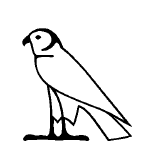

OccID = 1253
Monument : Horemheb KV.57
Monument type : Royal Tomb
Localisation or provenance : Valley of the Kings
Period : Dynasty XVIII
Reign(s) : Horemheb
Approximate date : 1323 - 1295
ExemplarID = 154 - statistical relevance rating : ****
Colours used : green back with red tip to tail, white breast, black and white face, yellow leg, red feet


OccID = 3442
Monument : Iunu G4150
Monument type : Slab stela
Localisation or provenance : Giza
Period : Dynasty IV
Reign(s) : Khufu
Approximate date : 2589 - 2566
ExemplarID = 312 - statistical relevance rating : **
Colours used : falcon yellow, standard upper red, lower yellow, appendage white


OccID = 3047
Monument : Temple of Ramses II (Abydos)
Monument type : Temple
Localisation or provenance : Abydos
Period : Dynasty XIX
Reign(s) : Ramses II
Approximate date : 1279 - 1213
ExemplarID = 155 - statistical relevance rating : *
Colours used : face and breast pale (faded?), head and wing green, tip of tail red, feet yellow, flagellum yellow, standard red


OccID = 2714
Monument : Deir el-Bahri
Monument type : Funerary temple
Localisation or provenance : Deir el-Bahri
Period : Dynasty XVIII
Reign(s) : Hatshepsut
Approximate date : 1473 - 1458
ExemplarID = 313 - statistical relevance rating : *
Colours used : falcon green, head and breast white, tail tips and feet red, collar blue, green, red, green, blue, knots blue and red, string red


OccID = 3178
Monument : Penmaât
Monument type : Mummy board
Localisation or provenance : Sheikh Abd el-Gurna
Period : Dynasty XXII
Reign(s) : Osorkon I - ?
Approximate date : 945 - 715
ExemplarID = 156 - statistical relevance rating : **
Colours used : falcon face white, markings black, wing blue, tail green, underparts white, feet white with outline red, sun disk red , outer ring white, horizontal (and diagonal) bars red


OccID = 2089
Monument : Ramses I KV.16
Monument type : Royal Tomb
Localisation or provenance : Valley of the Kings
Period : Dynasty XIX
Reign(s) : Ramses I
Approximate date : 1295 - 1294
ExemplarID = 188 - statistical relevance rating : ****
Colours used : head and neck white, wing blue, tail blue with red tip, breast red, legs white with black stripes, feet black


OccID = 1317
Monument : Sarenput II
Monument type : Private Tomb
Localisation or provenance : Elephantine
Period : Dynasty XII
Reign(s) : Amenemhat II
Approximate date : 1911 - 1877
ExemplarID = 314 - statistical relevance rating : *
Colours used : feathers white, inner detail blue, tip of tail blue, basket green


OccID = 2713
Monument : Deir el-Bahri
Monument type : Funerary temple
Localisation or provenance : Deir el-Bahri
Period : Dynasty XVIII
Reign(s) : Hatshepsut
Approximate date : 1473 - 1458
ExemplarID = 315 - statistical relevance rating : **
Colours used : vulture head white, back blue, wing-tip green, breast red, underparts white, legs blue, cobra yellow, ventral stripe white, baskets green


OccID = 2494
Monument : Nakht TT.52
Monument type : Private Tomb
Localisation or provenance : Sheikh Abd el-Gurna
Period : Dynasty XVIII
Reign(s) : Thutmose IV
Approximate date : 1400 - 1390
ExemplarID = 158 - statistical relevance rating : ****
Colours used : face and breast white, markings and outlines red, top of head, wing and feet yellow


OccID = 1799
Monument : Peftjauneith
Monument type : Coffin
Localisation or provenance : Sais
Period : Dynasty XXVI
Reign(s) : ?
Approximate date : 664 - 525
ExemplarID = 159 - statistical relevance rating : ****
Colours used : face white, underparts speckled white, feathers blue, feet yellow


OccID = 1524
Monument : Khonsou-Tefnakht E.586
Monument type : Coffin
Localisation or provenance : El Hibeh
Period : Dynasty XXVII
Reign(s) : ?
Approximate date : 525 - 404
ExemplarID = 160 - statistical relevance rating : **
Colours used : owl yellow, blue and red as G 17, arm red as D 36


OccID = 3181
Monument : Penmaât
Monument type : Mummy board
Localisation or provenance : Sheikh Abd el-Gurna
Period : Dynasty XXII
Reign(s) : Osorkon I - ?
Approximate date : 945 - 715
ExemplarID = 161 - statistical relevance rating : *
Colours used : face, body and wing blue, feet and appendages black, tail and lower wing green


OccID = 3189
Monument : Penmaât
Monument type : Mummy board
Localisation or provenance : Sheikh Abd el-Gurna
Period : Dynasty XXII
Reign(s) : Osorkon I - ?
Approximate date : 945 - 715
ExemplarID = 162 - statistical relevance rating : ****
Colours used : face and throat green, beak black, crest red, wing blue, underparts white with outline red, feet black


OccID = 1663
Monument : Tjanuni TT.74
Monument type : Private Tomb
Localisation or provenance : Sheikh Abd el-Gurna
Period : Dynasty XVIII
Reign(s) : Thutmose IV
Approximate date : 1400 - 1390
ExemplarID = 163 - statistical relevance rating : ****
Colours used : white wings and breast, neck red, face green, beak tail and feet black, outline red, standard red
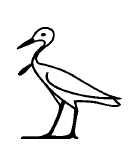

OccID = 3187
Monument : Penmaât
Monument type : Mummy board
Localisation or provenance : Sheikh Abd el-Gurna
Period : Dynasty XXII
Reign(s) : Osorkon I - ?
Approximate date : 945 - 715
ExemplarID = 164 - statistical relevance rating : *****
Colours used : head white with outline black, underparts white with outline red, back blue with outline black, feet red


OccID = 2111
Monument : Ramses I KV.16
Monument type : Royal Tomb
Localisation or provenance : Valley of the Kings
Period : Dynasty XIX
Reign(s) : Ramses I
Approximate date : 1295 - 1294
ExemplarID = 165 - statistical relevance rating : ***
Colours used : heads and wings green, breasts white with red outline, legs and chest appendages black, fill white


OccID = 3725
Monument : Ramses V-VI KV.9
Monument type : Royal Tomb
Localisation or provenance : Valley of the Kings
Period : Dynasty XX
Reign(s) : Ramses V - VI
Approximate date : 1147 - 1136
ExemplarID = 316 - statistical relevance rating : *
Colours used : outline blue, head red, beak, crest and wing blue, breast and legs white (colourless)
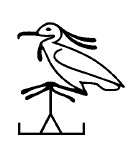

OccID = 3190
Monument : Penmaât
Monument type : Mummy board
Localisation or provenance : Sheikh Abd el-Gurna
Period : Dynasty XXII
Reign(s) : Osorkon I - ?
Approximate date : 945 - 715
ExemplarID = 166 - statistical relevance rating : ***
Colours used : face and underparts white with outline red, wing blue, top of head and back outline black, feet black, perch base and vertical red, triangle sides black
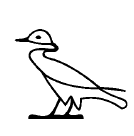

OccID = 2907
Monument : Userhat TT.56
Monument type : Private Tomb
Localisation or provenance : Sheikh Abd el-Gurna
Period : Dynasty XVIII
Reign(s) : Amenhotep II
Approximate date : 1427 - 1400
ExemplarID = 167 - statistical relevance rating : ***
Colours used : red


OccID = 60
Monument : Haremheb TT.78
Monument type : Private Tomb
Localisation or provenance : Sheikh Abd el-Gurna
Period : Dynasty XVIII
Reign(s) : Thutmose III - Amenhotep III
Approximate date : 1479 - 1352
ExemplarID = 168 - statistical relevance rating : ****
Colours used : green-blue with white markings and red bill and feet


OccID = 1506
Monument : Khonsou-Tefnakht E.586
Monument type : Coffin
Localisation or provenance : El Hibeh
Period : Dynasty XXVII
Reign(s) : ?
Approximate date : 525 - 404
ExemplarID = 189 - statistical relevance rating : ****
Colours used : head and legs red, body and wing blue, tail green
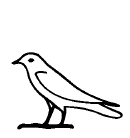

OccID = 3180
Monument : Penmaât
Monument type : Mummy board
Localisation or provenance : Sheikh Abd el-Gurna
Period : Dynasty XXII
Reign(s) : Osorkon I - ?
Approximate date : 945 - 715
ExemplarID = 169 - statistical relevance rating : **
Colours used : red


OccID = 1804
Monument : Peftjauneith
Monument type : Coffin
Localisation or provenance : Sais
Period : Dynasty XXVI
Reign(s) : ?
Approximate date : 664 - 525
ExemplarID = 172 - statistical relevance rating : **
Colours used : head black, back blue, underparts white, legs red
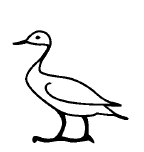

OccID = 2032
Monument : Ramses I KV.16
Monument type : Royal Tomb
Localisation or provenance : Valley of the Kings
Period : Dynasty XIX
Reign(s) : Ramses I
Approximate date : 1295 - 1294
ExemplarID = 171 - statistical relevance rating : ****
Colours used : head and rump red, beak, eye, wings and feet blue, back yellow with blue markings, breast white, fill between feet white

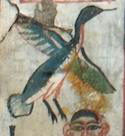
OccID = 3186
Monument : Penmaât
Monument type : Mummy board
Localisation or provenance : Sheikh Abd el-Gurna
Period : Dynasty XXII
Reign(s) : Osorkon I - ?
Approximate date : 945 - 715
ExemplarID = 173 - statistical relevance rating : ****
Colours used : head, back and upper wing blue, lower wing and tail green, underparts white with outline red, feet black

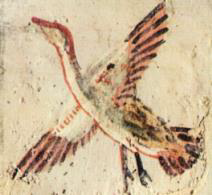
OccID = 1666
Monument : Tjanuni TT.74
Monument type : Private Tomb
Localisation or provenance : Sheikh Abd el-Gurna
Period : Dynasty XVIII
Reign(s) : Thutmose IV
Approximate date : 1400 - 1390
ExemplarID = 317 - statistical relevance rating : ****
Colours used : head and back blue, breast white, wings and tail yellow with black markings, feet black


OccID = 1807
Monument : Peftjauneith
Monument type : Coffin
Localisation or provenance : Sais
Period : Dynasty XXVI
Reign(s) : ?
Approximate date : 664 - 525
ExemplarID = 174 - statistical relevance rating : ***
Colours used : head red, feathers blue, underparts white


OccID = 3185
Monument : Penmaât
Monument type : Mummy board
Localisation or provenance : Sheikh Abd el-Gurna
Period : Dynasty XXII
Reign(s) : Osorkon I - ?
Approximate date : 945 - 715
ExemplarID = 176 - statistical relevance rating : **
Colours used : outline red, eye black, underparts white, wing black markings, feet black


OccID = 1538
Monument : Khonsou-Tefnakht E.586
Monument type : Coffin
Localisation or provenance : El Hibeh
Period : Dynasty XXVII
Reign(s) : ?
Approximate date : 525 - 404
ExemplarID = 175 - statistical relevance rating : **
Colours used : head red, beak blue, wing blue, tail green, breast yellow with blue spots, feet red, claws blue


OccID = 1504
Monument : Khonsou-Tefnakht E.586
Monument type : Coffin
Localisation or provenance : El Hibeh
Period : Dynasty XXVII
Reign(s) : ?
Approximate date : 525 - 404
ExemplarID = 318 - statistical relevance rating : ****
Colours used : yellow with black details, green spots on breast, legs red


OccID = 1468
Monument : Sobekhotep TT.63
Monument type : Private Tomb
Localisation or provenance : Sheikh Abd el-Gurna
Period : Dynasty XVIII
Reign(s) : Thutmose IV
Approximate date : 1400 - 1390
ExemplarID = 177 - statistical relevance rating : ****
Colours used : body yellow, eye, beak and legs red


OccID = 2347
Monument : Rekhmire TT.100
Monument type : Private Tomb
Localisation or provenance : Sheikh Abd el-Gurna
Period : Dynasty XVIII
Reign(s) : Thutmose III - Amenhotep II
Approximate date : 1479 - 1400
ExemplarID = 178 - statistical relevance rating : *
Colours used : body yellow, beak, eye and legs red


OccID = 3052
Monument : Temple of Ramses II (Abydos)
Monument type : Temple
Localisation or provenance : Abydos
Period : Dynasty XIX
Reign(s) : Ramses II
Approximate date : 1279 - 1213
ExemplarID = 179 - statistical relevance rating : *
Colours used : chick yellow with red feet, arm red

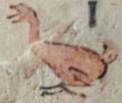
OccID = 1668
Monument : Tjanuni TT.74
Monument type : Private Tomb
Localisation or provenance : Sheikh Abd el-Gurna
Period : Dynasty XVIII
Reign(s) : Thutmose IV
Approximate date : 1400 - 1390
ExemplarID = 180 - statistical relevance rating : ****
Colours used : pale red, outline red and black, feet black


OccID = 2349
Monument : Rekhmire TT.100
Monument type : Private Tomb
Localisation or provenance : Sheikh Abd el-Gurna
Period : Dynasty XVIII
Reign(s) : Thutmose III - Amenhotep II
Approximate date : 1479 - 1400
ExemplarID = 181 - statistical relevance rating : ***
Colours used : body yellow, head red
This small group, containing only eight signs in Gardiner, has occurrences for three of them (38%) : H1, H6 and H8.
H8 represents an egg, probably that of the ostrich or of the goose. The egg is coloured white or yellow but there appears to be no difference in meaning or symbolism, as the occurrences from Mon.25 (Horemheb KV57) show. In these inscriptions, both white and yellow variants are used indiscriminately as the feminine determinative of the goddess Isis. Whether ostrich flesh or ostrich eggs were eaten remains unknown, but empty ostrich eggs were certainly prized as vessels from as early as pre-dynastic times (Bailleul-LeSuer 2012, 132; Phillips 2000, 332-333)). The goose egg was believed to be the cosmic egg from whence arose the sun-god at the moment of creation and the ostrich egg could also adopt the same symbolism (Bailleul-LeSuer 2012, 132).
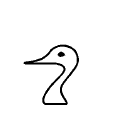

OccID = 1576
Monument : Khonsou-Tefnakht E.586
Monument type : Coffin
Localisation or provenance : El Hibeh
Period : Dynasty XXVII
Reign(s) : ?
Approximate date : 525 - 404
ExemplarID = 182 - statistical relevance rating : **
Colours used : head red, beak and neck blue, eye blue and white


OccID = 2097
Monument : Ramses I KV.16
Monument type : Royal Tomb
Localisation or provenance : Valley of the Kings
Period : Dynasty XIX
Reign(s) : Ramses I
Approximate date : 1295 - 1294
ExemplarID = 183 - statistical relevance rating : ****
Colours used : stem yellow with red outline, feathers white with black tips


OccID = 1877
Monument : Peftjauneith
Monument type : Coffin
Localisation or provenance : Sais
Period : Dynasty XXVI
Reign(s) : ?
Approximate date : 664 - 525
ExemplarID = 184 - statistical relevance rating : ****
Colours used : quill yellow, feathers green
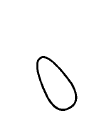

OccID = 1198
Monument : Horemheb KV.57
Monument type : Royal Tomb
Localisation or provenance : Valley of the Kings
Period : Dynasty XVIII
Reign(s) : Horemheb
Approximate date : 1323 - 1295
ExemplarID = 187 - statistical relevance rating : ****
Colours used : white


OccID = 1199
Monument : Horemheb KV.57
Monument type : Royal Tomb
Localisation or provenance : Valley of the Kings
Period : Dynasty XVIII
Reign(s) : Horemheb
Approximate date : 1323 - 1295
ExemplarID = 186 - statistical relevance rating : ****
Colours used : yellow
Group I is well represented in the database. Sixteen out of nineteen signs (84%) have at least one occurrence and eleven possess coloured images. The group contains several very common signs such as the horned viper I9 and the cobra I10 as well as several unusual ones such as the tadpole I8, the frog I7A, sitting on or in a basket and the freshwater turtle I2. The unique occurrence of I2 recorded here is somewhat amusing as it has six legs. Presumably the scribe- painter had never seen one in the flesh or else he mistook the hieroglyph for some kind of insect. However, in this case, the context is clear : Styw - a tortoise (FCD 273).
The crocodile I3 presents an interesting example of colour symbolism. Early Dynasty III occurrences use yellow but the symbolism is unclear. Most later occurrences are dark green or black which are a good approximation to naturalistic dark grey-bronze However, one occurrence from the tomb of Rekhmire (Mon.39 - TT.100) is red, symbolising the dangerous and aggressive nature of the Nile crocodile: an apex predator. The same red can be seen in the exemplar I4 which shows the crocodile god Sobek on top of a shrine. The face of the god is golden, as is usual for gods’ flesh. The body is bright red, either as a symbol of danger and aggression, or as a naturalistic portrayal of a prestigious red cloth, draped over the statue of the god.
The crocodile skin I6 is black in the only database occurrence (which has no coloured image, only a description). Not only is this a fair approximation to the natural colour, but it is also the sign for a common colour term, translated as “black” - km (FCD 286, Wb V, 122-124). This is the same black referred to when describing the alluvium left behind when the Nile flood recedes and which gives rise to the common name given by the Egyptians to their habitat : kmt “the black (land)”. It should be noted that this black silt is often coloured dark blue when used to indicate mud-brick (e.g.. the house O1), as are the ripples of water N35 which are sometimes black and sometimes dark blue. So km (dark blue or black) is a good colour to use for a crocodile’s dark grey-bronze skin.

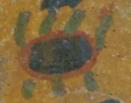
OccID = 3840
Monument : Ta-ouseret-em-per-nesou (aka Unnefer).
Monument type : Coffin
Localisation or provenance : Bab el-Gasus
Period : Dynasty XXI
Reign(s) : ?
Approximate date : 1069 - 945
ExemplarID = 319 - statistical relevance rating : *
Colours used : blue, legs green
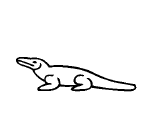

OccID = 1526
Monument : Khonsou-Tefnakht E.586
Monument type : Coffin
Localisation or provenance : El Hibeh
Period : Dynasty XXVII
Reign(s) : ?
Approximate date : 525 - 404
ExemplarID = 191 - statistical relevance rating : ****
Colours used : green (slightly paler on belly), blue details and spines on back and tail


OccID = 2350
Monument : Rekhmire TT.100
Monument type : Private Tomb
Localisation or provenance : Sheikh Abd el-Gurna
Period : Dynasty XVIII
Reign(s) : Thutmose III - Amenhotep II
Approximate date : 1479 - 1400
ExemplarID = 192 - statistical relevance rating : ****
Colours used : faded red? (two similar occurrences)


OccID = 1458
Monument : Sobekhotep TT.63
Monument type : Private Tomb
Localisation or provenance : Sheikh Abd el-Gurna
Period : Dynasty XVIII
Reign(s) : Thutmose IV
Approximate date : 1400 - 1390
ExemplarID = 193 - statistical relevance rating : *
Colours used : crocodile red with yellow snout, shrine white with red door and red details on cornice


OccID = 190
Monument : Wepemnefret G1201
Monument type : Slab stela
Localisation or provenance : Giza
Period : Dynasty IV
Reign(s) : Khufu
Approximate date : 2589 - 2566
ExemplarID = 320 - statistical relevance rating : *
Colours used : yellow (or green?), red markings, black eye, basket blue(?)


OccID = 1672
Monument : Tjanuni TT.74
Monument type : Private Tomb
Localisation or provenance : Sheikh Abd el-Gurna
Period : Dynasty XVIII
Reign(s) : Thutmose IV
Approximate date : 1400 - 1390
ExemplarID = 194 - statistical relevance rating : *****
Colours used : yellow, belly white, outline and details red and black, spots on back red, horns black


OccID = 3195
Monument : Penmaât
Monument type : Mummy board
Localisation or provenance : Sheikh Abd el-Gurna
Period : Dynasty XXII
Reign(s) : Osorkon I - ?
Approximate date : 945 - 715
ExemplarID = 195 - statistical relevance rating : ****
Colours used : back and top of head black, centre white, belly red


OccID = 2053
Monument : Ramses I KV.16
Monument type : Royal Tomb
Localisation or provenance : Valley of the Kings
Period : Dynasty XIX
Reign(s) : Ramses I
Approximate date : 1295 - 1294
ExemplarID = 206 - statistical relevance rating : ****
Colours used : yellow, back outlined in black, black markings on head and neck

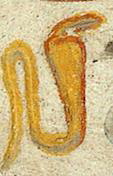
OccID = 3656
Monument : Ramses V-VI KV.9
Monument type : Royal Tomb
Localisation or provenance : Valley of the Kings
Period : Dynasty XX
Reign(s) : Ramses V - VI
Approximate date : 1147 - 1136
ExemplarID = 321 - statistical relevance rating : ***
Colours used : yellow, details red


OccID = 3197
Monument : Penmaât
Monument type : Mummy board
Localisation or provenance : Sheikh Abd el-Gurna
Period : Dynasty XXII
Reign(s) : Osorkon I - ?
Approximate date : 945 - 715
ExemplarID = 197 - statistical relevance rating : **
Colours used : back and head black, centre white, belly red


OccID = 3604
Monument : Ramses IV KV.2
Monument type : Royal Tomb
Localisation or provenance : Valley of the Kings
Period : Dynasty XX
Reign(s) : Ramses IV
Approximate date : 1153 - 1147
ExemplarID = 323 - statistical relevance rating : *
Colours used : snake green, fill yellow, knives red


OccID = 1849
Monument : Peftjauneith
Monument type : Coffin
Localisation or provenance : Sais
Period : Dynasty XXVI
Reign(s) : ?
Approximate date : 664 - 525
ExemplarID = 198 - statistical relevance rating : *
Colours used : standard black with red cloth, cobra yellow with red spots, feather yellow outline with blue(?) interior

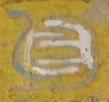
OccID = 2651
Monument : Nefersekheru TT.296
Monument type : Private Tomb
Localisation or provenance : Khokha
Period : Dynasty XIX
Reign(s) : Ramses II
Approximate date : 1279 - 1213
ExemplarID = 199 - statistical relevance rating : *
Colours used : green, coils filled white
Group K contains six fish hieroglyphs of which five (K1, K2, K3, K4 and K5) possess occurrences in the database (83%). Precise identification is difficult but the work of Houlihan (1996, 129-133) and the taxonomic online database “fishbase" (www.fishbase.org) have proved most useful.
K1 the Tilapia (Tilapia nilotica) is the easiest to identify amongst the exemplars in Group K. The long dorsal fin and the two short ventral ones are distinctive. The context also confirms the reading of the sign as the Tilapia, used in the word “int” (Wb I,93,2) here meaning “valley”, in this case the Western Valley. The natural colouring of the Tilapia is silver-grey (rendered here as pale blue) with pink or red fins and tail. This has been fairly accurately rendered in the K1 exemplar, especially given the restricted palette available. The red colouring may have influenced the Tilapia's association with the sun and Horus, as it accompanied the sun god in his boat while slaying his enemies (Brewer 2001, 534). The Tilapia also has unusual parenting behaviour which heightened the symbolic significance of the fish. After hatching, the fry are held in the parent's (male or female) mouth for protection. They venture out when there is no danger and swim back in at the slightest alarm. The Egyptians took this as a symbol of rebirth and fertility (Houlihan 1996, 133).
K2 the Barbel or Binni (Barbus bynni) is sometimes confused with K4 the Oxyrhynchus (Mormyrus kannume). This at first seems to be the case here, as the natural colour of the Binni is golden yellow whereas the colour used here is blue with pale underparts, just like the Oxyrhynchus. The disposition and shape of the fins would indicate the Binni, and the characteristic elongated snout of the Oxyrhynchus is absent. The context , however, points to yet another species, often used in the expression stt mHit (Wb II, 65, 11) “a fish sting (during a trip to the swamps)”. The Wörterbuch states that three different varieties of fish hieroglyphs are regularly used in this expression. The most likely candidate therefore in this context would be the Electric catfish (Malapterurus electrica) K5 (Houlihan 1996, 129), yet the colouring does not match up (the Catfish is brown, not blue).
K3 the Flathead grey mullet (Mugil cephalus) is clearly identifiable from the naturalistic colouring used here and by the accurate disposition of the dorsal and ventral fins. This prized edible fish is found in coastal waters as well as far up river and in brackish pools and lagoons.
K4 the Oxyrhynchus (Mormyrus kannume) is also found drawn with an exaggeratedly elongated tail as in the exemplar. It is identified especially by the elongated snout and the red fins and tail. The name of the fish XAt, as well as the hieroglyph, is found in several homophones, such as XAt “disease” and XAt “corpse” (FCD 200, Wb III, 359-361). This association with death and disease probably influenced the taboos that are found for this fish (see infra).
K5 adds to the confusion between these fish hieroglyphs. Both Gardiner (1963, 477) and Houlihan (1996, 129) attribute this sign to the Elephant fish (Petrocephalus bane/bovei). However, the context here is bs (Wb I, 473, 1) which according to the Wörterbuch appears to be determined by the Oxyrhynchus K4.
This unusual confusion of species and colouring, rarely seen in any other animal group apart from the Birds Group G, in which the Pintail G39 and the White-fronted goose G38 are regularly confused. This raises some interesting questions. Firstly, we may question the accuracy of the Wörterbuch in its use of hand-drawn signs, where for fish, the shape, fin details and colouring are the only reliable criteria for identification. Secondly, we may suspect the scribe-painters of deliberately or accidentally confusing signs.
This confusion could be attributed to two major causes:
1. A lack of ichthyological knowledge.
This would seem unlikely, as fish were a common sight in the markets and riverside villages. According to the Papyrus Harris (Dynasty XX), Ramses III during his 31-year reign provided the Theban temples with a total of 474,200 fish (Houlihan 1996, 131). Such quantities show that fishing was the object of a major commerce. The scribe-painters would therefore have been regularly reminded of the taxonomic details of the many varieties to be found in the Nile. More proof of detailed ichthyological knowledge comes from the
decoration of the Dynasty XVIII temple of Hatshepsut at Deir el-Bahri, where forty different species can be identified with ease (Danelius and Steinitz 1967).
2. A series of taboos.
Fish seem to have been the objects of many taboos, both religious and dietary. For instance, the Nile Perch (Lates niloticus) was associated with the goddess Neith and thus viewed as sacred and inedible. In Ptolemaic times, the Oxyrhynchus was in some places forbidden for consumption as it was supposed to have swallowed the penis of the god Osiris when his body was dismembered by his brother Seth (Plutarch De Iside et Osiride, 358B=18). The same author also records the case of hostilities between the Oxyrhynchus-eating inhabitants of Kynonpolis and their neighbours in the town of Oxyrhynchus where that fish was worshipped (De Iside et Osiride, 380B=72). These events took place later than the period under investigation here, but are indicative of the strength of this kind of taboo. The scribe- painters may thus have avoided certain taboos by deliberately making the fishes’ identification difficult. There are even cases of the deliberate omission of fish hieroglyphs from inscriptions close to the burial chamber (Houlihan 1996, 130). It should also be noted that fish are never mentioned in offering lists even though they are sometimes portrayed on offering tables. Evidently, there are strong taboos at work here.


OccID = 2963
Monument : Userhat TT.56
Monument type : Private Tomb
Localisation or provenance : Sheikh Abd el-Gurna
Period : Dynasty XVIII
Reign(s) : Amenhotep II
Approximate date : 1427 - 1400
ExemplarID = 200 - statistical relevance rating : ****
Colours used : blue with gills, tips of fins and tail red


OccID = 2779
Monument : Menkheper TT.79
Monument type : Private Tomb
Localisation or provenance : Sheikh Abd el-Gurna
Period : Dynasty XVIII
Reign(s) : Thutmose III - Amenhotep II
Approximate date : 1479 - 1400
ExemplarID = 201 - statistical relevance rating : **
Colours used : body blue, belly white, fins red


OccID = 191
Monument : Wepemnefret G1201
Monument type : Slab stela
Localisation or provenance : Giza
Period : Dynasty IV
Reign(s) : Khufu
Approximate date : 2589 - 2566
ExemplarID = 324 - statistical relevance rating : **
Colours used : grey back, white belly, red scales


OccID = 3658
Monument : Ramses V-VI KV.9
Monument type : Royal Tomb
Localisation or provenance : Valley of the Kings
Period : Dynasty XX
Reign(s) : Ramses V - VI
Approximate date : 1147 - 1136
ExemplarID = 326 - statistical relevance rating : ***
Colours used : body blue (or green?), fins, tail and snout red
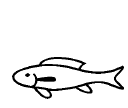

OccID = 2427
Monument : Rekhmire TT.100
Monument type : Private Tomb
Localisation or provenance : Sheikh Abd el-Gurna
Period : Dynasty XVIII
Reign(s) : Thutmose III - Amenhotep II
Approximate date : 1479 - 1400
ExemplarID = 202 - statistical relevance rating : *
Colours used : pink with red dots and markings
Group L contains seven signs, with three database occurrences (43%). The only signs from this small group represented in the database are L1 the dung beetle or scarab, L2 the bee and L7 the scorpion. All three show naturalistic colouring, even though the bee’s yellow is sometimes rendered in red-orange and the black body parts in blue.
The scarab L1 presents an interesting and unusual case of erroneous observation, either accidental or deliberate. Contrary to Egyptian canonical imagery, the scarab does not push a ball of dung with its front legs, but always uses its back legs for this purpose. Maybe the strange idea of backwards motion coupled with a rather undignified use of the rear legs caused the Egyptians to modify this characteristic in their imagery. The second misconception concerns the ball of dung. The Egyptians considered this to be not only a metaphor for the sun and its diurnal motion, but also a symbol of birth, rebirth and creation. The latter symbol is due to the scarab’s habit of laying its eggs in dung on which the larvae feed before emerging as young beetles. This dung, however, is not the same as the ball seen in the sun metaphor, but is in fact a pear-shaped pellet of sheep’s excrement. The perfectly round ball, of cattle dung, is used exclusively for the adult’s food (Bianchi 2001, 179). However, these distinctions were probably of little importance for the Egyptians, and the scarab remained a powerful symbol of creation, rebirth and solar imagery throughout the Pharaonic period (Wilkinson 1992, 113).
The exemplar of the bee L2 displays an attempt at naturalistic colouring. The striped colouring of the abdomen is particularly well reproduced. The scribe-painter, however, seems to have had a problem with the wings which are in reality virtually transparent. They have been coloured orange with red details and a dark blue edge. Although this is totally non-naturalistic, it seems unlikely that any symbolic use of colour is intended. It seems more probable that the scribe-painter was inspired by two adjacent signs : a pair of cow’s ears ( Ex.F21 from the same monument) which have been coloured in exactly the same way (and which share the same form). The bee has been mutilated on purpose. The head and antennae are missing, thus rendering the insect harmless, even though the bee was considered beneficial with positive solar and regal associations (Wilkinson 1992, 115). However, protecting the deceased from stings was obviously of greater importance.
The scorpion L7 in the unique database occurrence is coloured yellow, thus identifying it probably as the Deathstalker (Leiurus quinquestriatus). In this hieroglyph, the sting and tail as well as the two pairs of side legs have been removed, in order to prevent the creature from harming either the reader or the dedicatee of the inscription (in this case Ramses II, in his temple at Abydos). This may seem somewhat paradoxical as the sign in this context is used as a determinative in the name srqt, the scorpion goddess Serket who uses her venom to protect the pharaoh.


OccID = 1901
Monument : Peftjauneith
Monument type : Coffin
Localisation or provenance : Sais
Period : Dynasty XXVI
Reign(s) : ?
Approximate date : 664 - 525
ExemplarID = 203 - statistical relevance rating : *****
Colours used : black


OccID = 1676
Monument : Tjanuni TT.74
Monument type : Private Tomb
Localisation or provenance : Sheikh Abd el-Gurna
Period : Dynasty XVIII
Reign(s) : Thutmose IV
Approximate date : 1400 - 1390
ExemplarID = 204 - statistical relevance rating : ****
Colours used : rear yellow with red outline and black stripes, thorax white below blue above, wings yellow with red stripes


OccID = 3502
Monument : Amenhotep III KV.22
Monument type : Royal Tomb
Localisation or provenance : Valley of the Kings
Period : Dynasty XVIII
Reign(s) : Amenhotep III
Approximate date : 1390 - 1352
ExemplarID = 327 - statistical relevance rating : ****
Colours used : outline, legs, antennae, abdomen stripes dark blue, fill yellow


OccID = 3081
Monument : Temple of Ramses II (Abydos)
Monument type : Temple
Localisation or provenance : Abydos
Period : Dynasty XIX
Reign(s) : Ramses II
Approximate date : 1279 - 1213
ExemplarID = 205 - statistical relevance rating : *
Colours used : yellow
Group M is particularly well represented in the database. Thirty-nine out of forty-five signs (87%) have at least one occurrence and thirty-four possess coloured images. The group contains several very common signs.
It is difficult to assign particular species to some of the signs in this group, especially as they often appear to be generic representations. This is the case for the tree M1 which Baum (1989, 3 passim) tentatively identifies as a sycamore (ficus sycomorus). However, this sign is mainly used as a determinative for many different species (Goldwasser 2002, 39-55). The exemplar shown here has green leaves and traces of red for the trunk and branches.
The same generic use is found for the bunch of herbs M2. The flower heads can be red or green but no precise identification is possible.
From a strict botanical point of view, the lotus flower M9 is in fact a waterlily (Nymphaea cerulea) and not a lotus (Nelumbo sp.). However, the term "blue lotus" is used throughout egyptological literature (Harer 2001, 304). The exemplar seen here uses beautifully detailed naturalistic colouring.
The complete lotus plant M12 is anchored in what appears to be the loaf of bread X1. Gardiner (EG 480) interprets this as the rhizome despite the lack of similarity, but it could also be a mound of earth from whence springs life in the form of a lotus (cf. Ex.X1). The daily blossoming of the lotus was in fact a symbol of the rebirth of the rising sun (Harer 2001, 305).
The flowering reed M17, whose colour-scheme is remarkably consistent throughout most of the period under study, has a blue stem with green fronds. It has proved to be one of the most useful markers for green and blue, facilitating the identification and assignation of these colours wherever they are indistinct. It is also one of the most frequently encountered signs, with forty-two out of fifty- two monuments (81%) possessing at least one occurrence. The designation “flowering reed” is a misnomer, according to Wendrich (2000, 254-255). She prefers to identify the sign as “the large feather-shaped leaves of the date-palm (Phoenix dactylifera)”. However, the sign showing reeds growing from the earth, M20, drawn and coloured in exactly the same way as M17, negates this suggestion.
The similar sign M18 which has a forward-facing foot extending out from the base of the stem, presents some interesting features. The colour red marks the foot clearly as a human body-part. The leaf’s stem, however, retains the colour blue (see the first exemplar). This changes to red when the stem takes on the form of a foot (see the second exemplar). This rear foot is preferred by Gardiner in the typographic form (EG 481) although the database occurrences recorded here show both variants to be common. Some variants have a white fill between the stem and the front-facing foot. This may be simply an indication of empty space but it could also symbolise motion (cf. the commentaries on D21, D28 and D54). This latter explanation is reinforced by the reading of the sign as ii with the sense of "to come” (FCD 10; Wb I, 37).
M19 is a curious sign. Gardiner describes it as “heaped conical cakes between reed M17 and sign like U36” (EG 481). It is used as a determinative in words for offering, such as aAbt (FCD 38; Wb I, 167). The first exemplar shown here does not show the fuller’s club U36 but rather what appears to be the mace T3. The reed M17 seems to have disappeared into the structure of what may be an offering table. However the colour of faded green, used for the whole sign does not correspond to this use. In the same way, the zigzag line between the two upright signs can hardly represent conical loaves as these are coloured black of dark blue in most cases (cf. Ex.X2). In the variant shown here, the lines are in fact red, corresponding perhaps to wood and are thus part of the structure and not bread offerings. This second exemplar also appears to have a reed on both sides of the structure and no club or mace. More research is needed in order to grasp the full significance of this hieroglyph.
The signs M22-M28 represent just two different plants. M22 and M22* are identified by Gardiner (EG 482, citing Loret) as the marsh club-rush (Heleocharis palustris). The plant (in the hieroglyph) is distinguished from the sedges (M23-M28) by two side shoots rather than four. It is very dark green in most occurrences. One variant (Mon.27) has red flowers, but these are normally only found on the sedges. This is probably a case of confusion of signs. M23 shows the sedge with four shoots and no flowers. M26-M28 show the sedge with red flowers at the tips of the shoots. M25 appears to be the result of confusion between M24 and M26. The sedges are also mostly green. This is the natural colour of these plants. The flowers can be red-brown, so red is the closest approximation.
The bundle of flax stems M36 shows the blue-green colour of the stems with the golden yellow colour of the ripe bolls. Obviously, these plants have just been harvested and tied together in a bunch using some kind of dried plant fibre cord. The colours open a window onto a precise moment in the cycle of growth and harvesting as the stems are still green and the bolls ripe.
The basket of fruit or grain M39 shows how one sign can be interpreted differently thanks to the colours. The first exemplar (Mon.17 - Dynasty IV) definitely shows a coiled basket (Wendrich 2000, 256) with details of the weaving which has the early canonical colouring of yellow. However the second exemplar (Mon.6 - Dynasty IV) definitely shows a clay pot, as it is coloured red with no detailing. In fact, exactly the same confusion arises for the basket or pot W10 carried on the head of the workman A9 (see the commentary on A9).


OccID = 2274
Monument : Rekhmire TT.100
Monument type : Private Tomb
Localisation or provenance : Sheikh Abd el-Gurna
Period : Dynasty XVIII
Reign(s) : Thutmose III - Amenhotep II
Approximate date : 1479 - 1400
ExemplarID = 207 - statistical relevance rating : ***
Colours used : trunk red (? faded), leaves green


OccID = 1589
Monument : Khonsou-Tefnakht E.586
Monument type : Coffin
Localisation or provenance : El Hibeh
Period : Dynasty XXVII
Reign(s) : ?
Approximate date : 525 - 404
ExemplarID = 275 - statistical relevance rating : ****
Colours used : green


OccID = 2519
Monument : Nakht TT.52
Monument type : Private Tomb
Localisation or provenance : Sheikh Abd el-Gurna
Period : Dynasty XVIII
Reign(s) : Thutmose IV
Approximate date : 1400 - 1390
ExemplarID = 209 - statistical relevance rating : *****
Colours used : red


OccID = 1327
Monument : Sarenput II
Monument type : Private Tomb
Localisation or provenance : Elephantine
Period : Dynasty XII
Reign(s) : Amenemhat II
Approximate date : 1911 - 1877
ExemplarID = 328 - statistical relevance rating : **
Colours used : blue


OccID = 3904
Monument : Rekhmire TT.100
Monument type : Private Tomb
Localisation or provenance : Sheikh Abd el-Gurna
Period : Dynasty XVIII
Reign(s) : Thutmose III - Amenhotep II
Approximate date : 1479 - 1400
ExemplarID = 329 - statistical relevance rating : *
Colours used : M4 black(?), Q3 matting green, bands yellow


OccID = 3531
Monument : Fragment temple Montuhotep II
Monument type : Funerary temple
Localisation or provenance : Deir el-Bahri
Period : Dynasty XI
Reign(s) : Montuhotep II
Approximate date : 2055 - 2004
ExemplarID = 330 - statistical relevance rating : **
Colours used : flowers green, stems red, reeds green, pool faded blue(?)


OccID = 3905
Monument : Rekhmire TT.100
Monument type : Private Tomb
Localisation or provenance : Sheikh Abd el-Gurna
Period : Dynasty XVIII
Reign(s) : Thutmose III - Amenhotep II
Approximate date : 1479 - 1400
ExemplarID = 331 - statistical relevance rating : *
Colours used : stem indistinct, base of flower yellow with red lines, petals green and white
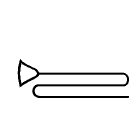

OccID = 2554
Monument : Nakht TT.52
Monument type : Private Tomb
Localisation or provenance : Sheikh Abd el-Gurna
Period : Dynasty XVIII
Reign(s) : Thutmose IV
Approximate date : 1400 - 1390
ExemplarID = 211 - statistical relevance rating : **
Colours used : green


OccID = 803
Monument : Nefret-iabet G1225
Monument type : Slab stela
Localisation or provenance : Giza
Period : Dynasty IV
Reign(s) : Khufu
Approximate date : 2589 - 2566
ExemplarID = 332 - statistical relevance rating : ****
Colours used : stem and base red, leaf yellow


OccID = 3211
Monument : Penmaât
Monument type : Mummy board
Localisation or provenance : Sheikh Abd el-Gurna
Period : Dynasty XXII
Reign(s) : Osorkon I - ?
Approximate date : 945 - 715
ExemplarID = 212 - statistical relevance rating : ****
Colours used : green
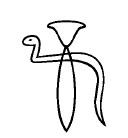

OccID = 3207
Monument : Penmaât
Monument type : Mummy board
Localisation or provenance : Sheikh Abd el-Gurna
Period : Dynasty XXII
Reign(s) : Osorkon I - ?
Approximate date : 945 - 715
ExemplarID = 213 - statistical relevance rating : **
Colours used : papyrus green, serpent top black, centre white, belly red dots
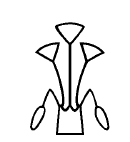

OccID = 2512
Monument : Nakht TT.52
Monument type : Private Tomb
Localisation or provenance : Sheikh Abd el-Gurna
Period : Dynasty XVIII
Reign(s) : Thutmose IV
Approximate date : 1400 - 1390
ExemplarID = 214 - statistical relevance rating : *****
Colours used : base pink with red markings, stems green, buds yellow, flowers green with yellow and red tips


OccID = 2513
Monument : Nakht TT.52
Monument type : Private Tomb
Localisation or provenance : Sheikh Abd el-Gurna
Period : Dynasty XVIII
Reign(s) : Thutmose IV
Approximate date : 1400 - 1390
ExemplarID = 215 - statistical relevance rating : *****
Colours used : stem blue, leaf green


OccID = 1234
Monument : Horemheb KV.57
Monument type : Royal Tomb
Localisation or provenance : Valley of the Kings
Period : Dynasty XVIII
Reign(s) : Horemheb
Approximate date : 1323 - 1295
ExemplarID = 216 - statistical relevance rating : ****
Colours used : reed stem blue, leaf green, leg red with white fill between leg and stem


OccID = 3122
Monument : Temple of Ramses II (Abydos)
Monument type : Temple
Localisation or provenance : Abydos
Period : Dynasty XIX
Reign(s) : Ramses II
Approximate date : 1279 - 1213
ExemplarID = 217 - statistical relevance rating : ****
Colours used : reed green, legs red
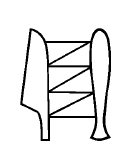

OccID = 1329
Monument : Sarenput II
Monument type : Private Tomb
Localisation or provenance : Elephantine
Period : Dynasty XII
Reign(s) : Amenemhat II
Approximate date : 1911 - 1877
ExemplarID = 279 - statistical relevance rating : **
Colours used : green


OccID = 3390
Monument : Deir el-Bahri
Monument type : Funerary temple
Localisation or provenance : Deir el-Bahri
Period : Dynasty XVIII
Reign(s) : Hatshepsut
Approximate date : 1473 - 1458
ExemplarID = 333 - statistical relevance rating : **
Colours used : reeds green, zigzag red, fill white


OccID = 2507
Monument : Nakht TT.52
Monument type : Private Tomb
Localisation or provenance : Sheikh Abd el-Gurna
Period : Dynasty XVIII
Reign(s) : Thutmose IV
Approximate date : 1400 - 1390
ExemplarID = 218 - statistical relevance rating : ****
Colours used : stems and shoots blue, leaves green, earth red


OccID = 3463
Monument : Amenhotep III KV.22
Monument type : Royal Tomb
Localisation or provenance : Valley of the Kings
Period : Dynasty XVIII
Reign(s) : Amenhotep III
Approximate date : 1390 - 1352
ExemplarID = 334 - statistical relevance rating : **
Colours used : green


OccID = 1837
Monument : Peftjauneith
Monument type : Coffin
Localisation or provenance : Sais
Period : Dynasty XXVI
Reign(s) : ?
Approximate date : 664 - 525
ExemplarID = 219 - statistical relevance rating : ***
Colours used : green (almost black)


OccID = 1475
Monument : Khonsou-Tefnakht E.586
Monument type : Coffin
Localisation or provenance : El Hibeh
Period : Dynasty XXVII
Reign(s) : ?
Approximate date : 525 - 404
ExemplarID = 220 - statistical relevance rating : *****
Colours used : green


OccID = 2355
Monument : Rekhmire TT.100
Monument type : Private Tomb
Localisation or provenance : Sheikh Abd el-Gurna
Period : Dynasty XVIII
Reign(s) : Thutmose III - Amenhotep II
Approximate date : 1479 - 1400
ExemplarID = 221 - statistical relevance rating : **
Colours used : plant green, mouth red


OccID = 2430
Monument : Rekhmire TT.100
Monument type : Private Tomb
Localisation or provenance : Sheikh Abd el-Gurna
Period : Dynasty XVIII
Reign(s) : Thutmose III - Amenhotep II
Approximate date : 1479 - 1400
ExemplarID = 335 - statistical relevance rating : ***
Colours used : plant green, flowers and mouth red
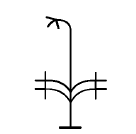

OccID = 2290
Monument : Rekhmire TT.100
Monument type : Private Tomb
Localisation or provenance : Sheikh Abd el-Gurna
Period : Dynasty XVIII
Reign(s) : Thutmose III - Amenhotep II
Approximate date : 1479 - 1400
ExemplarID = 222 - statistical relevance rating : ***
Colours used : ground blue, base red, stem green, flowers red


OccID = 2544
Monument : Nakht TT.52
Monument type : Private Tomb
Localisation or provenance : Sheikh Abd el-Gurna
Period : Dynasty XVIII
Reign(s) : Thutmose IV
Approximate date : 1400 - 1390
ExemplarID = 223 - statistical relevance rating : ***
Colours used : sedge blue, flowers red, arm red


OccID = 193
Monument : Wepemnefret G1201
Monument type : Slab stela
Localisation or provenance : Giza
Period : Dynasty IV
Reign(s) : Khufu
Approximate date : 2589 - 2566
ExemplarID = 595 - statistical relevance rating : *
Colours used : green stem, flowers red and black, "10" red


OccID = 3209
Monument : Penmaât
Monument type : Mummy board
Localisation or provenance : Sheikh Abd el-Gurna
Period : Dynasty XXII
Reign(s) : Osorkon I - ?
Approximate date : 945 - 715
ExemplarID = 224 - statistical relevance rating : *****
Colours used : green


OccID = 461
Monument : Benia TT.343
Monument type : Private Tomb
Localisation or provenance : Sheikh Abd el-Gurna
Period : Dynasty XVIII
Reign(s) : Hatshepsut - Amenhotep II
Approximate date : 1473 - 1400
ExemplarID = 604 - statistical relevance rating : ****
Colours used : green, tip red and yellow


OccID = 1922
Monument : Peftjauneith
Monument type : Coffin
Localisation or provenance : Sais
Period : Dynasty XXVI
Reign(s) : ?
Approximate date : 664 - 525
ExemplarID = 226 - statistical relevance rating : **
Colours used : yellow


OccID = 1571
Monument : Khonsou-Tefnakht E.586
Monument type : Coffin
Localisation or provenance : El Hibeh
Period : Dynasty XXVII
Reign(s) : ?
Approximate date : 525 - 404
ExemplarID = 227 - statistical relevance rating : **
Colours used : blue/black


OccID = 3441
Monument : Iunu G4150
Monument type : Slab stela
Localisation or provenance : Giza
Period : Dynasty IV
Reign(s) : Khufu
Approximate date : 2589 - 2566
ExemplarID = 336 - statistical relevance rating : **
Colours used : yellow


OccID = 1445
Monument : Sobekhotep TT.63
Monument type : Private Tomb
Localisation or provenance : Sheikh Abd el-Gurna
Period : Dynasty XVIII
Reign(s) : Thutmose IV
Approximate date : 1400 - 1390
ExemplarID = 228 - statistical relevance rating : *
Colours used : yellow with red dots


OccID = 2357
Monument : Rekhmire TT.100
Monument type : Private Tomb
Localisation or provenance : Sheikh Abd el-Gurna
Period : Dynasty XVIII
Reign(s) : Thutmose III - Amenhotep II
Approximate date : 1479 - 1400
ExemplarID = 337 - statistical relevance rating : ***
Colours used : stems blue/green, bolls yellow, string tie yellow


OccID = 3443
Monument : Iunu G4150
Monument type : Slab stela
Localisation or provenance : Giza
Period : Dynasty IV
Reign(s) : Khufu
Approximate date : 2589 - 2566
ExemplarID = 340 - statistical relevance rating : **
Colours used : basket yellow, lines red, fruit faded

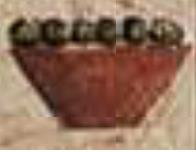
OccID = 195
Monument : Wepemnefret G1201
Monument type : Slab stela
Localisation or provenance : Giza
Period : Dynasty IV
Reign(s) : Khufu
Approximate date : 2589 - 2566
ExemplarID = 339 - statistical relevance rating : **
Colours used : basket red, grains black


OccID = 1878
Monument : Peftjauneith
Monument type : Coffin
Localisation or provenance : Sais
Period : Dynasty XXVI
Reign(s) : ?
Approximate date : 664 - 525
ExemplarID = 230 - statistical relevance rating : ***
Colours used : reeds green, lashing yellow


OccID = 2549
Monument : Nakht TT.52
Monument type : Private Tomb
Localisation or provenance : Sheikh Abd el-Gurna
Period : Dynasty XVIII
Reign(s) : Thutmose IV
Approximate date : 1400 - 1390
ExemplarID = 231 - statistical relevance rating : **
Colours used : red


OccID = 1830
Monument : Peftjauneith
Monument type : Coffin
Localisation or provenance : Sais
Period : Dynasty XXVI
Reign(s) : ?
Approximate date : 664 - 525
ExemplarID = 232 - statistical relevance rating : *
Colours used : town wall blue, crossroads yellow, papyrus stems green, flowers red
Group N is particularly well represented in the database. Thirty-nine out of forty-three signs (91%) have at least one occurrence and thirty-four possess coloured images. The group contains several very common signs.
The signs in group N demonstrate both the desire of the scribe-painter to imitate the natural world and the limitations of the canonical palette to achieve this goal. Sky, sun, moon, stars, earth, sunlight and water are all difficult to reproduce accurately using only basic focal colours (see Berlin and Kay, 1969). Conventional colours are therefore preferred.
The sky N1 is unsurprisingly coloured blue, but with shades ranging from blue-green, through pale blue to dark blue and even blue-black : used when depicting the night sky. One detailed attempt at portraying the night sky, from the tomb of Horemheb (KV.57 - Mon.25), has within the blue sky hieroglyph six stars probably painted white, but which have blended with the underlying dark blue to appear very pale blue (see exemplar). However, this occurrence is unique amongst the sky hieroglyphs in the database.
The sun N5 is almost always red, but can also have a white or gold ring around the outside. This gives the impression of the brilliance of the sun : a kind of halo. It should be noted that none of the database occurrences is drawn as in the typographic version, with a small dot in the centre. The outer ring is always narrow. In one occurrence (TT.69 - Mon.40), the centre is pale yellow or white with pale, elongated spots (which look like grains) and the outer ring has dark blue dots. This appears to be a confusion with the threshing floor O50, even though the context is clear (nHH).
The moon is represented by the signs N9-N13*. N9 shows a disk divided in the centre with the top half dark blue-black and the lower half red. It may represent a partial lunar eclipse as this could explain the red colour which can be seen during these events. N10 is not so clear. Gardiner (EG 486) describes it as an alternative form of N9, but the colours used (blue and yellow) and the shape of the obscured portion do not correspond. It is probably simply the moon (yellow like the stars) with part of the disk in shade, representing a new moon. The simple crescent moon N11 is yellow or transparent like the stars, but the occurrence of N12, an alternative form, is red. This can be explained as being a confusion with the rib F42, as mentioned in Gardiner (EG 486).
The star signs N13*-N15 are mostly transparent with a red outline, or yellow. The circle enclosing the star in the one occurrence of N15 is black and represents the obscurity of the netherworld : the dwAt.
Sunlight presents a particularly interesting case. As can be seen in the stele of Taparet (Musée du Louvre E 52), the Egyptians had an advanced understanding of the colours that constitute visible sunlight. Although rainbows are rare occurrences in Egypt, the Egyptians must have observed the scattering effect of light as it passes through a natural prism such as rock crystal. This same scattering can be seen in the sign for the sunrise N28. This sign shows several separate rings of colour which vary from occurrence to occurrence. Clearly, the innermost ring which varies in the same way as all the other rings does not represent a hill, as in Gardiner’s description, but is rather one of the constituent colours of sunlight. A better example of the sun rising over a hill is seen in the sign N27, where the hill is coloured red or stippled yellow to indicate sandy desert. In this sign and in the other hill signs N25 and N26, there is often a blue line underneath the hill to indicate the “black” fertile alluvium in contrast to the “red” desert. This blue alluvium is also seen in the signs for land N16, N17, N20 and N21. Blue is one of the substitutes for black and gives a fair approximation to the grey colour of sun-dried alluvium. This can also be seen in signs such as the house seen in plan O1, where the walls are made of mud-brick and coloured blue.
The hill slope N29 is described by Gardiner as “sandy” (EG 489). However, sand would be represented by pink, red or yellow with dark spots, as for instance in N27. The occurrences found here are mostly blue, with white, yellow and red as alternatives. In one inscription (Mon.31), two colours, blue and red, have been used in the same context. Blue often represents the alluvium left by the receding Nile flood. Yellow and red are desert colours. White can represent limestone. It would appear then, that we have a prototypical hillside. This is unusual in the canon, where hieroglyphs are normally categorised by the use of the same or similar colours. The different shades used here remain, at this time, somewhat obscure.
The water signs included in the corpus (including canals, pools and wells) are N35, N35*, N36, N37, N3, N41 and N41*. N35 and N35*, as pure representations of rippled, fast-flowing water, are nearly always black or very dark blue. This would suggest silt-laden Nile flood water, the bringer of fertility to the “black land”. In contrast, the water in the canal N36 is most often green, giving the impression of slow-flowing irrigation channels. The garden pool N37 also has green water or in some cases light blue which both represent the still water of a pond. The other garden pool N39 is mostly blue, with a blue or black outline and dark (blue?) ripples. It should be noted that this sign can also be used as a determinative for irrigated land (EG 491), which may explain the use here of blue and black.
The last two water signs are intriguing. The well full of water N41 is used primarily as a metaphor for the female genitalia (EG 492) probably both as a source of life and for physiological reasons. Goldwasser calls this a “pictorial euphemism” (2002, 85). The colours used are mostly blue and green, as for the pool N37. The slightly different N41*, which has three protuberances at the top, may in fact not be a well at all but rather a crucible used for smelting copper. The exemplar from Mon.31 is the clearest occurrence. It appears to be a bowl with a red outline, which shows the contents as a series of horizontal, slightly wavy, red lines. At the top are three evenly-spaced appendages in green. This hardly resembles the well seen in N41. A clay crucible containing molten copper is probably a better interpretation. The green appendages could be some kind of fibrous handles, but this seems unlikely as they would have to be fire-resistant. The most likely explanation would be of pieces of copper ore, shown on the surface in an example of the contents drawn above the vessel (Schäfer 1974, 144). The Mon.31 context is nHm, where N41* represents the phoneme Hm, as for N41. The use of N41* in place of N41 appears at first to be purely as a sign variant, without any metaphorical significance. However, there is a connection between the sign N41* and the goddess Hathor, not only a divinity representing the female principle, but also the patron of miners. Hathor can have the epithet nbt-nHm “mistress of those that take away” (Wb II, 297, 6), which is written using N41* instead of N41 (LGG IV, 81). Many shrines to the goddess have been located at copper mines, such as those at Serabit el-Khadim (Valbelle and Bonnet 1996). It seems therefore likely that N41* represents a copper smelting crucible, with a rich metaphorical connection, enhanced by the sign’s polychromy.


OccID = 3213
Monument : Penmaât
Monument type : Mummy board
Localisation or provenance : Sheikh Abd el-Gurna
Period : Dynasty XXII
Reign(s) : Osorkon I - ?
Approximate date : 945 - 715
ExemplarID = 234 - statistical relevance rating : *****
Colours used : blue


OccID = 1203
Monument : Horemheb KV.57
Monument type : Royal Tomb
Localisation or provenance : Valley of the Kings
Period : Dynasty XVIII
Reign(s) : Horemheb
Approximate date : 1323 - 1295
ExemplarID = 233 - statistical relevance rating : *****
Colours used : blue with white stars


OccID = 3668
Monument : Ramses V-VI KV.9
Monument type : Royal Tomb
Localisation or provenance : Valley of the Kings
Period : Dynasty XX
Reign(s) : Ramses V - VI
Approximate date : 1147 - 1136
ExemplarID = 341 - statistical relevance rating : *
Colours used : dark blue
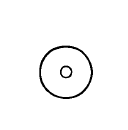

OccID = 1204
Monument : Horemheb KV.57
Monument type : Royal Tomb
Localisation or provenance : Valley of the Kings
Period : Dynasty XVIII
Reign(s) : Horemheb
Approximate date : 1323 - 1295
ExemplarID = 235 - statistical relevance rating : *****
Colours used : inner red, outer ring white


OccID = 2805
Monument : Menkheper TT.79
Monument type : Private Tomb
Localisation or provenance : Sheikh Abd el-Gurna
Period : Dynasty XVIII
Reign(s) : Thutmose III - Amenhotep II
Approximate date : 1479 - 1400
ExemplarID = 237 - statistical relevance rating : ***
Colours used : sun red with ring white, block white with base blue and triangle red


OccID = 3034
Monument : Userhat TT.56 yellow background
Monument type : Private Tomb
Localisation or provenance : Sheikh Abd el-Gurna
Period : Dynasty XVIII
Reign(s) : Amenhotep II
Approximate date : 1427 - 1400
ExemplarID = 238 - statistical relevance rating : ***
Colours used : sun red, outer ring and sun rays white


OccID = 1863
Monument : Peftjauneith
Monument type : Coffin
Localisation or provenance : Sais
Period : Dynasty XXVI
Reign(s) : ?
Approximate date : 664 - 525
ExemplarID = 239 - statistical relevance rating : *
Colours used : lower red, upper blue


OccID = 2040
Monument : Ramses I KV.16
Monument type : Royal Tomb
Localisation or provenance : Valley of the Kings
Period : Dynasty XIX
Reign(s) : Ramses I
Approximate date : 1295 - 1294
ExemplarID = 240 - statistical relevance rating : **
Colours used : upper blue, lower yellow


OccID = 161
Monument : Wepemnefret G1201
Monument type : Slab stela
Localisation or provenance : Giza
Period : Dynasty IV
Reign(s) : Khufu
Approximate date : 2589 - 2566
ExemplarID = 344 - statistical relevance rating : *
Colours used : outline red, fill white


OccID = 2358
Monument : Rekhmire TT.100
Monument type : Private Tomb
Localisation or provenance : Sheikh Abd el-Gurna
Period : Dynasty XVIII
Reign(s) : Thutmose III - Amenhotep II
Approximate date : 1479 - 1400
ExemplarID = 242 - statistical relevance rating : *
Colours used : red
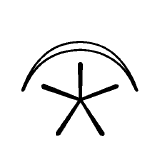

OccID = 2360
Monument : Rekhmire TT.100
Monument type : Private Tomb
Localisation or provenance : Sheikh Abd el-Gurna
Period : Dynasty XVIII
Reign(s) : Thutmose III - Amenhotep II
Approximate date : 1479 - 1400
ExemplarID = 243 - statistical relevance rating : *
Colours used : yellow


OccID = 2046
Monument : Ramses I KV.16
Monument type : Royal Tomb
Localisation or provenance : Valley of the Kings
Period : Dynasty XIX
Reign(s) : Ramses I
Approximate date : 1295 - 1294
ExemplarID = 244 - statistical relevance rating : ****
Colours used : yellow, outline and centre ring red


OccID = 1267
Monument : Horemheb KV.57
Monument type : Royal Tomb
Localisation or provenance : Valley of the Kings
Period : Dynasty XVIII
Reign(s) : Horemheb
Approximate date : 1323 - 1295
ExemplarID = 345 - statistical relevance rating : ****
Colours used : white with red outline


OccID = 3215
Monument : Penmaât
Monument type : Mummy board
Localisation or provenance : Sheikh Abd el-Gurna
Period : Dynasty XXII
Reign(s) : Osorkon I - ?
Approximate date : 945 - 715
ExemplarID = 245 - statistical relevance rating : *
Colours used : star white with outline red, outer circle black


OccID = 3214
Monument : Penmaât
Monument type : Mummy board
Localisation or provenance : Sheikh Abd el-Gurna
Period : Dynasty XXII
Reign(s) : Osorkon I - ?
Approximate date : 945 - 715
ExemplarID = 247 - statistical relevance rating : ****
Colours used : blue with outline black


OccID = 2069
Monument : Ramses I KV.16
Monument type : Royal Tomb
Localisation or provenance : Valley of the Kings
Period : Dynasty XIX
Reign(s) : Ramses I
Approximate date : 1295 - 1294
ExemplarID = 246 - statistical relevance rating : *****
Colours used : blue


OccID = 2114
Monument : Ramses I KV.16
Monument type : Royal Tomb
Localisation or provenance : Valley of the Kings
Period : Dynasty XIX
Reign(s) : Ramses I
Approximate date : 1295 - 1294
ExemplarID = 574 - statistical relevance rating : ***
Colours used : red, outline black


OccID = 3078
Monument : Temple of Ramses II (Abydos)
Monument type : Temple
Localisation or provenance : Abydos
Period : Dynasty XIX
Reign(s) : Ramses II
Approximate date : 1279 - 1213
ExemplarID = 250 - statistical relevance rating : *****
Colours used : blue


OccID = 2812
Monument : Nakht-Min TT.87
Monument type : Private Tomb
Localisation or provenance : Sheikh Abd el-Gurna
Period : Dynasty XVIII
Reign(s) : Thutmose III
Approximate date : 1479 - 1425
ExemplarID = 251 - statistical relevance rating : **
Colours used : blue


OccID = 2085
Monument : Ramses I KV.16
Monument type : Royal Tomb
Localisation or provenance : Valley of the Kings
Period : Dynasty XIX
Reign(s) : Ramses I
Approximate date : 1295 - 1294
ExemplarID = 252 - statistical relevance rating : ****
Colours used : hills red, base blue


OccID = 3041
Monument : Temple of Ramses II (Abydos)
Monument type : Temple
Localisation or provenance : Abydos
Period : Dynasty XIX
Reign(s) : Ramses II
Approximate date : 1279 - 1213
ExemplarID = 253 - statistical relevance rating : ****
Colours used : hills red, earth blue


OccID = 2961
Monument : Userhat TT.56
Monument type : Private Tomb
Localisation or provenance : Sheikh Abd el-Gurna
Period : Dynasty XVIII
Reign(s) : Amenhotep II
Approximate date : 1427 - 1400
ExemplarID = 255 - statistical relevance rating : ****
Colours used : ground blue, mountain pink with red dots, sun red with outer ring white
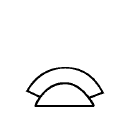

OccID = 2075
Monument : Ramses I KV.16
Monument type : Royal Tomb
Localisation or provenance : Valley of the Kings
Period : Dynasty XIX
Reign(s) : Ramses I
Approximate date : 1295 - 1294
ExemplarID = 256 - statistical relevance rating : ****
Colours used : bands of (from centre) red, blue, green, blue, white, red


OccID = 1855
Monument : Peftjauneith
Monument type : Coffin
Localisation or provenance : Sais
Period : Dynasty XXVI
Reign(s) : ?
Approximate date : 664 - 525
ExemplarID = 257 - statistical relevance rating : ****
Colours used : rings (from inside) blue, black, blue, red, blue, black


OccID = 1552
Monument : Khonsou-Tefnakht E.586
Monument type : Coffin
Localisation or provenance : El Hibeh
Period : Dynasty XXVII
Reign(s) : ?
Approximate date : 525 - 404
ExemplarID = 261 - statistical relevance rating : ****
Colours used : blue


OccID = 2315
Monument : Khonsou-Tefnakht E.586
Monument type : Coffin
Localisation or provenance : El Hibeh
Period : Dynasty XXVII
Reign(s) : ?
Approximate date : 525 - 404
ExemplarID = 258 - statistical relevance rating : ****
Colours used : red


OccID = 1292
Monument : Horemheb KV.57
Monument type : Royal Tomb
Localisation or provenance : Valley of the Kings
Period : Dynasty XVIII
Reign(s) : Horemheb
Approximate date : 1323 - 1295
ExemplarID = 260 - statistical relevance rating : ****
Colours used : white


OccID = 2711
Monument : Nefersekheru TT.296
Monument type : Private Tomb
Localisation or provenance : Khokha
Period : Dynasty XIX
Reign(s) : Ramses II
Approximate date : 1279 - 1213
ExemplarID = 262 - statistical relevance rating : **
Colours used : mound green, outline red, walls blue


OccID = 2303
Monument : Rekhmire TT.100
Monument type : Private Tomb
Localisation or provenance : Sheikh Abd el-Gurna
Period : Dynasty XVIII
Reign(s) : Thutmose III - Amenhotep II
Approximate date : 1479 - 1400
ExemplarID = 263 - statistical relevance rating : ****
Colours used : road red, outline blue, shrubs green


OccID = 1887
Monument : Peftjauneith
Monument type : Coffin
Localisation or provenance : Sais
Period : Dynasty XXVI
Reign(s) : ?
Approximate date : 664 - 525
ExemplarID = 264 - statistical relevance rating : **
Colours used : blue


OccID = 3219
Monument : Penmaât
Monument type : Mummy board
Localisation or provenance : Sheikh Abd el-Gurna
Period : Dynasty XXII
Reign(s) : Osorkon I - ?
Approximate date : 945 - 715
ExemplarID = 265 - statistical relevance rating : **
Colours used : outer red, inner white


OccID = 2506
Monument : Nakht TT.52
Monument type : Private Tomb
Localisation or provenance : Sheikh Abd el-Gurna
Period : Dynasty XVIII
Reign(s) : Thutmose IV
Approximate date : 1400 - 1390
ExemplarID = 266 - statistical relevance rating : *****
Colours used : black


OccID = 1845
Monument : Peftjauneith
Monument type : Coffin
Localisation or provenance : Sais
Period : Dynasty XXVI
Reign(s) : ?
Approximate date : 664 - 525
ExemplarID = 267 - statistical relevance rating : *****
Colours used : blue


OccID = 2526
Monument : Nakht TT.52
Monument type : Private Tomb
Localisation or provenance : Sheikh Abd el-Gurna
Period : Dynasty XVIII
Reign(s) : Thutmose IV
Approximate date : 1400 - 1390
ExemplarID = 268 - statistical relevance rating : ****
Colours used : channel sides blue, water green


OccID = 2668
Monument : Nefersekheru TT.296
Monument type : Private Tomb
Localisation or provenance : Khokha
Period : Dynasty XIX
Reign(s) : Ramses II
Approximate date : 1279 - 1213
ExemplarID = 269 - statistical relevance rating : ****
Colours used : pool rim blue, water green


OccID = 1852
Monument : Peftjauneith
Monument type : Coffin
Localisation or provenance : Sais
Period : Dynasty XXVI
Reign(s) : ?
Approximate date : 664 - 525
ExemplarID = 270 - statistical relevance rating : ****
Colours used : outline and waves blue, fill white


OccID = 2364
Monument : Rekhmire TT.100
Monument type : Private Tomb
Localisation or provenance : Sheikh Abd el-Gurna
Period : Dynasty XVIII
Reign(s) : Thutmose III - Amenhotep II
Approximate date : 1479 - 1400
ExemplarID = 271 - statistical relevance rating : ****
Colours used : outline blue, water green


OccID = 1523
Monument : Khonsou-Tefnakht E.586
Monument type : Coffin
Localisation or provenance : El Hibeh
Period : Dynasty XXVII
Reign(s) : ?
Approximate date : 525 - 404
ExemplarID = 272 - statistical relevance rating : **
Colours used : recipient red outline and red inner horizontal lines, three green appendages on top


OccID = 2948
Monument : Userhat TT.56
Monument type : Private Tomb
Localisation or provenance : Sheikh Abd el-Gurna
Period : Dynasty XVIII
Reign(s) : Amenhotep II
Approximate date : 1427 - 1400
ExemplarID = 273 - statistical relevance rating : **
Colours used : green
For Group O, forty-one out of fifty-one signs (80%) have at least one occurrence and thirty-seven possess coloured images. Architectural images have, since the very beginning of hieroglyphic writing, been an important, well represented category (cf. the niched enclosures on the Narmer palette : Tiradritti 1999, 40-41). A monograph by Badawy (1948) gives an insight into the representation and evolution of many of the architectural signs.
One of the staples of Egyptian architecture was, and still is, mud-brick. One sign, O39, not only represents a block of stone when coloured white as in the first exemplar, but could also show a single mud-brick when coloured blue as in the second. The Nile alluvium, deposited by the annual flood, when mixed with sand and binding agents such as straw and chaff, is an ideal material for the production of sun-dried bricks (for a full discussion of the composition of Egyptian mud-brick and the method of manufacture, see Kemp 2000, 78-84). The grey-brown mud dries to a colour that the Egyptians found closest to blue-black, as neither grey nor brown were available to the scribe-painters.
Many Group O database occurrences use blue-black to represent mud-brick buildings or walled enclosures, as seen from above in plan. These signs are O1, O1*, O2, O2*, O3, O4, O6, O7, O7*, O8, O10, O36, O38, O39, O47, O48 and O49.
O1 - O3 show the same basic form, which could be a schematic view of a house seen in plan or, as Badawy suggests (1948, 41), simply a room or even an open-air courtyard. O4 is described by Gardiner as a “reed shelter” (EG 493) but the colour blue also shows the wall to be made of mud- brick rather than reeds, which would be green or yellow. The sign, therefore, probably represents a room in a house or a courtyard. O38 shows the corner of a wall and as such is also blue or black, indicating mud-brick.
O6 - O10 and O36 represent walled enclosures, also made of mud-brick, with a gateway or door in one of the lower corners. Most of these doors are coloured red to indicate wood. Most occurrences also have a white fill, indicating empty space and showing these representations to be of an enclosure. The signs are all of temple enclosures, as is seen from the word Hwt “temple” which composes part of each term (FCD 165-166).
Interestingly, O7, O7* (and O8 according to EG 493) have a “loaf” sign X1 in the top centre of the enclosure, which is painted blue or black like the walls. As temples were supposed to be built upon the primaeval mound of creation which surged up from the waters of Nun (Kemp 2000, 92), this sign could indeed represent the mound. The colour blue or black enhances this explanation as it represents the mud that appears as the Nile flood subsides, giving the “black land” of Egypt. This would also explain why this “loaf” X1 is always painted black or blue, even when written in words for bread, where these colours seem out of place (see the commentary on X1).
O36 represents a niched walled enclosure and is also made of blue-black mud-brick. The sign even reads inb “wall” (FCD 23). O47 and O48 are also signs for walled enclosures but at a specific site : Nekhen. The signification of the two red diagonals inside the wall is unclear. Perhaps they represent wooden totems of the town.
O49, the sign for a town or village, has variable polychromy. Most occurrences have a blue or black outer ring which is probably a mud-brick wall. Inside this wall can be found a green cross, often described as a crossroads (EG 498), but which is more likely to be an area under cultivation. The white triangles seen on some occurrences would then represent open space.
Several signs appear to show wooden objects or parts of buildings. These are O16, O18, O19, O21, O22, O23, O29, O30, O31, O34, O35, O42 and O44.
The gateway O16, the shrines O18 and O19 and the tent O22 are yellow. This can represent wood, maybe gilded, or reed matting in the case of the primitive shrine O19 (Badawy 1948, 46). Red is used in O21 to represent the wooden door. A red wooden pole supports the roof of the booth O22. O23 has a wooden structure. The other signs are all red and are clearly made of wood, with the possible exception of the door bolt O34 (and O35) which could be copper. Badawy (1948, 54-55) thinks that the loops at the top of the picket fence O42 are made of leather, but no difference can be discerned in the drawing between the pickets and the loops.
The column O28 presents some difficulties. Separate bands of blue and red, in different arrangements, form the column. One occurrence (Mon.33) is highly decorated with a large central white spot. The top of the columns can be flat or angled. The “tenon” at the top can be straight or looped. The same sort of column can be seen in the sign for a hall O27, but again the bands of blue and red are arranged unlike any of the occurrences of O28. Any attempt at explaining the colours or justifying these divergences would be speculative.

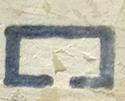
OccID = 2528
Monument : Nakht TT.52
Monument type : Private Tomb
Localisation or provenance : Sheikh Abd el-Gurna
Period : Dynasty XVIII
Reign(s) : Thutmose IV
Approximate date : 1400 - 1390
ExemplarID = 274 - statistical relevance rating : *****
Colours used : blue, fill white


OccID = 2421
Monument : Rekhmire TT.100
Monument type : Private Tomb
Localisation or provenance : Sheikh Abd el-Gurna
Period : Dynasty XVIII
Reign(s) : Thutmose III - Amenhotep II
Approximate date : 1479 - 1400
ExemplarID = 346 - statistical relevance rating : *
Colours used : blue, fill white


OccID = 2859
Monument : Paroy TT.295
Monument type : Private Tomb
Localisation or provenance : Khokha
Period : Dynasty XVIII
Reign(s) : Thutmose IV - Amenhotep III
Approximate date : 1400 - 1352
ExemplarID = 347 - statistical relevance rating : *
Colours used : house blue, heart and windpipe white with red markings


OccID = 3230
Monument : Penmaât
Monument type : Mummy board
Localisation or provenance : Sheikh Abd el-Gurna
Period : Dynasty XXII
Reign(s) : Osorkon I - ?
Approximate date : 945 - 715
ExemplarID = 348 - statistical relevance rating : **
Colours used : house and pot blue, mace and jug red


OccID = 2113
Monument : Ramses I KV.16
Monument type : Royal Tomb
Localisation or provenance : Valley of the Kings
Period : Dynasty XIX
Reign(s) : Ramses I
Approximate date : 1295 - 1294
ExemplarID = 349 - statistical relevance rating : *****
Colours used : blue, fill white


OccID = 3845
Monument : Ta-ouseret-em-per-nesou (aka Unnefer).
Monument type : Coffin
Localisation or provenance : Bab el-Gasus
Period : Dynasty XXI
Reign(s) : ?
Approximate date : 1069 - 945
ExemplarID = 597 - statistical relevance rating : ****
Colours used : wall blue, inner green, door red


OccID = 1917
Monument : Peftjauneith
Monument type : Coffin
Localisation or provenance : Sais
Period : Dynasty XXVI
Reign(s) : ?
Approximate date : 664 - 525
ExemplarID = 350 - statistical relevance rating : **
Colours used : outlines and X1 black, door red, white fill


OccID = 3934
Monument : Peftjauneith
Monument type : Coffin
Localisation or provenance : Sais
Period : Dynasty XXVI
Reign(s) : ?
Approximate date : 664 - 525
ExemplarID = 596 - statistical relevance rating : ***
Colours used : outlines and 't' black, doors red, white fill


OccID = 2084
Monument : Ramses I KV.16
Monument type : Royal Tomb
Localisation or provenance : Valley of the Kings
Period : Dynasty XIX
Reign(s) : Ramses I
Approximate date : 1295 - 1294
ExemplarID = 351 - statistical relevance rating : **
Colours used : enclosure blue, doors red, fill white, column red


OccID = 3491
Monument : Amenhotep III KV.22
Monument type : Royal Tomb
Localisation or provenance : Valley of the Kings
Period : Dynasty XVIII
Reign(s) : Amenhotep III
Approximate date : 1390 - 1352
ExemplarID = 352 - statistical relevance rating : ****
Colours used : enclosure dark blue, door red, fill white, falcon blue(?) with tail, feet and top of head red


OccID = 1453
Monument : Sobekhotep TT.63
Monument type : Private Tomb
Localisation or provenance : Sheikh Abd el-Gurna
Period : Dynasty XVIII
Reign(s) : Thutmose IV
Approximate date : 1400 - 1390
ExemplarID = 354 - statistical relevance rating : **
Colours used : base black, wall yellow and white with red band, battlements red

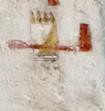
OccID = 2425
Monument : Rekhmire TT.100
Monument type : Private Tomb
Localisation or provenance : Sheikh Abd el-Gurna
Period : Dynasty XVIII
Reign(s) : Thutmose III - Amenhotep II
Approximate date : 1479 - 1400
ExemplarID = 355 - statistical relevance rating : *
Colours used : arm red, wall white, diagonal yellow, stripe blue, battlements yellow


OccID = 2308
Monument : Rekhmire TT.100
Monument type : Private Tomb
Localisation or provenance : Sheikh Abd el-Gurna
Period : Dynasty XVIII
Reign(s) : Thutmose III - Amenhotep II
Approximate date : 1479 - 1400
ExemplarID = 356 - statistical relevance rating : **
Colours used : gateway yellow with red markings, cobras red


OccID = 3102
Monument : Temple of Ramses II (Abydos)
Monument type : Temple
Localisation or provenance : Abydos
Period : Dynasty XIX
Reign(s) : Ramses II
Approximate date : 1279 - 1213
ExemplarID = 357 - statistical relevance rating : *
Colours used : yellow


OccID = 3805
Monument : Temple of Sety I - Abydos
Monument type : Temple
Localisation or provenance : Abydos
Period : Dynasty XIX
Reign(s) : Sety I
Approximate date : 1294 - 1279
ExemplarID = 358 - statistical relevance rating : **
Colours used : yellow


OccID = 1289
Monument : Horemheb KV.57
Monument type : Royal Tomb
Localisation or provenance : Valley of the Kings
Period : Dynasty XVIII
Reign(s) : Horemheb
Approximate date : 1323 - 1295
ExemplarID = 359 - statistical relevance rating : ****
Colours used : shrine white with red door


OccID = 684
Monument : Ankhmerire
Monument type : Mastaba
Localisation or provenance : Saqqara
Period : Dynasty VI
Reign(s) : Pepy I
Approximate date : 2321 - 2287
ExemplarID = 594 - statistical relevance rating : ****
Colours used : booth yellow, pole red


OccID = 3414
Monument : Deir el-Bahri
Monument type : Funerary temple
Localisation or provenance : Deir el-Bahri
Period : Dynasty XVIII
Reign(s) : Hatshepsut
Approximate date : 1473 - 1458
ExemplarID = 361 - statistical relevance rating : ***
Colours used : base blue, structure red, fill white


OccID = 685
Monument : Ankhmerire
Monument type : Mastaba
Localisation or provenance : Saqqara
Period : Dynasty VI
Reign(s) : Pepy I
Approximate date : 2321 - 2287
ExemplarID = 362 - statistical relevance rating : **
Colours used : white with red outline, point yellow


OccID = 2366
Monument : Rekhmire TT.100
Monument type : Private Tomb
Localisation or provenance : Sheikh Abd el-Gurna
Period : Dynasty XVIII
Reign(s) : Thutmose III - Amenhotep II
Approximate date : 1479 - 1400
ExemplarID = 598 - statistical relevance rating : *
Colours used : wall blue, columns base blue, top red


OccID = 3235
Monument : Penmaât
Monument type : Mummy board
Localisation or provenance : Sheikh Abd el-Gurna
Period : Dynasty XXII
Reign(s) : Osorkon I - ?
Approximate date : 945 - 715
ExemplarID = 363 - statistical relevance rating : ****
Colours used : column blue with red band, tenon red


OccID = 2450
Monument : Menna TT.69
Monument type : Private Tomb
Localisation or provenance : Sheikh Abd el-Gurna
Period : Dynasty XVIII
Reign(s) : Thutmose IV
Approximate date : 1400 - 1390
ExemplarID = 364 - statistical relevance rating : *****
Colours used : red


OccID = 1910
Monument : Peftjauneith
Monument type : Coffin
Localisation or provenance : Sais
Period : Dynasty XXVI
Reign(s) : ?
Approximate date : 664 - 525
ExemplarID = 365 - statistical relevance rating : *
Colours used : red


OccID = 2367
Monument : Rekhmire TT.100
Monument type : Private Tomb
Localisation or provenance : Sheikh Abd el-Gurna
Period : Dynasty XVIII
Reign(s) : Thutmose III - Amenhotep II
Approximate date : 1479 - 1400
ExemplarID = 366 - statistical relevance rating : *****
Colours used : pink with red stripes


OccID = 3533
Monument : Ramses IV KV.2
Monument type : Royal Tomb
Localisation or provenance : Valley of the Kings
Period : Dynasty XX
Reign(s) : Ramses IV
Approximate date : 1153 - 1147
ExemplarID = 367 - statistical relevance rating : *****
Colours used : red


OccID = 2294
Monument : Rekhmire TT.100
Monument type : Private Tomb
Localisation or provenance : Sheikh Abd el-Gurna
Period : Dynasty XVIII
Reign(s) : Thutmose III - Amenhotep II
Approximate date : 1479 - 1400
ExemplarID = 368 - statistical relevance rating : ***
Colours used : red


OccID = 3239
Monument : Penmaât
Monument type : Mummy board
Localisation or provenance : Sheikh Abd el-Gurna
Period : Dynasty XXII
Reign(s) : Osorkon I - ?
Approximate date : 945 - 715
ExemplarID = 369 - statistical relevance rating : **
Colours used : inner green, wall blue


OccID = 3236
Monument : Penmaât
Monument type : Mummy board
Localisation or provenance : Sheikh Abd el-Gurna
Period : Dynasty XXII
Reign(s) : Osorkon I - ?
Approximate date : 945 - 715
ExemplarID = 376 - statistical relevance rating : ***
Colours used : blue


OccID = 1291
Monument : Horemheb KV.57
Monument type : Royal Tomb
Localisation or provenance : Valley of the Kings
Period : Dynasty XVIII
Reign(s) : Horemheb
Approximate date : 1323 - 1295
ExemplarID = 370 - statistical relevance rating : ***
Colours used : white


OccID = 1909
Monument : Peftjauneith
Monument type : Coffin
Localisation or provenance : Sais
Period : Dynasty XXVI
Reign(s) : ?
Approximate date : 664 - 525
ExemplarID = 371 - statistical relevance rating : **
Colours used : blue
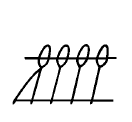

OccID = 1713
Monument : Tjanuni TT.74
Monument type : Private Tomb
Localisation or provenance : Sheikh Abd el-Gurna
Period : Dynasty XVIII
Reign(s) : Thutmose IV
Approximate date : 1400 - 1390
ExemplarID = 372 - statistical relevance rating : *****
Colours used : red, white fill in loops


OccID = 2304
Monument : Rekhmire TT.100
Monument type : Private Tomb
Localisation or provenance : Sheikh Abd el-Gurna
Period : Dynasty XVIII
Reign(s) : Thutmose III - Amenhotep II
Approximate date : 1479 - 1400
ExemplarID = 373 - statistical relevance rating : *
Colours used : loop yellow, rest red


OccID = 2117
Monument : Ramses I KV.16
Monument type : Royal Tomb
Localisation or provenance : Valley of the Kings
Period : Dynasty XIX
Reign(s) : Ramses I
Approximate date : 1295 - 1294
ExemplarID = 374 - statistical relevance rating : **
Colours used : enclosure and inner strokes blue, fill green
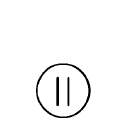

OccID = 3468
Monument : Amenhotep III KV.22
Monument type : Royal Tomb
Localisation or provenance : Valley of the Kings
Period : Dynasty XVIII
Reign(s) : Amenhotep III
Approximate date : 1390 - 1352
ExemplarID = 375 - statistical relevance rating : *
Colours used : outer ring blue, strokes red, fill white


OccID = 1226
Monument : Horemheb KV.57
Monument type : Royal Tomb
Localisation or provenance : Valley of the Kings
Period : Dynasty XVIII
Reign(s) : Horemheb
Approximate date : 1323 - 1295
ExemplarID = 377 - statistical relevance rating : ****
Colours used : outer ring blue, triangles green with white fill
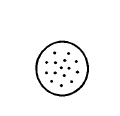

OccID = 2086
Monument : Ramses I KV.16
Monument type : Royal Tomb
Localisation or provenance : Valley of the Kings
Period : Dynasty XIX
Reign(s) : Ramses I
Approximate date : 1295 - 1294
ExemplarID = 378 - statistical relevance rating : ****
Colours used : yellow floor, grain red dots, outer ring red


OccID = 1440
Monument : Sobekhotep TT.63
Monument type : Private Tomb
Localisation or provenance : Sheikh Abd el-Gurna
Period : Dynasty XVIII
Reign(s) : Thutmose IV
Approximate date : 1400 - 1390
ExemplarID = 379 - statistical relevance rating : **
Colours used : floor blue(?), grain yellow with red dots


OccID = 686
Monument : Ankhmerire
Monument type : Mastaba
Localisation or provenance : Saqqara
Period : Dynasty VI
Reign(s) : Pepy I
Approximate date : 2321 - 2287
ExemplarID = 387 - statistical relevance rating : **
Colours used : outside of barn and doors blue, floor red, fill white


OccID = 1604
Monument : Khonsou-Tefnakht E.586
Monument type : Coffin
Localisation or provenance : El Hibeh
Period : Dynasty XXVII
Reign(s) : ?
Approximate date : 525 - 404
ExemplarID = 381 - statistical relevance rating : *
Colours used : booth red, divine emblem yellow
Group P contains only eleven signs, plus two additional ones included here, of which eight have occurrences in the database (83%), all with images. The ships (or rather boats) are all clearly distinguishable by the shape of the hull and the deck superstructure. None of the boats with occurrences is an ocean-going vessel with full rigging.
The exemplar of P1, a simple boat, has a yellow hull, probably constructed of dried reeds or papyrus bundles. It is not made of wood as the scribe-painter has distinguished the wooden steering oar (red) from the hull (yellow). There is a green cabin on the deck, probably a temporary structure made out of freshly- cut vegetation : reeds or palm fronds. The boat floats on the water which is coloured blue.
The sacred bark P3 is a far more sophisticated vessel than P1. It is also coloured yellow so could be made from papyrus bundles, but would more likely be wood (possibly gilded). No attempt has been made to distinguish the superstructure from the hull but the water is coloured blue.
The boat or sacred bark P30 is a hybrid of the two previous signs. The hull which is yellow has a similar structure to P3, but the cabin is a red (wooden) structure with the same shape as that of P1. The boat also floats on blue water.
The bark of Sokar P128 is a quite sophisticated drawing. In fact, it is so detailed that the scribe-painter has sacrificed polychromy for precision (cf. the commentary on Q29). The entire bark has been sketched in red outline but has not been completed by any other colours, despite this inscription (Mon.52) being a fine example of the use of detailed polychromy.
Two exemplars of the sail P5 have been included in the palaeography as they show high variation. The first exemplar has the standard wooden (red) ladder-like mast (as in P6) and wooden spars. The sail is white, probably made of tough linen. The second exemplar does not have the runged ladder mast but has a single red (wooden) mast with what appear to be black ropes holding the red spars and the sail. The sail itself is shown as black woven material, presumably showing its tough nature.
The oar P8 is normally red as it is made of wood, but three occurrences have a blue blade. It is difficult to see why blue, which is normally a representation of earth, mud-brick or flint, could be used here. However, it could be a metaphor for the water into which it is dipped in the same way as some bird hieroglyphs have blue wings through association with the sky (cf. the commentary on Group G).
The mooring post P11 also presents a problem. One would expect something made of wood and therefore painted red but the single database occurrence found here is coloured blue. Unless this is some kind of hard stone object, it may also be a water metaphor as in P8.


OccID = 1587
Monument : Khonsou-Tefnakht E.586
Monument type : Coffin
Localisation or provenance : El Hibeh
Period : Dynasty XXVII
Reign(s) : ?
Approximate date : 525 - 404
ExemplarID = 382 - statistical relevance rating : ****
Colours used : hull yellow, cabin green, rudder-oar red, water blue


OccID = 3694
Monument : Ramses V-VI KV.9
Monument type : Royal Tomb
Localisation or provenance : Valley of the Kings
Period : Dynasty XX
Reign(s) : Ramses V - VI
Approximate date : 1147 - 1136
ExemplarID = 383 - statistical relevance rating : ****
Colours used : bark yellow, water blue


OccID = 3030
Monument : Userhat TT.56 yellow background
Monument type : Private Tomb
Localisation or provenance : Sheikh Abd el-Gurna
Period : Dynasty XVIII
Reign(s) : Amenhotep II
Approximate date : 1427 - 1400
ExemplarID = 384 - statistical relevance rating : ****
Colours used : mast and spars red, sail white


OccID = 1817
Monument : Peftjauneith
Monument type : Coffin
Localisation or provenance : Sais
Period : Dynasty XXVI
Reign(s) : ?
Approximate date : 664 - 525
ExemplarID = 385 - statistical relevance rating : ****
Colours used : spars red, sail black cross-hatching, ropes black


OccID = 3787
Monument : Temple of Sety I - Abydos
Monument type : Temple
Localisation or provenance : Abydos
Period : Dynasty XIX
Reign(s) : Sety I
Approximate date : 1294 - 1279
ExemplarID = 386 - statistical relevance rating : ***
Colours used : red


OccID = 1484
Monument : Khonsou-Tefnakht E.586
Monument type : Coffin
Localisation or provenance : El Hibeh
Period : Dynasty XXVII
Reign(s) : ?
Approximate date : 525 - 404
ExemplarID = 388 - statistical relevance rating : ****
Colours used : red


OccID = 1339
Monument : Sarenput II
Monument type : Private Tomb
Localisation or provenance : Elephantine
Period : Dynasty XII
Reign(s) : Amenemhat II
Approximate date : 1911 - 1877
ExemplarID = 392 - statistical relevance rating : ****
Colours used : paddle black, handle red
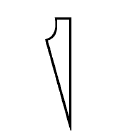

OccID = 2065
Monument : Ramses I KV.16
Monument type : Royal Tomb
Localisation or provenance : Valley of the Kings
Period : Dynasty XIX
Reign(s) : Ramses I
Approximate date : 1295 - 1294
ExemplarID = 389 - statistical relevance rating : *
Colours used : blue


OccID = 3125
Monument : Temple of Ramses II (Abydos)
Monument type : Temple
Localisation or provenance : Abydos
Period : Dynasty XIX
Reign(s) : Ramses II
Approximate date : 1279 - 1213
ExemplarID = 390 - statistical relevance rating : *
Colours used : boat yellow, cabin red, water blue


OccID = 3246
Monument : Penmaât
Monument type : Mummy board
Localisation or provenance : Sheikh Abd el-Gurna
Period : Dynasty XXII
Reign(s) : Osorkon I - ?
Approximate date : 945 - 715
ExemplarID = 391 - statistical relevance rating : *
Colours used : outline red
This small group contains only seven signs plus one additional one included here, of which six have occurrences in the database (75%), all with images.
The seat Q1 occurs especially in the writing of the names of Osiris and Isis. In all of the database occurrences, it is always painted blue. This could be not only a representation of hard stone such as greywacke but also a metaphor for the underworld : the dark abode of the dead. It is curious that this seat is not the throne usually depicted in images of the seated Osiris, where the only plain blue part is the plinth on which the throne is set (e.g. Tiradritti 2008, 286) (see also the commentary on Aa11).
The stool Q3 is hardly ever drawn as in the typographic version, as a plain undecorated rectangle. Most occurrences have three yellow horizontal bands : one central and one at either end. The underlying material is woven reed, as can be clearly seen in the Old Kingdom occurrences. The yellow bands are probably cane used to stiffen the structure. The same colour scheme and patterning can be seen in the sign R4 : an offering mat seen from the side. This probably indicates that this stool is in fact a similar mat but seen from above (see also Wb I, 489, 3; FCD 86; Bonnamy and Sadek 2010, 209).
The additional sign found here - a funerary bier Q29 is another example of the sacrifice of polychromy for detail (cf Ex.P128). The sign, in an otherwise polychrome inscription (Mon.35), is simply drawn in red outline on a white background with fine details also picked out in red.


OccID = 2527
Monument : Nakht TT.52
Monument type : Private Tomb
Localisation or provenance : Sheikh Abd el-Gurna
Period : Dynasty XVIII
Reign(s) : Thutmose IV
Approximate date : 1400 - 1390
ExemplarID = 393 - statistical relevance rating : *****
Colours used : blue


OccID = 2115
Monument : Ramses I KV.16
Monument type : Royal Tomb
Localisation or provenance : Valley of the Kings
Period : Dynasty XIX
Reign(s) : Ramses I
Approximate date : 1295 - 1294
ExemplarID = 394 - statistical relevance rating : ****
Colours used : back yellow, seat white, central band red with edges yellow


OccID = 1261
Monument : Horemheb KV.57
Monument type : Royal Tomb
Localisation or provenance : Valley of the Kings
Period : Dynasty XVIII
Reign(s) : Horemheb
Approximate date : 1323 - 1295
ExemplarID = 395 - statistical relevance rating : *****
Colours used : green with yellow and red bands


OccID = 2548
Monument : Nakht TT.52
Monument type : Private Tomb
Localisation or provenance : Sheikh Abd el-Gurna
Period : Dynasty XVIII
Reign(s) : Thutmose IV
Approximate date : 1400 - 1390
ExemplarID = 396 - statistical relevance rating : *
Colours used : red


OccID = 2766
Monument : Menkheper TT.79
Monument type : Private Tomb
Localisation or provenance : Sheikh Abd el-Gurna
Period : Dynasty XVIII
Reign(s) : Thutmose III - Amenhotep II
Approximate date : 1479 - 1400
ExemplarID = 403 - statistical relevance rating : ****
Colours used : yellow


OccID = 2938
Monument : Userhat TT.56
Monument type : Private Tomb
Localisation or provenance : Sheikh Abd el-Gurna
Period : Dynasty XVIII
Reign(s) : Amenhotep II
Approximate date : 1427 - 1400
ExemplarID = 398 - statistical relevance rating : **
Colours used : red


OccID = 2106
Monument : Ramses I KV.16
Monument type : Royal Tomb
Localisation or provenance : Valley of the Kings
Period : Dynasty XIX
Reign(s) : Ramses I
Approximate date : 1295 - 1294
ExemplarID = 399 - statistical relevance rating : *
Colours used : drawing red, fill white
This group contains not only several very common signs but also some of the most complex. Gardiner’s group contains twenty-five signs of which twenty have database occurrences (80%). Eighteen of these have accompanying images.
R1 and R3 show offering tables. R1 appears to be made of stone with a blue base and white table-top (in one occurrence with red lines to indicate alabaster). The offerings are of round loaves of bread painted white with red markings, together with beer in a blue-topped, red-based ceramic jug. R3 has a wooden structure shown as yellow or red with a top made out of wooden slats. The jug is taller than in R1 and looks like the water jug W14, but the colouring of red base and blue top is the same. The bread in the exemplar is of the X2 kind which is baked in a red, earthenware mould.
The offering mat R4 is a common sign that shows a loaf X2 on a reed mat, similar to the one depicted in Q3. However, the loaf in these occurrences is mostly blue. The signification of blue for loaves is unclear (see the commentary on Group X). The mat is viewed sideways on but the structure of fresh, green-blue reeds with cross pieces of older yellow reeds or cane can still be clearly seen (for mat weaving techniques see Wendrich 2000, 261).
The divinity emblem R8, a very common sign, is nearly always yellow, often with the lower pole blue as is the tip of the flag. It appears to represent a flagpole with blue cloth wound around the base and yellow cloth around the upper part of the pole. The yellow cloth extends outwards at the top, forming a flag. It has a blue tip. That these colours here represent cloth is shown in several of the most detailed occurrences by marks of the binding. This blue and gold flag would have had strong solar, underworld and thus divine associations.
The Dd pillar R11 is a multi-coloured sign that, in the most detailed occurrences, shows alternate bands of gold, red, blue and green as well as four gold cross pieces at the top, sometimes with a white fill. The object originally depicted may have been a tree but it quickly took on the representation of the backbone of Osiris and was a symbol of stability and duration (Bonnamy and Sadek 2010, 776; FCD 325). Exactly why there are the multi-coloured bands remains obscure, although it is possible that the colours were believed to be the constituent parts of sunlight (cf. N28). This object is a frequent motif in Egyptian art throughout the pharaonic period.
The standard R12 is a sign that is frequently combined with others to form symbols of gods and goddesses (e.g. D29, G7, G26 etc.). It represents some kind of wooden platform that could hold an image of a divinity. It is always coloured red, representing wood. Sometimes a fold of cloth hangs behind the supporting pole. At the front is a white globular object that may be an ostrich egg. For a full discussion of the symbolism of ostrich eggs, see the commentary on H8 (see also Bailleul- LeSuer 2012, 132; Phillips 2000, 332-333).
The sign R14 shows a feather sprouting from the “loaf” X1, with two pieces of red cloth like the two ends of S29. It is a simplified version of R13 which shows a Horus-falcon next to the feather. The feather representing the falcon comes forth, not from a loaf of bread, but from the primaeval mound and confirms this interpretation of the blue sign X1 (see also the commentary on X1).
The pair of fossil belemnites R22 could represent a naturalistic image of belemnitida sp. (For detailed information, see the British Geological Survey site at http://www.bgs.ac.uk/discoveringGeology/time/Fossilfocus/belemnite.html). These common creatures were cephalopods that lived during the Jurassic and Cretaceous periods. The pale central circle has, in this exemplar, details reminiscent of alabaster and could show a cross-section of the creature's rostrum with its "growth rings". As an emblem of Min, the belemnite represents either a thunderbolt or a phallus. Why two are shown in this hieroglyph is unclear.
The two bows R24 and R25 are symbols of the goddess Neith. R25 is a later, more detailed version of R24 and shows that the centre is some kind of cloth binding, forming a package. In the simpler version R24, this package is yellow, perhaps indicating linen, but in R25, it is blue with red binding. No conclusion can be reached as to its exact nature. The bows in both signs are coloured red, indicating wood.

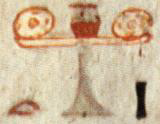
OccID = 1721
Monument : Tjanuni TT.74
Monument type : Private Tomb
Localisation or provenance : Sheikh Abd el-Gurna
Period : Dynasty XVIII
Reign(s) : Thutmose IV
Approximate date : 1400 - 1390
ExemplarID = 401 - statistical relevance rating : **
Colours used : tabletop white, leg blue, bread yellow and white, jug upper blue, base red


OccID = 485
Monument : Benia TT.343
Monument type : Private Tomb
Localisation or provenance : Sheikh Abd el-Gurna
Period : Dynasty XVIII
Reign(s) : Hatshepsut - Amenhotep II
Approximate date : 1473 - 1400
ExemplarID = 400 - statistical relevance rating : **
Colours used : table yellow with red outline, vases red lower blue upper


OccID = 3916
Monument : Rekhmire TT.100
Monument type : Private Tomb
Localisation or provenance : Sheikh Abd el-Gurna
Period : Dynasty XVIII
Reign(s) : Thutmose III - Amenhotep II
Approximate date : 1479 - 1400
ExemplarID = 402 - statistical relevance rating : *****
Colours used : mat green with yellow and red lashings, loaf pale underneath, top black


OccID = 487
Monument : Benia TT.343
Monument type : Private Tomb
Localisation or provenance : Sheikh Abd el-Gurna
Period : Dynasty XVIII
Reign(s) : Hatshepsut - Amenhotep II
Approximate date : 1473 - 1400
ExemplarID = 404 - statistical relevance rating : *
Colours used : green with yellow knot


OccID = 2976
Monument : Userhat TT.56 yellow background
Monument type : Private Tomb
Localisation or provenance : Sheikh Abd el-Gurna
Period : Dynasty XVIII
Reign(s) : Amenhotep II
Approximate date : 1427 - 1400
ExemplarID = 405 - statistical relevance rating : **
Colours used : red


OccID = 3253
Monument : Penmaât
Monument type : Mummy board
Localisation or provenance : Sheikh Abd el-Gurna
Period : Dynasty XXII
Reign(s) : Osorkon I - ?
Approximate date : 945 - 715
ExemplarID = 412 - statistical relevance rating : **
Colours used : bowl red with horizontal stripes, smoke green with blue outline


OccID = 3473
Monument : Amenhotep III KV.22
Monument type : Royal Tomb
Localisation or provenance : Valley of the Kings
Period : Dynasty XVIII
Reign(s) : Amenhotep III
Approximate date : 1390 - 1352
ExemplarID = 406 - statistical relevance rating : ****
Colours used : lower pole and tip of flag blue, upper pole and flag yellow with markings red


OccID = 110
Monument : Haremheb TT.78
Monument type : Private Tomb
Localisation or provenance : Sheikh Abd el-Gurna
Period : Dynasty XVIII
Reign(s) : Thutmose III - Amenhotep III
Approximate date : 1479 - 1352
ExemplarID = 407 - statistical relevance rating : *
Colours used : feather and block red and white, nTr yellow


OccID = 1225
Monument : Horemheb KV.57
Monument type : Royal Tomb
Localisation or provenance : Valley of the Kings
Period : Dynasty XVIII
Reign(s) : Horemheb
Approximate date : 1323 - 1295
ExemplarID = 408 - statistical relevance rating : ****
Colours used : column yellow with blue or red stripes, yellow cross pieces


OccID = 2793
Monument : Menkheper TT.79
Monument type : Private Tomb
Localisation or provenance : Sheikh Abd el-Gurna
Period : Dynasty XVIII
Reign(s) : Thutmose III - Amenhotep II
Approximate date : 1479 - 1400
ExemplarID = 409 - statistical relevance rating : ***
Colours used : standard red, protruberence white


OccID = 1316
Monument : Sarenput II
Monument type : Private Tomb
Localisation or provenance : Elephantine
Period : Dynasty XII
Reign(s) : Amenemhat II
Approximate date : 1911 - 1877
ExemplarID = 410 - statistical relevance rating : **
Colours used : head white, feathers blue, leggings white, standard blue with white feather
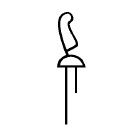

OccID = 2095
Monument : Ramses I KV.16
Monument type : Royal Tomb
Localisation or provenance : Valley of the Kings
Period : Dynasty XIX
Reign(s) : Ramses I
Approximate date : 1295 - 1294
ExemplarID = 411 - statistical relevance rating : *****
Colours used : feather stem red, fill white, semi-circle blue, cloth red, fill white


OccID = 1858
Monument : Peftjauneith
Monument type : Coffin
Localisation or provenance : Sais
Period : Dynasty XXVI
Reign(s) : ?
Approximate date : 664 - 525
ExemplarID = 413 - statistical relevance rating : **
Colours used : spear red, vases yellow,details black


OccID = 3256
Monument : Penmaât
Monument type : Mummy board
Localisation or provenance : Sheikh Abd el-Gurna
Period : Dynasty XXII
Reign(s) : Osorkon I - ?
Approximate date : 945 - 715
ExemplarID = 414 - statistical relevance rating : *
Colours used : outline drawing red

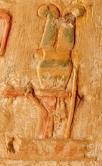
OccID = 3101
Monument : Temple of Ramses II (Abydos)
Monument type : Temple
Localisation or provenance : Abydos
Period : Dynasty XIX
Reign(s) : Ramses II
Approximate date : 1279 - 1213
ExemplarID = 415 - statistical relevance rating : *
Colours used : plumes green, wig alternate green and yellow, standard red, irrigation channels red(?)

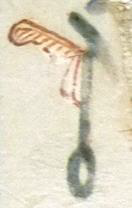
OccID = 2533
Monument : Nakht TT.52
Monument type : Private Tomb
Localisation or provenance : Sheikh Abd el-Gurna
Period : Dynasty XVIII
Reign(s) : Thutmose IV
Approximate date : 1400 - 1390
ExemplarID = 416 - statistical relevance rating : *****
Colours used : sceptre green, feather and fillet white with red markings


OccID = 202
Monument : Wepemnefret G1201
Monument type : Slab stela
Localisation or provenance : Giza
Period : Dynasty IV
Reign(s) : Khufu
Approximate date : 2589 - 2566
ExemplarID = 417 - statistical relevance rating : *
Colours used : yellow with black markings and black horns
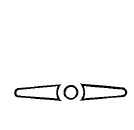

OccID = 2813
Monument : Nakht-Min TT.87
Monument type : Private Tomb
Localisation or provenance : Sheikh Abd el-Gurna
Period : Dynasty XVIII
Reign(s) : Thutmose III
Approximate date : 1479 - 1425
ExemplarID = 418 - statistical relevance rating : ***
Colours used : ends red, centre white
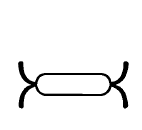

OccID = 2068
Monument : Ramses I KV.16
Monument type : Royal Tomb
Localisation or provenance : Valley of the Kings
Period : Dynasty XIX
Reign(s) : Ramses I
Approximate date : 1295 - 1294
ExemplarID = 419 - statistical relevance rating : *
Colours used : inner yellow, bows red


OccID = 1819
Monument : Peftjauneith
Monument type : Coffin
Localisation or provenance : Sais
Period : Dynasty XXVI
Reign(s) : ?
Approximate date : 664 - 525
ExemplarID = 420 - statistical relevance rating : *
Colours used : bows red, packaging blue with red binding
This group contains fifty signs, of which twenty-three (46%) have database occurrences, all with images.
Of all the hieroglyphic crowns (see Goebs 2001), that of Lower Egypt S3 is the most frequently encountered. It is always, unsurprisingly, painted red (the name of the crown is dSrt - “the red one”). Two of the occurrences have a yellow fill between the high rear of the crown and the loop that rises from the top middle. Both of these are Ramesside royal tomb occurrences, which explains the use of yellow in place of white. The use of a fill in this situation seems superfluous, especially as the crown itself must have been familiar to the elite.
The two crowns of Upper and Lower Egypt on a basket S6 are normally shown merged into one : the “pschent” - pA-sxmty. However, in this exemplar they are drawn separately. The crown of Upper Egypt is white and that of Lower Egypt is red. The basket V30 is canonical green. Apart from the latter exemplar, no individual white crown S1 occurrence has so far been recorded in the database, but when found it is highly likely that it will be all white (the name of the crown is HDt - “the white one” or “the brilliant one”).
The other crown represented here is the atef crown S8 - a high, conical structure somewhat similar to S1 but with an ornate topknot and two ostrich plumes on either side. In this case, but not always, two ram’s horns protrude from the base of the crown, marking it as an accoutrement of the god Amon. The single occurrence recorded here is from a “yellow background” Ramesside tomb (Mon.43) so the green colour given to the crown is a substitute for white (see chapter 8 - Diachrony). This is confirmed by the many images of Osiris wearing the crown that can be seen in wall-paintings (e.g. Hawass 2006, 89). In this exemplar, the ostrich plumes and horns are simply sketched in red outline. The exemplar of the atef crown may provide some information about the material used to make the white crown S1. The substitution of green for white can also be seen in this inscription (Mon.43) in the green linen seen in the clothing worn by the men in group A (A1, A2, A30, A51, A52, A313). This is significant as white is still used elsewhere, so the substitution of green for white is not mandatory. It is therefore possible that the crown was made of stiffened white linen. However, as no white (or red) crowns have survived in the archaeological record, this must remain pure speculation.
The heading “dress” in Gardiner’s classification covers several sub-categories, from jewellery and cylinder seals to clothing, cloth and footwear. Jewellery is represented here by the collar S12, a multi-coloured bead necklace, attached to a band of red cloth.
The cylinder seals S19 and S20 show the same object, but viewed from different angles. The colours used suggest a gold chain or a length of cord with a cylinder seal in white or blue, both of which can represent stone.
Clothing contains just one occurrence of the kilt S26 in red. This could be either prestigious cloth or maybe red-brown leather. The girdle knot S24, also in red or sometimes blue, would suggest a belt of either red cloth or blue leather.
This predilection for red cloth is best seen in the ubiquitous sign for a length of folded cloth S29 . This is the third most common sign in the database with 47 of the 48 occurrences (98%) being red. It is, in fact, an excellent marker for comparison with other red signs. It is somewhat surprising that a people who dressed almost exclusively in white linen should represent cloth in hieroglyphs by the red variety. Linen was notoriously difficult to dye permanently and this red variety was thus highly valued (Vogelsang-Eastwood 2000, 278). Prestigious red cloth therefore appears to have been foremost in the Egyptian mind. This choice of an archetype to represent a cognitive category is an example of “prototype categorisation” (Taylor 2003, 41-83). The powerful symbolic nature of red cloth for the Egyptians is evident from some passages in the Pyramid Texts. An extract from spell W 161 (PT 250 ; §268a-b) reads : “Unis is the one who says the great thing in the (Sun’s) heart on the festival of red linen” (Allen 2005, 42). An extract from spell W 165 (PT 254 ; §285d) reads : “you shall worship the Sun in his escape from fetters by means of the Great One’s aegis, which is his red linen” (Allen 2005, 44). Allen interprets the latter as being “A reference to the rising sun and the sky’s color at dawn” (2005, 63, note 53). Offerings of red cloth were made to the gods. Anubis is often shown with a red neckerchief. Goddesses are often depicted in long red robes.
Footwear is represented by two signs : a sandal S33, seen from above, and the ankh S34, identified by Gardiner as a sandal strap. Both occurrences of S33 are yellow, probably representing dried plant fibre, such as is found in surviving examples (e.g. Peck, 2013, 150, fig. 68). However, the ankh is always coloured dark blue or black, probably indicating symbolic polychromy.
The ankh S34 is one of the most frequent as well as one of the most intriguing hieroglyphs and has been the subject of much discussion and speculation. The sign, when used as an ideogram, means “a sandal strap”. The dark blue or black colouring does not correspond to the reality of woven plant fibre, but could represent leather, examples of which can be found in the archaeological record (Driel-Murray 2000). However, were the symbolic, metaphorical meaning to have more importance than the materialistic representation, then the designation “sandal strap” could still be correct. This same phenomenon can be seen in the sign for the “bad bird” G37 that is coloured red to represent danger or aggression (see the commentary on G37). The word anx can also mean “a mirror”. However, it is difficult to reconcile this identification with the use of a white fill to represent empty space. This way of showing a loop can be clearly seen in the many images of gods who hold the ankh sign with their fingers passing through the loop (e.g. Tiradritti 2008, 287; 291). Another suggestion for an identification is that of a bull’s thoracic vertebra (Schwabe et al. 1982). The hollow loop is present in the vertebra, but the many detailed images of ankh signs often show some kind of woven fibre. Also, the colour blue-black does not correspond to the colour of cattle bones. Baines (1975, 1-24) has suggested a belt looped around the hips, with an attached penis-sheath. This would be possible but unlikely, given the differences between the sign and the proposed object. The colour blue also makes this identification difficult. This leaves us with a metaphorical use of colour, whatever the correct identification of the object. Dark blue or black have multiple associations including the underworld, Nile silt, the flood, fertility, (re)birth, the land of Egypt etc. They all, in some way, contribute to the theme of life as seen in the many lexemes that use the sign (FCD 43-44; Wb I, 193-205). However, the association between the metaphor and the object, together with the exact ritual significance, remains an enduring mystery.
The final sub-category in Gardiner’s group S is “staves”. This includes walking-sticks, staves, crooks and sceptres. The most obvious use of colour here is for the walking-stick S43, which is always red or yellow. Both of these colours can represent wood, which seems to be the case here. The crook S38, part of the royal regalia, is probably a ceremonial reduced-size version of the larger shepherd’s crook S39 (no database occurrences). As a ceremonial object, the colours yellow and blue indicate gold, or gilded wood with bands of blue inlay, just as for those found in the tomb of Tutankhamun (KV.62) (e.g. Tiradritti 1999, 228-229). The sceptre sekhem S42, symbol of power, is also yellow, representing wood, possibly gilded. The word sxm can also be written with the determinative for wood M3 (FCD 241).
One of the most interesting sceptres recorded in the database is the wAs S40. This appears, at least originally, to be a kind of shepherd’s crook with a forked base for trapping animals. The handle at the top is often represented as the head of the “Seth-animal”. The unusual aspect here is the use of blue-green for the whole sign. It is difficult to see why a colour normally symbolising growth, vegetation, fresh plant fibre etc. should be used here. The same colour is used in the similar sign for a wAs sceptre with a filet and feather R19. The metaphorical symbolism is obscure.


OccID = 2864
Monument : Paroy TT.295
Monument type : Private Tomb
Localisation or provenance : Khokha
Period : Dynasty XVIII
Reign(s) : Thutmose IV - Amenhotep III
Approximate date : 1400 - 1352
ExemplarID = 426 - statistical relevance rating : *****
Colours used : red


OccID = 3334
Monument : Karnak Room XII
Monument type : Temple
Localisation or provenance : Karnak
Period : Dynasty XVIII
Reign(s) : Hatshepsut
Approximate date : 1473 - 1458
ExemplarID = 421 - statistical relevance rating : *
Colours used : white crown white, red crown red, basket green


OccID = 2681
Monument : Nefersekheru TT.296
Monument type : Private Tomb
Localisation or provenance : Khokha
Period : Dynasty XIX
Reign(s) : Ramses II
Approximate date : 1279 - 1213
ExemplarID = 428 - statistical relevance rating : *
Colours used : main crown green, feathers red, horns green


OccID = 3261
Monument : Penmaât
Monument type : Mummy board
Localisation or provenance : Sheikh Abd el-Gurna
Period : Dynasty XXII
Reign(s) : Osorkon I - ?
Approximate date : 945 - 715
ExemplarID = 427 - statistical relevance rating : **
Colours used : cloth red, tie white


OccID = 1341
Monument : Sarenput II
Monument type : Private Tomb
Localisation or provenance : Elephantine
Period : Dynasty XII
Reign(s) : Amenemhat II
Approximate date : 1911 - 1877
ExemplarID = 423 - statistical relevance rating : ****
Colours used : blue with red cord


OccID = 1457
Monument : Sobekhotep TT.63
Monument type : Private Tomb
Localisation or provenance : Sheikh Abd el-Gurna
Period : Dynasty XVIII
Reign(s) : Thutmose IV
Approximate date : 1400 - 1390
ExemplarID = 424 - statistical relevance rating : ****
Colours used : necklace and seal yellow with red outline


OccID = 2298
Monument : Rekhmire TT.100
Monument type : Private Tomb
Localisation or provenance : Sheikh Abd el-Gurna
Period : Dynasty XVIII
Reign(s) : Thutmose III - Amenhotep II
Approximate date : 1479 - 1400
ExemplarID = 425 - statistical relevance rating : ****
Colours used : necklace yellow, crosspiece green with ends yellow and red, seal red


OccID = 3038
Monument : Temple of Ramses II (Abydos)
Monument type : Temple
Localisation or provenance : Abydos
Period : Dynasty XIX
Reign(s) : Ramses II
Approximate date : 1279 - 1213
ExemplarID = 429 - statistical relevance rating : **
Colours used : loop green, flabella yellow, markings red


OccID = 1251
Monument : Horemheb KV.57
Monument type : Royal Tomb
Localisation or provenance : Valley of the Kings
Period : Dynasty XVIII
Reign(s) : Horemheb
Approximate date : 1323 - 1295
ExemplarID = 431 - statistical relevance rating : ****
Colours used : knot and tie green, yellow fill


OccID = 1424
Monument : Huy TT.54
Monument type : Private Tomb
Localisation or provenance : Sheikh Abd el-Gurna
Period : Dynasty XVIII
Reign(s) : Thutmose IV - Amenhotep III
Approximate date : 1400 - 1352
ExemplarID = 430 - statistical relevance rating : ****
Colours used : girdle (open-ended) yellow, red outline


OccID = 625
Monument : Ankhmerire
Monument type : Mastaba
Localisation or provenance : Saqqara
Period : Dynasty VI
Reign(s) : Pepy I
Approximate date : 2321 - 2287
ExemplarID = 432 - statistical relevance rating : *
Colours used : red


OccID = 162
Monument : Wepemnefret G1201
Monument type : Slab stela
Localisation or provenance : Giza
Period : Dynasty IV
Reign(s) : Khufu
Approximate date : 2589 - 2566
ExemplarID = 433 - statistical relevance rating : **
Colours used : outline red, fill white
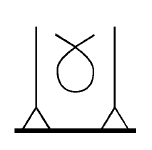

OccID = 1579
Monument : Khonsou-Tefnakht E.586
Monument type : Coffin
Localisation or provenance : El Hibeh
Period : Dynasty XXVII
Reign(s) : ?
Approximate date : 525 - 404
ExemplarID = 435 - statistical relevance rating : ***
Colours used : cloth red, linen bag blue outline


OccID = 1443
Monument : Sobekhotep TT.63
Monument type : Private Tomb
Localisation or provenance : Sheikh Abd el-Gurna
Period : Dynasty XVIII
Reign(s) : Thutmose IV
Approximate date : 1400 - 1390
ExemplarID = 436 - statistical relevance rating : *****
Colours used : red


OccID = 2857
Monument : Paroy TT.295
Monument type : Private Tomb
Localisation or provenance : Khokha
Period : Dynasty XVIII
Reign(s) : Thutmose IV - Amenhotep III
Approximate date : 1400 - 1352
ExemplarID = 440 - statistical relevance rating : *****
Colours used : red, fill white


OccID = 3594
Monument : Ramses IV KV.2
Monument type : Royal Tomb
Localisation or provenance : Valley of the Kings
Period : Dynasty XX
Reign(s) : Ramses IV
Approximate date : 1153 - 1147
ExemplarID = 437 - statistical relevance rating : *
Colours used : cloth green with blue lines, fringe blue


OccID = 3818
Monument : Temple of Sety I - Abydos
Monument type : Temple
Localisation or provenance : Abydos
Period : Dynasty XIX
Reign(s) : Sety I
Approximate date : 1294 - 1279
ExemplarID = 438 - statistical relevance rating : **
Colours used : yellow
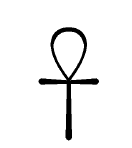

OccID = 3480
Monument : Amenhotep III KV.22
Monument type : Royal Tomb
Localisation or provenance : Valley of the Kings
Period : Dynasty XVIII
Reign(s) : Amenhotep III
Approximate date : 1390 - 1352
ExemplarID = 439 - statistical relevance rating : *****
Colours used : dark blue, fill white


OccID = 3918
Monument : Rekhmire TT.100
Monument type : Private Tomb
Localisation or provenance : Sheikh Abd el-Gurna
Period : Dynasty XVIII
Reign(s) : Thutmose III - Amenhotep II
Approximate date : 1479 - 1400
ExemplarID = 441 - statistical relevance rating : **
Colours used : handle yellow, feathers white, tips green or blue


OccID = 2477
Monument : Menna TT.69
Monument type : Private Tomb
Localisation or provenance : Sheikh Abd el-Gurna
Period : Dynasty XVIII
Reign(s) : Thutmose IV
Approximate date : 1400 - 1390
ExemplarID = 442 - statistical relevance rating : *****
Colours used : yellow with bands blue


OccID = 3763
Monument : Ay KV.23
Monument type : Royal Tomb
Localisation or provenance : Valley of the Kings
Period : Dynasty XVIII
Reign(s) : Ay
Approximate date : 1327 - 1323
ExemplarID = 443 - statistical relevance rating : ****
Colours used : sceptre green, fill white


OccID = 2722
Monument : Rekhmire TT.100
Monument type : Private Tomb
Localisation or provenance : Sheikh Abd el-Gurna
Period : Dynasty XVIII
Reign(s) : Thutmose III - Amenhotep II
Approximate date : 1479 - 1400
ExemplarID = 444 - statistical relevance rating : ****
Colours used : yellow


OccID = 2054
Monument : Ramses I KV.16
Monument type : Royal Tomb
Localisation or provenance : Valley of the Kings
Period : Dynasty XIX
Reign(s) : Ramses I
Approximate date : 1295 - 1294
ExemplarID = 445 - statistical relevance rating : *****
Colours used : red
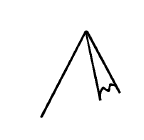

OccID = 3775
Monument : Temple of Sety I - Abydos
Monument type : Temple
Localisation or provenance : Abydos
Period : Dynasty XIX
Reign(s) : Sety I
Approximate date : 1294 - 1279
ExemplarID = 446 - statistical relevance rating : *
Colours used : yellow, markings red


OccID = 3260
Monument : Penmaât
Monument type : Mummy board
Localisation or provenance : Sheikh Abd el-Gurna
Period : Dynasty XXII
Reign(s) : Osorkon I - ?
Approximate date : 945 - 715
ExemplarID = 447 - statistical relevance rating : *
Colours used : head cloth white, outline and neck extension red
This group contains thirty-six signs, of which twenty-seven (75%) have database occurrences, twenty-one with images. This grouping of warfare, hunting and butchery is logical as it is essentially a collection of arms, used in a similar fashion but in different contexts.
T1, T3, T4, T5 and T6 all represent maces : weapons used for crushing the skull of an enemy, as seen in the iconic pharaonic pose of ritual slaughter (e.g. Tiradritti 1999, 41). T1 is a type found in predynastic Naqadan contexts and has a stone disk with a hole for attaching it to a handle (Hoffmeier 2001, 407). The exemplar found here is all yellow, either representing a gilded ceremonial mace or one in which the stone and the wooden shaft have the same colour. It is more likely to be a ceremonial object as this occurrence is from the Dynasty XVIII tomb of Rekhmire (Mon.39). The more recent type, exemplified by T3, has a wooden (red) or gilded (yellow) shaft and a round stone head, coloured white. The sign also reads HD “white” or “brilliant”. T4 has a loop of cloth tied around the shaft to improve the grip, but is otherwise the same as T3. T5 and T6 combine T3 with I10 serpents.
The axe T7 is the archaic type used for hewing wood as well as a battle axe (EG 511, T7 note 1). The shaft is yellow (wood) and the axe blade is black, probably indicating flint or obsidian (Aston 2000, 46-47).
T9, T10, T11 and T12 concern archery. The colours used reflect the construction material : red or yellow for wood, yellow for the bow string and black for the arrow flights. Interestingly, in the exemplar shown here, the arrow has no arrowhead, perhaps to avoid injury to the person reading the inscription (cf. the missing head and sting of the scorpion L7).
The harpoon T19 provides an interesting use of yellow to represent bone. The sign can in fact be used as a determinative or phoneme for qs “bone” (Wb V, 68). The other, more elaborate, harpoon T21 has a red wooden shaft and a black tip, probably made of flint.
The arrows T22 and T23 are nearly always entirely red. This is probably as a metaphor for danger and aggression, as a wooden arrowhead would not be particularly efficient. One occurrence of T22 does however have a blue tip which would indicate a flint arrowhead.
The butcher’s block T28 presents some difficulty for its identification. Gardiner justifies the description of a butcher’s block only by comparison with T29 (no database occurrence) which shows a knife T30 positioned above T28. However, this does not constitute a proof as the same kind of juxtaposition of the knife and the legs seen in T32 in no way connects the two signs in this manner. Furthermore, the components of the block, together with their different colours, render any explanation difficult. In the exemplar shown here, there appears to be an outer structure in dark blue. This could be stone or dried mud. Inside, surrounded by a white fill, there is a red core, with a characteristic shape of a rectangle drawn in at the centre. This could be a drain for the blood. Variants mostly comply with this colour scheme. However, no such object can be seen in the many wall paintings depicting the slaughter and butchery of animals (e.g. Tiradritti 2008, 144-146).
The signs T18, T30, T31, T32 and T34 show knives or knife sharpeners. The distinction is often unclear. Knives can be red as a symbol of danger and aggression or as a representation of copper. Knife sharpeners (T31 and T32) are green, probably depicting some kind of hard stone or else through confusion or association with the basket V31 with which T32 shares its outline. In fact most of the database occurrences of T32 appear to show the basket rather than a sharpener. The butcher’s knife T34 is red or green, possibly as a representation of copper. It can also have a red or a blue handle. Blue may represent leather and red can be wood. T18 is a complex, composite sign with several elements. Some sort of package is lashed to a crook, with a knife or a sharpener protruding from the top. In this exemplar, it appears to be a sharpener, as it is green. Below the package is a red protuberance, perhaps a knife, but in this case interpreted as a foot, probably as a reference to the reading of the sign as Sms “follow” (Wb IV, 482-487). Perhaps an early function of a pharaoh’s court was that of ceremonial knife sharpener (cf. EG 513, note 1)?


OccID = 2380
Monument : Rekhmire TT.100
Monument type : Private Tomb
Localisation or provenance : Sheikh Abd el-Gurna
Period : Dynasty XVIII
Reign(s) : Thutmose III - Amenhotep II
Approximate date : 1479 - 1400
ExemplarID = 448 - statistical relevance rating : *
Colours used : yellow


OccID = 2314
Monument : Rekhmire TT.100
Monument type : Private Tomb
Localisation or provenance : Sheikh Abd el-Gurna
Period : Dynasty XVIII
Reign(s) : Thutmose III - Amenhotep II
Approximate date : 1479 - 1400
ExemplarID = 450 - statistical relevance rating : *****
Colours used : handle yellow, head white


OccID = 3467
Monument : Amenhotep III KV.22
Monument type : Royal Tomb
Localisation or provenance : Valley of the Kings
Period : Dynasty XVIII
Reign(s) : Amenhotep III
Approximate date : 1390 - 1352
ExemplarID = 449 - statistical relevance rating : **
Colours used : mace head white, handle yellow with horizontal lines and outline red, strap white

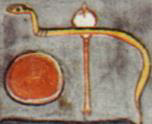
OccID = 2101
Monument : Ramses I KV.16
Monument type : Royal Tomb
Localisation or provenance : Valley of the Kings
Period : Dynasty XIX
Reign(s) : Ramses I
Approximate date : 1295 - 1294
ExemplarID = 451 - statistical relevance rating : **
Colours used : serpent yellow with back and features black, mace yellow with white head


OccID = 2661
Monument : Nefersekheru TT.296
Monument type : Private Tomb
Localisation or provenance : Khokha
Period : Dynasty XIX
Reign(s) : Ramses II
Approximate date : 1279 - 1213
ExemplarID = 452 - statistical relevance rating : *
Colours used : serpents green, mace blue
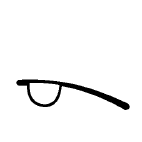

OccID = 205
Monument : Wepemnefret G1201
Monument type : Slab stela
Localisation or provenance : Giza
Period : Dynasty IV
Reign(s) : Khufu
Approximate date : 2589 - 2566
ExemplarID = 453 - statistical relevance rating : **
Colours used : yellow, lashings and blade black


OccID = 3278
Monument : Penmaât
Monument type : Mummy board
Localisation or provenance : Sheikh Abd el-Gurna
Period : Dynasty XXII
Reign(s) : Osorkon I - ?
Approximate date : 945 - 715
ExemplarID = 454 - statistical relevance rating : *
Colours used : red


OccID = 3817
Monument : Temple of Sety I - Abydos
Monument type : Temple
Localisation or provenance : Abydos
Period : Dynasty XIX
Reign(s) : Sety I
Approximate date : 1294 - 1279
ExemplarID = 456 - statistical relevance rating : ***
Colours used : yellow


OccID = 206
Monument : Wepemnefret G1201
Monument type : Slab stela
Localisation or provenance : Giza
Period : Dynasty IV
Reign(s) : Khufu
Approximate date : 2589 - 2566
ExemplarID = 457 - statistical relevance rating : ***
Colours used : yellow shaft, red outline, black flights


OccID = 2433
Monument : Rekhmire TT.100
Monument type : Private Tomb
Localisation or provenance : Sheikh Abd el-Gurna
Period : Dynasty XVIII
Reign(s) : Thutmose III - Amenhotep II
Approximate date : 1479 - 1400
ExemplarID = 458 - statistical relevance rating : **
Colours used : yellow
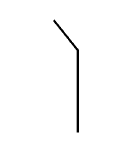

OccID = 3266
Monument : Penmaât
Monument type : Mummy board
Localisation or provenance : Sheikh Abd el-Gurna
Period : Dynasty XXII
Reign(s) : Osorkon I - ?
Approximate date : 945 - 715
ExemplarID = 459 - statistical relevance rating : ***
Colours used : red


OccID = 3268
Monument : Penmaât
Monument type : Mummy board
Localisation or provenance : Sheikh Abd el-Gurna
Period : Dynasty XXII
Reign(s) : Osorkon I - ?
Approximate date : 945 - 715
ExemplarID = 460 - statistical relevance rating : **
Colours used : shaft blue, knife green, bundle red, leg red


OccID = 1605
Monument : Khonsou-Tefnakht E.586
Monument type : Coffin
Localisation or provenance : El Hibeh
Period : Dynasty XXVII
Reign(s) : ?
Approximate date : 525 - 404
ExemplarID = 461 - statistical relevance rating : *
Colours used : yellow with blue/black outline


OccID = 3267
Monument : Penmaât
Monument type : Mummy board
Localisation or provenance : Sheikh Abd el-Gurna
Period : Dynasty XXII
Reign(s) : Osorkon I - ?
Approximate date : 945 - 715
ExemplarID = 462 - statistical relevance rating : ****
Colours used : shaft red, head blue, rope blue(?)


OccID = 3695
Monument : Ramses V-VI KV.9
Monument type : Royal Tomb
Localisation or provenance : Valley of the Kings
Period : Dynasty XX
Reign(s) : Ramses V - VI
Approximate date : 1147 - 1136
ExemplarID = 463 - statistical relevance rating : ****
Colours used : red
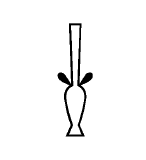

OccID = 2860
Monument : Paroy TT.295
Monument type : Private Tomb
Localisation or provenance : Khokha
Period : Dynasty XVIII
Reign(s) : Thutmose IV - Amenhotep III
Approximate date : 1400 - 1352
ExemplarID = 465 - statistical relevance rating : ****
Colours used : red


OccID = 1737
Monument : Tjanuni TT.74
Monument type : Private Tomb
Localisation or provenance : Sheikh Abd el-Gurna
Period : Dynasty XVIII
Reign(s) : Thutmose IV
Approximate date : 1400 - 1390
ExemplarID = 466 - statistical relevance rating : *****
Colours used : outline black, corners blue, fill white, centre red


OccID = 2384
Monument : Rekhmire TT.100
Monument type : Private Tomb
Localisation or provenance : Sheikh Abd el-Gurna
Period : Dynasty XVIII
Reign(s) : Thutmose III - Amenhotep II
Approximate date : 1479 - 1400
ExemplarID = 468 - statistical relevance rating : ***
Colours used : red


OccID = 3287
Monument : Penmaât
Monument type : Mummy board
Localisation or provenance : Sheikh Abd el-Gurna
Period : Dynasty XXII
Reign(s) : Osorkon I - ?
Approximate date : 945 - 715
ExemplarID = 469 - statistical relevance rating : *
Colours used : green


OccID = 3778
Monument : Temple of Sety I - Abydos
Monument type : Temple
Localisation or provenance : Abydos
Period : Dynasty XIX
Reign(s) : Sety I
Approximate date : 1294 - 1279
ExemplarID = 470 - statistical relevance rating : *****
Colours used : sharpener green, legs red
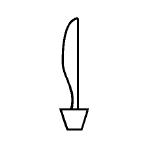

OccID = 2482
Monument : Menna TT.69
Monument type : Private Tomb
Localisation or provenance : Sheikh Abd el-Gurna
Period : Dynasty XVIII
Reign(s) : Thutmose IV
Approximate date : 1400 - 1390
ExemplarID = 471 - statistical relevance rating : **
Colours used : red
This group contains forty-three signs, of which twenty-nine (67%) have database occurrences, twenty-four with images.
The agricultural tools provide an interesting contrast. The sickles U1, U3 and U4 are green or green-blue, whereas the hoes U6, U7 and U8 are all red. This must, surely, reflect the use to which these tools are put. The green sickles have a metaphorical association with fresh growth and vegetation. The red hoes are probably just images of wooden tools with no metaphorical symbolism. The sickle U2, however, is yellow which could indicate either an association with ripened emmer or simply wood. The exemplar shown here also has pieces of black flint along the cutting edge.
The association of green with fresh vegetation can also be seen in the corn-measure U9 which has a stream of corn grains pouring out. The grains are coloured green rather than the yellow that would be expected for ripened cereal. This could represent abundance.
Many of the tools in group U are red or have red handles. This clearly represents wood. Examples are the sledge U15, the adze U19, the handle of the chisel U22 and the pestle U33. Red can also represent copper, as seen in the blade of the chisel U23. Blue or black represent hard stone, such as in the base of the fire-drill U28 or the fuller’s club U36. The different uses of these colours can help in the identification of the separate parts of some of the more complex signs such as the drill U24* which appears to have a curved wooden handle to produce rotation, a bound plant fibre ring for steadying the drill and a copper drill bit.


OccID = 1738
Monument : Tjanuni TT.74
Monument type : Private Tomb
Localisation or provenance : Sheikh Abd el-Gurna
Period : Dynasty XVIII
Reign(s) : Thutmose IV
Approximate date : 1400 - 1390
ExemplarID = 472 - statistical relevance rating : ****
Colours used : green


OccID = 1529
Monument : Khonsou-Tefnakht E.586
Monument type : Coffin
Localisation or provenance : El Hibeh
Period : Dynasty XXVII
Reign(s) : ?
Approximate date : 525 - 404
ExemplarID = 473 - statistical relevance rating : ****
Colours used : yellow with blue or black outline and teeth on blade


OccID = 2501
Monument : Nakht TT.52
Monument type : Private Tomb
Localisation or provenance : Sheikh Abd el-Gurna
Period : Dynasty XVIII
Reign(s) : Thutmose IV
Approximate date : 1400 - 1390
ExemplarID = 474 - statistical relevance rating : **
Colours used : sickle green, eyeball white, outline yellow, iris black


OccID = 3271
Monument : Penmaât
Monument type : Mummy board
Localisation or provenance : Sheikh Abd el-Gurna
Period : Dynasty XXII
Reign(s) : Osorkon I - ?
Approximate date : 945 - 715
ExemplarID = 475 - statistical relevance rating : ****
Colours used : sickle green, plinth blue


OccID = 3060
Monument : Temple of Ramses II (Abydos)
Monument type : Temple
Localisation or provenance : Abydos
Period : Dynasty XIX
Reign(s) : Ramses II
Approximate date : 1279 - 1213
ExemplarID = 476 - statistical relevance rating : ****
Colours used : hoe red, rope yellow


OccID = 1346
Monument : Sarenput II
Monument type : Private Tomb
Localisation or provenance : Elephantine
Period : Dynasty XII
Reign(s) : Amenemhat II
Approximate date : 1911 - 1877
ExemplarID = 477 - statistical relevance rating : ****
Colours used : red, rope yellow


OccID = 2925
Monument : Userhat TT.56
Monument type : Private Tomb
Localisation or provenance : Sheikh Abd el-Gurna
Period : Dynasty XVIII
Reign(s) : Amenhotep II
Approximate date : 1427 - 1400
ExemplarID = 478 - statistical relevance rating : ***
Colours used : red
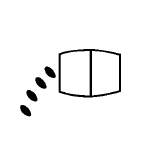

OccID = 1921
Monument : Peftjauneith
Monument type : Coffin
Localisation or provenance : Sais
Period : Dynasty XXVI
Reign(s) : ?
Approximate date : 664 - 525
ExemplarID = 479 - statistical relevance rating : ***
Colours used : measure yellow, corn green


OccID = 2056
Monument : Ramses I KV.16
Monument type : Royal Tomb
Localisation or provenance : Valley of the Kings
Period : Dynasty XIX
Reign(s) : Ramses I
Approximate date : 1295 - 1294
ExemplarID = 480 - statistical relevance rating : *****
Colours used : red, fill white


OccID = 2389
Monument : Rekhmire TT.100
Monument type : Private Tomb
Localisation or provenance : Sheikh Abd el-Gurna
Period : Dynasty XVIII
Reign(s) : Thutmose III - Amenhotep II
Approximate date : 1479 - 1400
ExemplarID = 481 - statistical relevance rating : *
Colours used : pick red, pool blue


OccID = 2913
Monument : Userhat TT.56
Monument type : Private Tomb
Localisation or provenance : Sheikh Abd el-Gurna
Period : Dynasty XVIII
Reign(s) : Amenhotep II
Approximate date : 1427 - 1400
ExemplarID = 482 - statistical relevance rating : **
Colours used : red
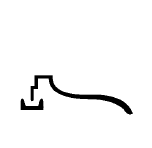

OccID = 1260
Monument : Horemheb KV.57
Monument type : Royal Tomb
Localisation or provenance : Valley of the Kings
Period : Dynasty XVIII
Reign(s) : Horemheb
Approximate date : 1323 - 1295
ExemplarID = 483 - statistical relevance rating : ****
Colours used : black


OccID = 127
Monument : Haremheb TT.78
Monument type : Private Tomb
Localisation or provenance : Sheikh Abd el-Gurna
Period : Dynasty XVIII
Reign(s) : Thutmose III - Amenhotep III
Approximate date : 1479 - 1352
ExemplarID = 484 - statistical relevance rating : **
Colours used : handle red, point blue


OccID = 1742
Monument : Tjanuni TT.74
Monument type : Private Tomb
Localisation or provenance : Sheikh Abd el-Gurna
Period : Dynasty XVIII
Reign(s) : Thutmose IV
Approximate date : 1400 - 1390
ExemplarID = 485 - statistical relevance rating : ****
Colours used : blade(?) red, handle green with yellow band


OccID = 1348
Monument : Sarenput II
Monument type : Private Tomb
Localisation or provenance : Elephantine
Period : Dynasty XII
Reign(s) : Amenemhat II
Approximate date : 1911 - 1877
ExemplarID = 486 - statistical relevance rating : **
Colours used : drill yellow, head blue


OccID = 1885
Monument : Peftjauneith
Monument type : Coffin
Localisation or provenance : Sais
Period : Dynasty XXVI
Reign(s) : ?
Approximate date : 664 - 525
ExemplarID = 487 - statistical relevance rating : **
Colours used : handle red, weight green with yellow band, shaft red with green lashing
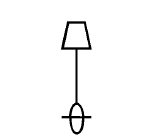

OccID = 2693
Monument : Nefersekheru TT.296
Monument type : Private Tomb
Localisation or provenance : Khokha
Period : Dynasty XIX
Reign(s) : Ramses II
Approximate date : 1279 - 1213
ExemplarID = 488 - statistical relevance rating : **
Colours used : drill holder green, outline blue, bit and bead red(?)


OccID = 3275
Monument : Penmaât
Monument type : Mummy board
Localisation or provenance : Sheikh Abd el-Gurna
Period : Dynasty XXII
Reign(s) : Osorkon I - ?
Approximate date : 945 - 715
ExemplarID = 489 - statistical relevance rating : ****
Colours used : drill red, base blue


OccID = 1442
Monument : Sobekhotep TT.63
Monument type : Private Tomb
Localisation or provenance : Sheikh Abd el-Gurna
Period : Dynasty XVIII
Reign(s) : Thutmose IV
Approximate date : 1400 - 1390
ExemplarID = 490 - statistical relevance rating : ****
Colours used : base blue(?), drill yellow with two red oblique lines


OccID = 696
Monument : Ankhmerire
Monument type : Mastaba
Localisation or provenance : Saqqara
Period : Dynasty VI
Reign(s) : Pepy I
Approximate date : 2321 - 2287
ExemplarID = 492 - statistical relevance rating : ****
Colours used : kiln blue, upper and lower parts red


OccID = 1569
Monument : Khonsou-Tefnakht E.586
Monument type : Coffin
Localisation or provenance : El Hibeh
Period : Dynasty XXVII
Reign(s) : ?
Approximate date : 525 - 404
ExemplarID = 493 - statistical relevance rating : ***
Colours used : pestle red, mortar green


OccID = 2394
Monument : Rekhmire TT.100
Monument type : Private Tomb
Localisation or provenance : Sheikh Abd el-Gurna
Period : Dynasty XVIII
Reign(s) : Thutmose III - Amenhotep II
Approximate date : 1479 - 1400
ExemplarID = 495 - statistical relevance rating : *****
Colours used : red


OccID = 165
Monument : Wepemnefret G1201
Monument type : Slab stela
Localisation or provenance : Giza
Period : Dynasty IV
Reign(s) : Khufu
Approximate date : 2589 - 2566
ExemplarID = 496 - statistical relevance rating : *****
Colours used : black


OccID = 3276
Monument : Penmaât
Monument type : Mummy board
Localisation or provenance : Sheikh Abd el-Gurna
Period : Dynasty XXII
Reign(s) : Osorkon I - ?
Approximate date : 945 - 715
ExemplarID = 497 - statistical relevance rating : *
Colours used : red outline drawing


OccID = 3702
Monument : Ramses V-VI KV.9
Monument type : Royal Tomb
Localisation or provenance : Valley of the Kings
Period : Dynasty XX
Reign(s) : Ramses V - VI
Approximate date : 1147 - 1136
ExemplarID = 498 - statistical relevance rating : *
Colours used : black
This group contains thirty-nine signs, plus two additional variants, of which thirty-three (80%) have database occurrences, twenty-eight with images. The group contains some very common hieroglyphs.
Many signs in group V can have several different colours, showing high diachronic variation. As has been demonstrated (see Diachrony), signs such as the baskets V30 and V31, as well as the signs for rope such as V13 and V28, evolve from yellow to green, with some variants of red or blue (as substitutes for yellow and green).
The earliest forms of the group V signs show much detail. For Mon.6, the Dynasty IV stele of Wepemnofret, the signs V4, V6, V13, V30 and V31 all show the method of manufacture of the rope and of the baskets. The fibre used is dried, as shown by the colour yellow. Later occurrences become green, showing either fresh plant fibre, or a metaphorical association with growth and abundance. The latter is more probable as even fresh plant fibre would have quickly turned yellow or brown in the dry climate of Egypt. For more detail on the materials and techniques involved, see Wendrich (2000).
The tethering rope V14 presents an interesting case as it is the only hieroglyph with a diacritical mark. The significance is unclear, especially as there is little discernible difference in use between V14 and V13. Gardiner suggests that it represents the consonant T where it has not evolved into t but has kept the original pronunciation (EG 523). That this is a true diacritical mark and not just some appendage can be seen clearly in this exemplar, as the black dot is separated from the tether and is of a different colour.
The sign V16 shows a looped cord used for immobilising animals. Gardiner suggests cattle but I have personally witnessed this exact method of immobilising sheep at a Silk Road market in Western China. The sheep’s necks are placed in the loops with their heads facing one another and their rear ends facing outwards. In this way a small herd can be kept together, unmoving, whilst awaiting sale or slaughter. The hobble for cattle V20 and its derivative V21 are on the contrary made of wood (as they are coloured red) and are for immobilising individual animals.
The whip V22 and its Old Kingdom version V23 are made from plant fibre and show the same evolution from yellow to green of rope and basketry. The exemplar of V23 is quite detailed and allows us to see the coiling of the fibre to form a handle.
The sign V25 shows string wound onto a stick. The stick is red and the string yellow, showing it to be a coarser variety than the white thread shown in the sign for a weaver’s shuttle V26.
There is some confusion between the wickerwork frail V3 and the sign W8, identified by Gardiner as a deformation of the granite bowl W7 (EG 528). The unique database occurrence shown here is difficult to reconcile with the choice of Müller (1940, 111) who prefers to read W8. Yet the context is clear - it is the phonetic determinative used in the word Abw “Elephantine". V32 is either a kind of basket or a hippopotamus hunter's wickerwork float (EG 526). This seems far more likely for this exemplar. In fact it appears to be a bundle of blue reeds, lashed together with faded yellow rope. For this reason, it has been classified here as V32 rather than Müller’s W8.


OccID = 3703
Monument : Ramses V-VI KV.9
Monument type : Royal Tomb
Localisation or provenance : Valley of the Kings
Period : Dynasty XX
Reign(s) : Ramses V - VI
Approximate date : 1147 - 1136
ExemplarID = 499 - statistical relevance rating : ****
Colours used : red


OccID = 2396
Monument : Rekhmire TT.100
Monument type : Private Tomb
Localisation or provenance : Sheikh Abd el-Gurna
Period : Dynasty XVIII
Reign(s) : Thutmose III - Amenhotep II
Approximate date : 1479 - 1400
ExemplarID = 501 - statistical relevance rating : **
Colours used : bolt red, cord yellow


OccID = 167
Monument : Wepemnefret G1201
Monument type : Slab stela
Localisation or provenance : Giza
Period : Dynasty IV
Reign(s) : Khufu
Approximate date : 2589 - 2566
ExemplarID = 507 - statistical relevance rating : ****
Colours used : yellow


OccID = 2699
Monument : Nefersekheru TT.296
Monument type : Private Tomb
Localisation or provenance : Khokha
Period : Dynasty XIX
Reign(s) : Ramses II
Approximate date : 1279 - 1213
ExemplarID = 503 - statistical relevance rating : *
Colours used : green, fill white


OccID = 3428
Monument : Wepemnefret G1201
Monument type : Slab stela
Localisation or provenance : Giza
Period : Dynasty IV
Reign(s) : Khufu
Approximate date : 2589 - 2566
ExemplarID = 504 - statistical relevance rating : **
Colours used : yellow, markings red
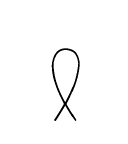

OccID = 3293
Monument : Penmaât
Monument type : Mummy board
Localisation or provenance : Sheikh Abd el-Gurna
Period : Dynasty XXII
Reign(s) : Osorkon I - ?
Approximate date : 945 - 715
ExemplarID = 505 - statistical relevance rating : **
Colours used : green


OccID = 1609
Monument : Khonsou-Tefnakht E.586
Monument type : Coffin
Localisation or provenance : El Hibeh
Period : Dynasty XXVII
Reign(s) : ?
Approximate date : 525 - 404
ExemplarID = 506 - statistical relevance rating : *
Colours used : green


OccID = 2397
Monument : Rekhmire TT.100
Monument type : Private Tomb
Localisation or provenance : Sheikh Abd el-Gurna
Period : Dynasty XVIII
Reign(s) : Thutmose III - Amenhotep II
Approximate date : 1479 - 1400
ExemplarID = 508 - statistical relevance rating : ***
Colours used : white (or faded?)


OccID = 3831
Monument : Temple of Sety I - Abydos
Monument type : Temple
Localisation or provenance : Abydos
Period : Dynasty XIX
Reign(s) : Sety I
Approximate date : 1294 - 1279
ExemplarID = 509 - statistical relevance rating : ****
Colours used : green


OccID = 3706
Monument : Ramses V-VI KV.9
Monument type : Royal Tomb
Localisation or provenance : Valley of the Kings
Period : Dynasty XX
Reign(s) : Ramses V - VI
Approximate date : 1147 - 1136
ExemplarID = 523 - statistical relevance rating : **
Colours used : red, dot black


OccID = 2399
Monument : Rekhmire TT.100
Monument type : Private Tomb
Localisation or provenance : Sheikh Abd el-Gurna
Period : Dynasty XVIII
Reign(s) : Thutmose III - Amenhotep II
Approximate date : 1479 - 1400
ExemplarID = 524 - statistical relevance rating : ****
Colours used : rope green, legs red


OccID = 736
Monument : Iunu G4150
Monument type : Slab stela
Localisation or provenance : Giza
Period : Dynasty IV
Reign(s) : Khufu
Approximate date : 2589 - 2566
ExemplarID = 599 - statistical relevance rating : ****
Colours used : yellow, red outline


OccID = 1208
Monument : Horemheb KV.57
Monument type : Royal Tomb
Localisation or provenance : Valley of the Kings
Period : Dynasty XVIII
Reign(s) : Horemheb
Approximate date : 1323 - 1295
ExemplarID = 511 - statistical relevance rating : *
Colours used : papyrus green, binding yellow, fill white


OccID = 3734
Monument : Ramses V-VI KV.9
Monument type : Royal Tomb
Localisation or provenance : Valley of the Kings
Period : Dynasty XX
Reign(s) : Ramses V - VI
Approximate date : 1147 - 1136
ExemplarID = 512 - statistical relevance rating : **
Colours used : red, fill yellow


OccID = 2102
Monument : Ramses I KV.16
Monument type : Royal Tomb
Localisation or provenance : Valley of the Kings
Period : Dynasty XIX
Reign(s) : Ramses I
Approximate date : 1295 - 1294
ExemplarID = 513 - statistical relevance rating : *
Colours used : serpent yellow with back and features black, hobble red, fill white


OccID = 131
Monument : Haremheb TT.78
Monument type : Private Tomb
Localisation or provenance : Sheikh Abd el-Gurna
Period : Dynasty XVIII
Reign(s) : Thutmose III - Amenhotep III
Approximate date : 1479 - 1352
ExemplarID = 514 - statistical relevance rating : *****
Colours used : whip green, ties yellow


OccID = 168
Monument : Wepemnefret G1201
Monument type : Slab stela
Localisation or provenance : Giza
Period : Dynasty IV
Reign(s) : Khufu
Approximate date : 2589 - 2566
ExemplarID = 515 - statistical relevance rating : ****
Colours used : yellow


OccID = 2402
Monument : Rekhmire TT.100
Monument type : Private Tomb
Localisation or provenance : Sheikh Abd el-Gurna
Period : Dynasty XVIII
Reign(s) : Thutmose III - Amenhotep II
Approximate date : 1479 - 1400
ExemplarID = 516 - statistical relevance rating : ***
Colours used : stick red, cord yellow


OccID = 2403
Monument : Rekhmire TT.100
Monument type : Private Tomb
Localisation or provenance : Sheikh Abd el-Gurna
Period : Dynasty XVIII
Reign(s) : Thutmose III - Amenhotep II
Approximate date : 1479 - 1400
ExemplarID = 517 - statistical relevance rating : **
Colours used : spindle red, thread white
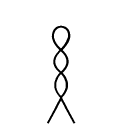

OccID = 2841
Monument : Nakht-Min TT.87
Monument type : Private Tomb
Localisation or provenance : Sheikh Abd el-Gurna
Period : Dynasty XVIII
Reign(s) : Thutmose III
Approximate date : 1479 - 1425
ExemplarID = 518 - statistical relevance rating : *****
Colours used : green


OccID = 3008
Monument : Userhat TT.56 yellow background
Monument type : Private Tomb
Localisation or provenance : Sheikh Abd el-Gurna
Period : Dynasty XVIII
Reign(s) : Amenhotep II
Approximate date : 1427 - 1400
ExemplarID = 519 - statistical relevance rating : ****
Colours used : green


OccID = 3205
Monument : Penmaât
Monument type : Mummy board
Localisation or provenance : Sheikh Abd el-Gurna
Period : Dynasty XXII
Reign(s) : Osorkon I - ?
Approximate date : 945 - 715
ExemplarID = 520 - statistical relevance rating : *
Colours used : swab outline red, basket green with outline blue and handle red


OccID = 1237
Monument : Horemheb KV.57
Monument type : Royal Tomb
Localisation or provenance : Valley of the Kings
Period : Dynasty XVIII
Reign(s) : Horemheb
Approximate date : 1323 - 1295
ExemplarID = 521 - statistical relevance rating : *****
Colours used : green with black cross-hatching


OccID = 1210
Monument : Horemheb KV.57
Monument type : Royal Tomb
Localisation or provenance : Valley of the Kings
Period : Dynasty XVIII
Reign(s) : Horemheb
Approximate date : 1323 - 1295
ExemplarID = 522 - statistical relevance rating : *****
Colours used : green with black cross-hatching, black handle with white fill


OccID = 509
Monument : Benia TT.343
Monument type : Private Tomb
Localisation or provenance : Sheikh Abd el-Gurna
Period : Dynasty XVIII
Reign(s) : Hatshepsut - Amenhotep II
Approximate date : 1473 - 1400
ExemplarID = 525 - statistical relevance rating : *
Colours used : basket green, handle red
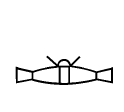

OccID = 3349
Monument : Sarenput II
Monument type : Private Tomb
Localisation or provenance : Elephantine
Period : Dynasty XII
Reign(s) : Amenemhat II
Approximate date : 1911 - 1877
ExemplarID = 530 - statistical relevance rating : *
Colours used : blue, bands (faded) yellow


OccID = 1597
Monument : Khonsou-Tefnakht E.586
Monument type : Coffin
Localisation or provenance : El Hibeh
Period : Dynasty XXVII
Reign(s) : ?
Approximate date : 525 - 404
ExemplarID = 600 - statistical relevance rating : **
Colours used : yellow, blue outline


OccID = 1883
Monument : Peftjauneith
Monument type : Coffin
Localisation or provenance : Sais
Period : Dynasty XXVI
Reign(s) : ?
Approximate date : 664 - 525
ExemplarID = 602 - statistical relevance rating : **
Colours used : yellow with black lines and red lashing
This group contains twenty-six signs, plus three additional variants, of which twenty-five (86%) have database occurrences, all with images.
The distinction between stone and earthenware is obvious from the colours used. Stone, particularly alabaster, is coloured white with yellow or red markings, generally chevrons surrounding a lozenge. This can be seen clearly in the basin W3. Earthenware, however, is most often red or red with blue or black. This contrast between earthenware and stone can be seen in the pot or bowl W10 which can be red or white, depending on the material used.
An unusual use of green is found on the Dynasty XXVII Mon.31 inscription. The stone jar W1 is green instead of the canonical white and yellow. The reason for this is unclear. However, a Dynasty III occurrence (Mon.21) also uses green, this time with black speckles. So, some kind of green stone could be intended. Green could also have been used to indicate the contents of the jar, in this case oil.
Most of the vessels in group W are earthenware pots, jugs and jars. They are generally red or a combination of red base and blue or black top or else blue or black base and red top. The red base with a blue or black top is much like the pre-dynastic Naqadan black-topped ware. This was produced by first firing iron-rich clay in an oxidising atmosphere - a process that produces the red ceramics. The pot was then probably inverted in sawdust while still hot, in order to draw oxygen away from the iron, leaving the black colour. The exact process used is unknown (Bourriau et al. 2000, 128).
Many of these signs for ceramic vessels show the black- or blue-topped variety, but not always with red base and black top but inverted instead, with a black base and a red top. It is unclear whether this was due to a lack of first-hand knowledge of these early pots or else was a deliberate aesthetic choice, perhaps dictated by the later use of decorated ware. It could also be an example of the vessel and its contents, where the blue or black liquid lies naturally in the lower part of the pot. Examples of this reversal of colours can be found for almost all of the group W earthenware pots (e.g. W9, W14, W15, W16, W17, W18, W21, W22, W23 and W24).


OccID = 1583
Monument : Khonsou-Tefnakht E.586
Monument type : Coffin
Localisation or provenance : El Hibeh
Period : Dynasty XXVII
Reign(s) : ?
Approximate date : 525 - 404
ExemplarID = 526 - statistical relevance rating : ***
Colours used : jar green, seal red, tie green


OccID = 163
Monument : Wepemnefret G1201
Monument type : Slab stela
Localisation or provenance : Giza
Period : Dynasty IV
Reign(s) : Khufu
Approximate date : 2589 - 2566
ExemplarID = 527 - statistical relevance rating : *
Colours used : outline red, fill white


OccID = 2405
Monument : Rekhmire TT.100
Monument type : Private Tomb
Localisation or provenance : Sheikh Abd el-Gurna
Period : Dynasty XVIII
Reign(s) : Thutmose III - Amenhotep II
Approximate date : 1479 - 1400
ExemplarID = 528 - statistical relevance rating : *****
Colours used : white with markings yellow


OccID = 3415
Monument : Deir el-Bahri
Monument type : Funerary temple
Localisation or provenance : Deir el-Bahri
Period : Dynasty XVIII
Reign(s) : Hatshepsut
Approximate date : 1473 - 1458
ExemplarID = 529 - statistical relevance rating : **
Colours used : column red, booth yellow, fill white, basin white with lozenge and chevrons yellow


OccID = 1354
Monument : Sarenput II
Monument type : Private Tomb
Localisation or provenance : Elephantine
Period : Dynasty XII
Reign(s) : Amenemhat II
Approximate date : 1911 - 1877
ExemplarID = 546 - statistical relevance rating : **
Colours used : upper red (or yellow?), lower white with diagonal red line


OccID = 3000
Monument : Userhat TT.56 yellow background
Monument type : Private Tomb
Localisation or provenance : Sheikh Abd el-Gurna
Period : Dynasty XVIII
Reign(s) : Amenhotep II
Approximate date : 1427 - 1400
ExemplarID = 531 - statistical relevance rating : **
Colours used : base red, top blue, handle faded


OccID = 3922
Monument : Rekhmire TT.100
Monument type : Private Tomb
Localisation or provenance : Sheikh Abd el-Gurna
Period : Dynasty XVIII
Reign(s) : Thutmose III - Amenhotep II
Approximate date : 1479 - 1400
ExemplarID = 532 - statistical relevance rating : ****
Colours used : red


OccID = 1285
Monument : Horemheb KV.57
Monument type : Royal Tomb
Localisation or provenance : Valley of the Kings
Period : Dynasty XVIII
Reign(s) : Horemheb
Approximate date : 1323 - 1295
ExemplarID = 533 - statistical relevance rating : ****
Colours used : white


OccID = 2079
Monument : Ramses I KV.16
Monument type : Royal Tomb
Localisation or provenance : Valley of the Kings
Period : Dynasty XIX
Reign(s) : Ramses I
Approximate date : 1295 - 1294
ExemplarID = 534 - statistical relevance rating : ****
Colours used : pot red, top black, triangle white


OccID = 2287
Monument : Rekhmire TT.100
Monument type : Private Tomb
Localisation or provenance : Sheikh Abd el-Gurna
Period : Dynasty XVIII
Reign(s) : Thutmose III - Amenhotep II
Approximate date : 1479 - 1400
ExemplarID = 535 - statistical relevance rating : *****
Colours used : stand red, triangle white, top blue


OccID = 2491
Monument : Menna TT.69
Monument type : Private Tomb
Localisation or provenance : Sheikh Abd el-Gurna
Period : Dynasty XVIII
Reign(s) : Thutmose IV
Approximate date : 1400 - 1390
ExemplarID = 536 - statistical relevance rating : **
Colours used : red


OccID = 1450
Monument : Sobekhotep TT.63
Monument type : Private Tomb
Localisation or provenance : Sheikh Abd el-Gurna
Period : Dynasty XVIII
Reign(s) : Thutmose IV
Approximate date : 1400 - 1390
ExemplarID = 537 - statistical relevance rating : ****
Colours used : lower part red, upper blue


OccID = 3291
Monument : Penmaât
Monument type : Mummy board
Localisation or provenance : Sheikh Abd el-Gurna
Period : Dynasty XXII
Reign(s) : Osorkon I - ?
Approximate date : 945 - 715
ExemplarID = 538 - statistical relevance rating : ****
Colours used : jar base red, upper blue, liquid blue


OccID = 3457
Monument : Nefret-iabet G1225
Monument type : Slab stela
Localisation or provenance : Giza
Period : Dynasty IV
Reign(s) : Khufu
Approximate date : 2589 - 2566
ExemplarID = 539 - statistical relevance rating : **
Colours used : stand red, pot lower red, upper black, water faded


OccID = 3472
Monument : Amenhotep III KV.22
Monument type : Royal Tomb
Localisation or provenance : Valley of the Kings
Period : Dynasty XVIII
Reign(s) : Amenhotep III
Approximate date : 1390 - 1352
ExemplarID = 547 - statistical relevance rating : ****
Colours used : base of pots and lower rack blue, upper pots and rack red


OccID = 3562
Monument : Ramses IV KV.2
Monument type : Royal Tomb
Localisation or provenance : Valley of the Kings
Period : Dynasty XX
Reign(s) : Ramses IV
Approximate date : 1153 - 1147
ExemplarID = 548 - statistical relevance rating : **
Colours used : jars red, cord green, fill yellow


OccID = 1861
Monument : Peftjauneith
Monument type : Coffin
Localisation or provenance : Sais
Period : Dynasty XXVI
Reign(s) : ?
Approximate date : 664 - 525
ExemplarID = 541 - statistical relevance rating : ****
Colours used : pots lower blue, upper red, rack blue, fill white


OccID = 207
Monument : Wepemnefret G1201
Monument type : Slab stela
Localisation or provenance : Giza
Period : Dynasty IV
Reign(s) : Khufu
Approximate date : 2589 - 2566
ExemplarID = 542 - statistical relevance rating : **
Colours used : sides red, pots red with black tops, rack black, seals white with red outline


OccID = 3735
Monument : Ramses V-VI KV.9
Monument type : Royal Tomb
Localisation or provenance : Valley of the Kings
Period : Dynasty XX
Reign(s) : Ramses V - VI
Approximate date : 1147 - 1136
ExemplarID = 543 - statistical relevance rating : ****
Colours used : vertical strokes red, cord blue, fill yellow
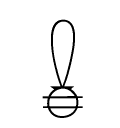

OccID = 2064
Monument : Ramses I KV.16
Monument type : Royal Tomb
Localisation or provenance : Valley of the Kings
Period : Dynasty XIX
Reign(s) : Ramses I
Approximate date : 1295 - 1294
ExemplarID = 544 - statistical relevance rating : ****
Colours used : pot red with centre section yellow, horizontal bands blue, rope yellow, fill white


OccID = 806
Monument : Iunu G4150
Monument type : Slab stela
Localisation or provenance : Giza
Period : Dynasty IV
Reign(s) : Khufu
Approximate date : 2589 - 2566
ExemplarID = 545 - statistical relevance rating : ****
Colours used : red pots with blue (or black?) tops, yellow lashings with red markings


OccID = 3456
Monument : Nefret-iabet G1225
Monument type : Slab stela
Localisation or provenance : Giza
Period : Dynasty IV
Reign(s) : Khufu
Approximate date : 2589 - 2566
ExemplarID = 549 - statistical relevance rating : ****
Colours used : lower red, upper black

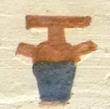
OccID = 2504
Monument : Nakht TT.52
Monument type : Private Tomb
Localisation or provenance : Sheikh Abd el-Gurna
Period : Dynasty XVIII
Reign(s) : Thutmose IV
Approximate date : 1400 - 1390
ExemplarID = 550 - statistical relevance rating : ****
Colours used : base blue, upper and handles red


OccID = 2515
Monument : Nakht TT.52
Monument type : Private Tomb
Localisation or provenance : Sheikh Abd el-Gurna
Period : Dynasty XVIII
Reign(s) : Thutmose IV
Approximate date : 1400 - 1390
ExemplarID = 552 - statistical relevance rating : ****
Colours used : blue


OccID = 3289
Monument : Penmaât
Monument type : Mummy board
Localisation or provenance : Sheikh Abd el-Gurna
Period : Dynasty XXII
Reign(s) : Osorkon I - ?
Approximate date : 945 - 715
ExemplarID = 551 - statistical relevance rating : ****
Colours used : lower half red, upper blue


OccID = 2503
Monument : Nakht TT.52
Monument type : Private Tomb
Localisation or provenance : Sheikh Abd el-Gurna
Period : Dynasty XVIII
Reign(s) : Thutmose IV
Approximate date : 1400 - 1390
ExemplarID = 553 - statistical relevance rating : *****
Colours used : bowl blue, legs red
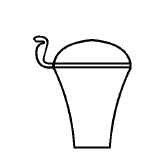

OccID = 1279
Monument : Horemheb KV.57
Monument type : Royal Tomb
Localisation or provenance : Valley of the Kings
Period : Dynasty XVIII
Reign(s) : Horemheb
Approximate date : 1323 - 1295
ExemplarID = 554 - statistical relevance rating : *
Colours used : red


OccID = 3870
Monument : Ta-ouseret-em-per-nesou (aka Unnefer).
Monument type : Coffin
Localisation or provenance : Bab el-Gasus
Period : Dynasty XXI
Reign(s) : ?
Approximate date : 1069 - 945
ExemplarID = 555 - statistical relevance rating : *
Colours used : pot blue, liquid red
This small group contains only eight signs, of which seven (88%) have database occurrences, six of them with images.
This group has occurrences for the signs X2, X3, X4, X5 and X6 (no image), all of which generally possess colouring consistent with loaves of bread (white or pale yellow). Some, such as X3 and X4 have bakers’ marks, indentations made with the fingers, such as can be found in many cultures today. That these signs depict loaves is a certainty. However, there are two signs that pose problems of identification. These are the semi-circular X1 and the conical X8.
X1 is the most frequently encountered sign in the monuments studied here. Fifty-one out of a total of fifty-two monuments (98%) possess occurrences. And yet it remains one of the most enigmatic hieroglyphs. The question is why, if X1 represents a loaf, is it consistently coloured black or blue? These are colours used to represent the Nile flood, alluvium, mud-brick, hard stone, night, darkness, the underworld etc. but not, it would seem from the signs X2 - X6, bread. Takács (1996) sees a relationship, supported by many Afro-Asian cognates, between the verb tA “to bake, be hot, burn” (Wb V, 229) and the substantive t “bread”. This would fit the colour of X1 but would still not explain why X2-X6 are coloured differently. Tiradritti (2008, 6) proposes to see in X1 the representation of the primeval mound of earth that rose from the Nun at the Creation. This is a clear possibility as blue-black is the colour used to represent the fertile land that borders the Nile. The sign can also be found in some composite hieroglyphs such as the temple enclosure O7 or the symbol of the West R13. In the case of O7, temples were supposedly built on the symbolic primeval mound. This would explain the X1 sign in the centre of the enclosure. The same symbolism could apply to R13 where the feather, which represents the Horus falcon, rises from the same mound. This explanation does not preclude the fact that a rounded loaf of bread could be named after this mound, in just the same way that we give our own “nick-names” to different kinds of bread. A direct example is the Belgian small, rounded loaf, exactly like X1, which is known in French as a “pistolet” (“pistol”).
X8 is also consistently black or blue, often with a white fill in the triangles. What this object represents is open to speculation. It obviously has something to do with offering or giving (Wb V, 419) but whether it represents an actual loaf is debatable. Conical bread-moulds did exist but the rigid formality of the two triangles is far from the reality of the roughly rounded point of surviving examples (Delwen 2000, 567). X8 could possibly represent a “funerary cone” (LÄ II, 857-859). These were much more geometrically precise than the bread-moulds but were made of white or red clay, unlike the blue used for the hieroglyph. It should also be noted that neither X1 nor X8 is represented as bread on offering tables in funerary scenes. Their precise identification and the explanation of their colours remains a mystery.


OccID = 3432
Monument : Wepemnefret G1201
Monument type : Slab stela
Localisation or provenance : Giza
Period : Dynasty IV
Reign(s) : Khufu
Approximate date : 2589 - 2566
ExemplarID = 556 - statistical relevance rating : *****
Colours used : black


OccID = 2882
Monument : Userhat TT.56
Monument type : Private Tomb
Localisation or provenance : Sheikh Abd el-Gurna
Period : Dynasty XVIII
Reign(s) : Amenhotep II
Approximate date : 1427 - 1400
ExemplarID = 557 - statistical relevance rating : ****
Colours used : pot red, loaf white with top yellow


OccID = 1560
Monument : Khonsou-Tefnakht E.586
Monument type : Coffin
Localisation or provenance : El Hibeh
Period : Dynasty XXVII
Reign(s) : ?
Approximate date : 525 - 404
ExemplarID = 565 - statistical relevance rating : **
Colours used : yellow with blue markings


OccID = 1539
Monument : Khonsou-Tefnakht E.586
Monument type : Coffin
Localisation or provenance : El Hibeh
Period : Dynasty XXVII
Reign(s) : ?
Approximate date : 525 - 404
ExemplarID = 560 - statistical relevance rating : ****
Colours used : yellow with blue markings


OccID = 3282
Monument : Penmaât
Monument type : Mummy board
Localisation or provenance : Sheikh Abd el-Gurna
Period : Dynasty XXII
Reign(s) : Osorkon I - ?
Approximate date : 945 - 715
ExemplarID = 561 - statistical relevance rating : *
Colours used : green


OccID = 3481
Monument : Amenhotep III KV.22
Monument type : Royal Tomb
Localisation or provenance : Valley of the Kings
Period : Dynasty XVIII
Reign(s) : Amenhotep III
Approximate date : 1390 - 1352
ExemplarID = 562 - statistical relevance rating : *****
Colours used : dark blue, fill white
This small group contains only eight signs, of which five (63%) have database occurrences, all of them with images. These five signs are Y1, Y2, Y3, Y4 and Y5. None of the signs for musical instruments is recorded in the database.
The papyrus rolls Y1 and Y2 are mostly white with red binding. Sometimes a central blue seal is present.
The scribe’s equipment Y3 (Y4 is simply Y3 reversed) is variable in its polychromy, depending upon the materials used in its manufacture - metal, wood, leather, pottery etc. However, all variants are recognisable as figurative images (Tiradritti 2008, 59-61; LÄ IV, 656-658).
The board game Y5 is always red, showing it to have been made of wood. It varies in its details (number of pawns, number of rows, number of squares) and in the colour of the pawns (blue or green). However, all the variants appear to represent the same board game - “senet” (OEAE II, 2-3). Many surviving examples show the same variations but all have the same basic form.


OccID = 2452
Monument : Menna TT.69
Monument type : Private Tomb
Localisation or provenance : Sheikh Abd el-Gurna
Period : Dynasty XVIII
Reign(s) : Thutmose IV
Approximate date : 1400 - 1390
ExemplarID = 563 - statistical relevance rating : *****
Colours used : roll white, lashings red, seal blue (?)


OccID = 3433
Monument : Wepemnefret G1201
Monument type : Slab stela
Localisation or provenance : Giza
Period : Dynasty IV
Reign(s) : Khufu
Approximate date : 2589 - 2566
ExemplarID = 564 - statistical relevance rating : ****
Colours used : roll white, string red, seal black


OccID = 2518
Monument : Nakht TT.52
Monument type : Private Tomb
Localisation or provenance : Sheikh Abd el-Gurna
Period : Dynasty XVIII
Reign(s) : Thutmose IV
Approximate date : 1400 - 1390
ExemplarID = 566 - statistical relevance rating : ****
Colours used : reed holder and pot blue, reeds and rope red, palette yellow, inkwell red (only one visible)


OccID = 2753
Monument : Menkheper TT.79
Monument type : Private Tomb
Localisation or provenance : Sheikh Abd el-Gurna
Period : Dynasty XVIII
Reign(s) : Thutmose III - Amenhotep II
Approximate date : 1479 - 1400
ExemplarID = 567 - statistical relevance rating : ****
Colours used : reed holder and pot blue, reed tip and string red, palette yellow


OccID = 2740
Monument : Menkheper TT.79
Monument type : Private Tomb
Localisation or provenance : Sheikh Abd el-Gurna
Period : Dynasty XVIII
Reign(s) : Thutmose III - Amenhotep II
Approximate date : 1479 - 1400
ExemplarID = 568 - statistical relevance rating : ****
Colours used : board red with white dots, pieces green
This group contains eleven signs, plus one additional sign, of which eight (67%) have database occurrences, all of them with images.
Z1, Z2, Z3 and Z4 are simply strokes, indicating number. As such, they have mostly been coloured black or occasionally red. This is similar to the use of black or red ink on papyrus.
Z7, the shorthand form of the quail chick G43, can be yellow, black or red. Yellow probably in imitation of the colour of G43, black or red in the same manner as for the other strokes.
The crossed sticks or planks Z9 and Z11 are almost always red, showing them to be pieces of wood.


OccID = 3929
Monument : Rekhmire TT.100
Monument type : Private Tomb
Localisation or provenance : Sheikh Abd el-Gurna
Period : Dynasty XVIII
Reign(s) : Thutmose III - Amenhotep II
Approximate date : 1479 - 1400
ExemplarID = 569 - statistical relevance rating : ****
Colours used : black


OccID = 3719
Monument : Ramses V-VI KV.9
Monument type : Royal Tomb
Localisation or provenance : Valley of the Kings
Period : Dynasty XX
Reign(s) : Ramses V - VI
Approximate date : 1147 - 1136
ExemplarID = 570 - statistical relevance rating : ****
Colours used : black
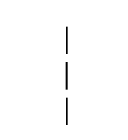

OccID = 1775
Monument : Tjanuni TT.74
Monument type : Private Tomb
Localisation or provenance : Sheikh Abd el-Gurna
Period : Dynasty XVIII
Reign(s) : Thutmose IV
Approximate date : 1400 - 1390
ExemplarID = 571 - statistical relevance rating : ****
Colours used : black


OccID = 3310
Monument : Penmaât
Monument type : Mummy board
Localisation or provenance : Sheikh Abd el-Gurna
Period : Dynasty XXII
Reign(s) : Osorkon I - ?
Approximate date : 945 - 715
ExemplarID = 572 - statistical relevance rating : ****
Colours used : black


OccID = 1426
Monument : Huy TT.54
Monument type : Private Tomb
Localisation or provenance : Sheikh Abd el-Gurna
Period : Dynasty XVIII
Reign(s) : Thutmose IV - Amenhotep III
Approximate date : 1400 - 1352
ExemplarID = 573 - statistical relevance rating : **
Colours used : yellow with red outline


OccID = 2411
Monument : Rekhmire TT.100
Monument type : Private Tomb
Localisation or provenance : Sheikh Abd el-Gurna
Period : Dynasty XVIII
Reign(s) : Thutmose III - Amenhotep II
Approximate date : 1479 - 1400
ExemplarID = 575 - statistical relevance rating : ****
Colours used : red


OccID = 3312
Monument : Penmaât
Monument type : Mummy board
Localisation or provenance : Sheikh Abd el-Gurna
Period : Dynasty XXII
Reign(s) : Osorkon I - ?
Approximate date : 945 - 715
ExemplarID = 576 - statistical relevance rating : *****
Colours used : red


OccID = 1782
Monument : Tjanuni TT.74
Monument type : Private Tomb
Localisation or provenance : Sheikh Abd el-Gurna
Period : Dynasty XVIII
Reign(s) : Thutmose IV
Approximate date : 1400 - 1390
ExemplarID = 577 - statistical relevance rating : *
Colours used : black
This group contains twenty-eight signs of which nineteen (68%) have database occurrences, thirteen of them with images. The group includes doubtful identifications and signs which are difficult to categorise in other groups.
The most frequent, with forty-seven occurrences, and also one of the most intriguing signs in this group is Aa1, tentatively described by Gardiner as a “human placenta?”. This identification is based on an article by Blackman (1916), which is no longer a convincing hypothesis as it is itself based on a limited amount of data (Blackman 1916, 237) and ignores the importance of colour as a means of identification. The sign, which has the phonetic value of x, according to some authors also serves to write the word x “placenta?” (FCD 182 after EG 539; Bonnamy and Sadek 2010, 447). However, this reading appears to be contentious as neither the Wörterbuch (Wb III, 217, 1-3), nor Hannig (2006, 621) gives this acception. Moreover, the canonical colour of green, often with a black outer ring and horizontal stripes seems to rule out this identification. Green is the colour of fresh vegetation and growth and could perhaps be associated with a placenta through this metaphorical symbolism. However, human body parts are usually painted red in an attempt at naturalistic colouring (see Group D) and it would be surprising if the natural red of the placenta were represented by yellow (early Old Kingdom) or green (Dynasty V onwards) (see Diachrony).
Another meaning of x is “child” (FCD 182; Wb III, 217, 3; Hannig 2006, 621). I have already shown (see Diachrony) that Aa1 is almost certainly an object made from cane- or rush-work basketry. Some authors see this sign as a sieve, which is certainly a possibility (e.g. GREC 539; Bonnamy and Sadek 2010, 884). The connection between a sieve and a placenta is not an impossible construct but remains pure speculation. The Aa1 entry in the sign-list in Malaise and Winand (GREC 539) comes close to an identification as a “crible ou couvercle fait de matières végétales”. In fact, this object could be the basket V30 or its cover, seen from above : an object that recalls the mythological topos of the child, abandoned and rediscovered (i.e. reborn) floating in a basket on the river. This topos is found in several Ancient Near Eastern traditions such as Hittite (“A Tale of Two Cities : Kanesh and Zalpa” (Singer 1995, 124)), Akkadian (“The Legend of Sargon” (ANET 119)) and Biblical (“The birth of Moses” (Exodus 2:2-6)). The Egyptian myth is similar, with the child Horus hidden by his mother in the papyrus marshes until he is strong enough to challenge Seth (Plutarch “De Iside et Osiride” 357F). There is even a link between the basket and the notions of birth and rebirth through the name of Moses : Egyptian ms(w) meaning “to be born” (Wb II, 137, 11). The colour of the hieroglyph thus appears to work on two levels : first as the natural green of a woven basket and secondly as a metaphor for (re)birth, youth and growth.
Aa2 is described by Gardiner as “a pustule or gland?” based on its use in medical texts (EG 539). However, it is unclear exactly what is intended by this sign. It is obviously something unpleasant, when we consider the different words it determines: “disease, odour, excrement” (EG 539). The exemplar shown is plain white, which would suggest a bandage, one of the words cited by Gardiner (wt). The sign also has connections with embalming and could thus represent one of the wrapped organs removed from the body. It could also be some kind of linen compress, applied to a wound. Variants can be yellow or red. Yellow could also represent a bandage but red would suggest a body part or a bloodied compress.
Aa5 is described as “part of the steering gear of ships?”. This is possible as the exemplar shown here is red, indicating a wooden object. A Dynasty VI variant is green. Gardiner mentions that the object may be made from rushes bound together, which corresponds to this colour. However, it is difficult to see how rushes would be strong enough to be used in steering gear.
Aa8 shows “irrigation runnels”. This sign is often confused with several others, even in modern transcriptions (EG 540-541). These signs are N24, V26 and O34. Aa8 is either all blue, representing water, or blue with the three vertical lines in red. This could indicate that the perpendicular channels are seasonally dry, unwatered desert.
The plinth Aa11 is a common sign that is often encountered in scenes that show a statue on a plinth or especially in scenes showing Osiris seated on his throne (e.g. Tiradritti 2008, 286). The colour blue is compatible with both of these depictions, either as a stone base for a statue or as an underworld metaphor such as for the sign showing the seat Q1. The use of red is more problematic. If Aa11 does represent a plinth, wood is an unlikely material. Therefore, either this is a misinterpretation of the object, or red is used in some unusual, metaphorical manner.
Aa13 and Aa15 are not always easily distinguishable, but both have the same basic shape and generally the same red colour. Aa14 however, an Old Kingdom version of Aa13, can be yellow, blue or green. The reason is unclear. Aa13-Aa15 are semantically linked to a part of the body (imw) or the side (gs) and the colour red would support this view. The description of “two ribs of an oryx” has been suggested, but even Gardiner doubts this (EG 542).
Aa18 is identified by Gardiner as a Dyn. XII - Dyn. XVIII version of Aa17 which he describes as“the back of something”, based only on the phonetic value of the sign - sA, meaning “back”. The polychromy used here would suggest an object made from wooden slats, with a handle attached. This could be a box with a lid or a door of some kind.
Aa19 has been described as a hobble for cattle, as in V19-V21 (Bonnamy and Sadek 2010, 885), but V20 and V21 are red in the database. It is difficult to interpret this similar sign, either through its phonetic value (Hr) or through its use as a determinative (Wb V, 355-356). The colour black is often used for numerals, so this could be the result of confusion with V20, the sign for "10". This is certainly the case here as the context is that of a numeral.
Aa21 is described by Gardiner as “a carpenter’s tool?”. It certainly shows an object made of wood, as it is coloured red, with what looks like two parts that slide or slot together. A carpenter’s tool (some kind of vice?) is a possibility. Jonkheere (1954, 154-155), rather fancifully identifies it as a human castration device, based largely on the evidence of post-mortem removal of the penis and testicles as seen in the battle scenes at Medinet Habu. For this macabre practice, I would have thought that a sharp knife would have done the job far more efficiently. I believe that this implement is in fact a wooden sluice-gate, used for regulating the flow of flood water through irrigation channels (Pregill and Volkman 1999, 64-65; Butzer 1976, 47). A sluice-gate would also have provided the ideal perch for a heron from which to spy its prey, exactly as seen in the sign G32. The sign Aa21 is an ideogram for the word wDa, one of the meanings of which is “to open (a door)” (FCD 75; Wb I, 404: “Synonym zu wp”). The value of the composite sign G32 is baH which means “to flood, to flow, inundated land” (FCD 81; Wb I, 448). The semantic evidence is compelling. The visual evidence, including that of the polychromy, lends further weight to the identification. I would suggest, therefore, that this sign Aa21 be reclassified in Group U which contains the agricultural tools and be renamed as “a wooden sluice-gate”. The similar sign O30, when inverted, was also reclassified by Gardiner between U12 and U13 (EG 517) where it is named “a pitchfork”. Gardiner himself doubts this identification as the sign is used as a determinative in the word sDb meaning “impediment” or “obstacle” (FCD 258). This could suggest the forked stick as being the mechanism in a sluice-gate that controls the passage of water as an “obstacle” or “impediment” to the flow.

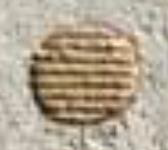
OccID = 3455
Monument : Nefret-iabet G1225
Monument type : Slab stela
Localisation or provenance : Giza
Period : Dynasty IV
Reign(s) : Khufu
Approximate date : 2589 - 2566
ExemplarID = 578 - statistical relevance rating : ****
Colours used : yellow with red lines


OccID = 1358
Monument : Sarenput II
Monument type : Private Tomb
Localisation or provenance : Elephantine
Period : Dynasty XII
Reign(s) : Amenemhat II
Approximate date : 1911 - 1877
ExemplarID = 579 - statistical relevance rating : ****
Colours used : green with black lines


OccID = 1228
Monument : Horemheb KV.57
Monument type : Royal Tomb
Localisation or provenance : Valley of the Kings
Period : Dynasty XVIII
Reign(s) : Horemheb
Approximate date : 1323 - 1295
ExemplarID = 21 - statistical relevance rating : ****
Colours used : green


OccID = 1359
Monument : Sarenput II
Monument type : Private Tomb
Localisation or provenance : Elephantine
Period : Dynasty XII
Reign(s) : Amenemhat II
Approximate date : 1911 - 1877
ExemplarID = 603 - statistical relevance rating : **
Colours used : white


OccID = 3739
Monument : Ay KV.23
Monument type : Royal Tomb
Localisation or provenance : Valley of the Kings
Period : Dynasty XVIII
Reign(s) : Ay
Approximate date : 1327 - 1323
ExemplarID = 581 - statistical relevance rating : **
Colours used : red


OccID = 2486
Monument : Menna TT.69
Monument type : Private Tomb
Localisation or provenance : Sheikh Abd el-Gurna
Period : Dynasty XVIII
Reign(s) : Thutmose IV
Approximate date : 1400 - 1390
ExemplarID = 593 - statistical relevance rating : **
Colours used : verticals red, horizontals blue (smudged)


OccID = 1820
Monument : Peftjauneith
Monument type : Coffin
Localisation or provenance : Sais
Period : Dynasty XXVI
Reign(s) : ?
Approximate date : 664 - 525
ExemplarID = 592 - statistical relevance rating : ****
Colours used : blue


OccID = 2862
Monument : Paroy TT.295
Monument type : Private Tomb
Localisation or provenance : Khokha
Period : Dynasty XVIII
Reign(s) : Thutmose IV - Amenhotep III
Approximate date : 1400 - 1352
ExemplarID = 584 - statistical relevance rating : ****
Colours used : red


OccID = 154
Monument : Haremheb TT.78
Monument type : Private Tomb
Localisation or provenance : Sheikh Abd el-Gurna
Period : Dynasty XVIII
Reign(s) : Thutmose III - Amenhotep III
Approximate date : 1479 - 1352
ExemplarID = 591 - statistical relevance rating : ****
Colours used : ribs red, fill white


OccID = 629
Monument : Ankhmerire
Monument type : Mastaba
Localisation or provenance : Saqqara
Period : Dynasty VI
Reign(s) : Pepy I
Approximate date : 2321 - 2287
ExemplarID = 585 - statistical relevance rating : **
Colours used : yellow


OccID = 2732
Monument : Menkheper TT.79
Monument type : Private Tomb
Localisation or provenance : Sheikh Abd el-Gurna
Period : Dynasty XVIII
Reign(s) : Thutmose III - Amenhotep II
Approximate date : 1479 - 1400
ExemplarID = 586 - statistical relevance rating : *****
Colours used : red


OccID = 3315
Monument : Penmaât
Monument type : Mummy board
Localisation or provenance : Sheikh Abd el-Gurna
Period : Dynasty XXII
Reign(s) : Osorkon I - ?
Approximate date : 945 - 715
ExemplarID = 587 - statistical relevance rating : *
Colours used : green
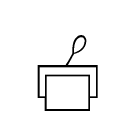

OccID = 2416
Monument : Rekhmire TT.100
Monument type : Private Tomb
Localisation or provenance : Sheikh Abd el-Gurna
Period : Dynasty XVIII
Reign(s) : Thutmose III - Amenhotep II
Approximate date : 1479 - 1400
ExemplarID = 588 - statistical relevance rating : *
Colours used : yellow, markings red
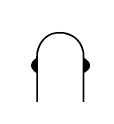

OccID = 3707
Monument : Ramses V-VI KV.9
Monument type : Royal Tomb
Localisation or provenance : Valley of the Kings
Period : Dynasty XX
Reign(s) : Ramses V - VI
Approximate date : 1147 - 1136
ExemplarID = 589 - statistical relevance rating : *
Colours used : black


OccID = 2417
Monument : Rekhmire TT.100
Monument type : Private Tomb
Localisation or provenance : Sheikh Abd el-Gurna
Period : Dynasty XVIII
Reign(s) : Thutmose III - Amenhotep II
Approximate date : 1479 - 1400
ExemplarID = 149 - statistical relevance rating : ***
Colours used : red


OccID = 3115
Monument : Temple of Ramses II (Abydos)
Monument type : Temple
Localisation or provenance : Abydos
Period : Dynasty XIX
Reign(s) : Ramses II
Approximate date : 1279 - 1213
ExemplarID = 590 - statistical relevance rating : ****
Colours used : red, centre white